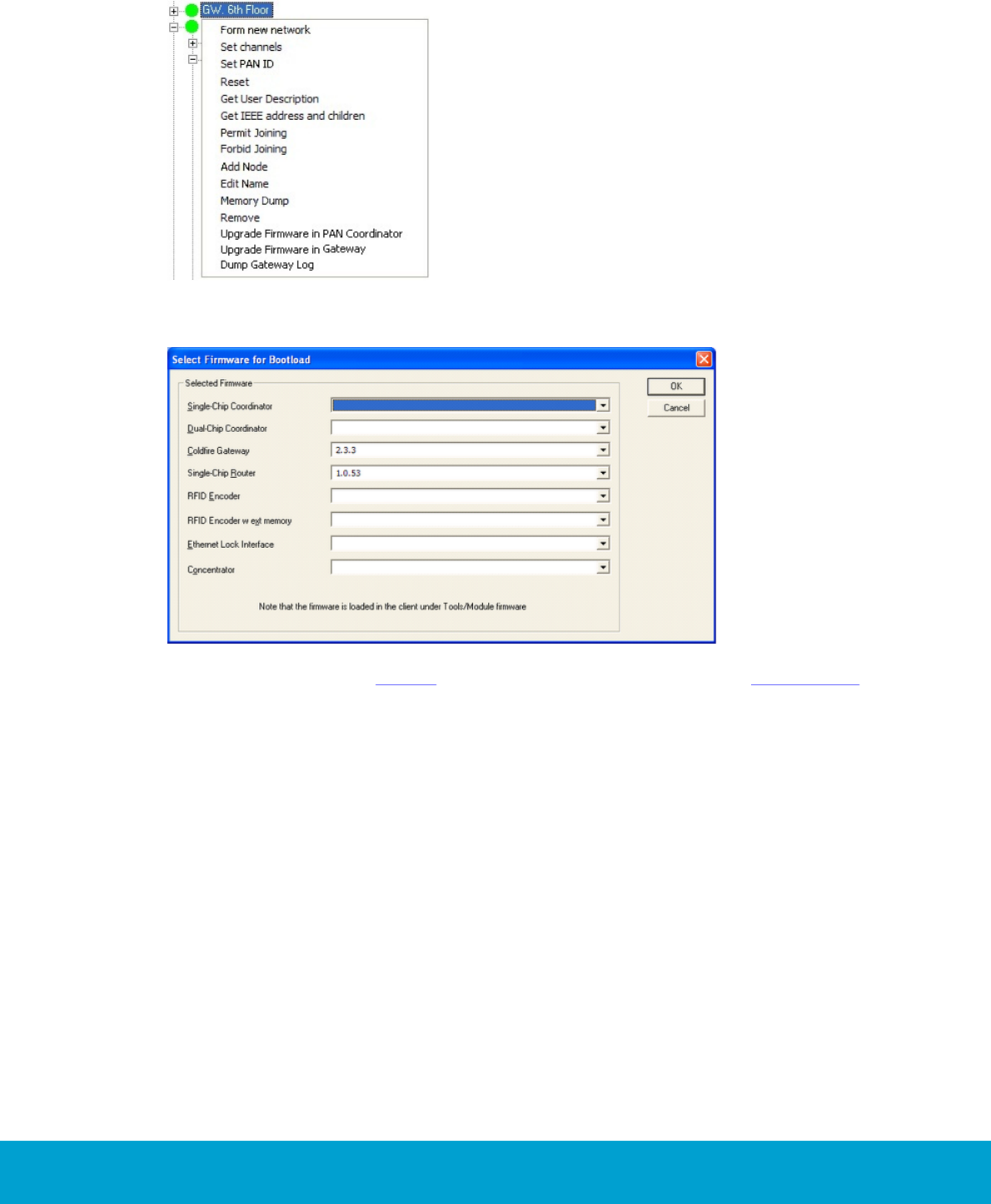ASSALOY Global Solutions Norway AS 683081067C1 Zigbee router User Manual Enter the help project title here
ASSA ABLOY Hospitality AS Zigbee router Enter the help project title here
Users Manual

1
ASSA ABLOY Hospitality
User Manual
Online Option

2
ASSA ABLOY Hospitality
Copyrights
The information in this document is subject to change at the sole discretion of
ASSA ABLOY without notice.
Any use, operation or repair in contravention of this document is at your own risk.
ASSA ABLOY does not assume any responsibility for incidental or consequential
damages arising from the use of this manual.
All information and drawings in this document are the property of ASSA ABLOY.
Unauthorized use and reproduction is prohibited.
VingCard and Elsafe are registered trademarks of ASSA ABLOY.

3
ASSA ABLOY Hospitality
Table of contents
.................................................................................................6 FCC and IC statements
........................................................................................................................ 6FCC statements
........................................................................................................................ 7IC statements
................................................................................................................................................ 7
OEM responsibilities
................................................................................................................................................ 8
End product labeling
.................................................................................................9 1. Introduction
........................................................................................................................ 101.1 ZigBee standard
........................................................................................................................ 101.2 Server
........................................................................................................................ 101.3 Gateway
................................................................................................................................................ 11
1.3.1 Without DHCP server
........................................................................................................................ 121.4 Router
........................................................................................................................ 121.5 Endnode
........................................................................................................................ 121.6 Lock
........................................................................................................................ 121.7 Permit joining/Forbid joining
........................................................................................................................ 131.8 Discovery
........................................................................................................................ 131.9 Orphan join
........................................................................................................................ 131.10 SysMon and the client
........................................................................................................................ 151.11 Link quality
........................................................................................................................ 151.12 Abbreviations
.................................................................................................16 2. Installing the option
.................................................................................................17 3. Installing online devices
........................................................................................................................ 183.1 Installing a server
................................................................................................................................................ 18
3.1.1 TL Concentrator
....................................................................................................................................... 19
3.1.1.1 TL Concentrator setup
....................................................................................................................................... 19
3.1.1.2 TL Concentrator monitor
........................................................................................................................ 203.2 Installing a gateway
........................................................................................................................ 223.3 Adding routers to a gateway
........................................................................................................................ 253.4 Adding endnodes to a router
........................................................................................................................ 263.5 Using routers as repeaters
........................................................................................................................ 273.6 Adding locks to gateways
........................................................................................................................ 273.7 Forcing parents
........................................................................................................................ 283.8 Right-click menus in SysMon
................................................................................................................................................ 29
3.8.1 Right-click menu choices for GWs
................................................................................................................................................ 32
3.8.2 Right-click menu choices for RTs
................................................................................................................................................ 33
3.8.3 Right-click menu choices for ENs
.................................................................................................34 4. Online settings in the client

4
ASSA ABLOY Hospitality
........................................................................................................................ 344.1 Setting up door parameters in a hotel system
................................................................................................................................................ 34
4.1.1 Door ajar alarm
................................................................................................................................................ 35
4.1.2 Status
....................................................................................................................................... 35
4.1.2.1 Intruder status
....................................................................................................................................... 35
4.1.2.2 Offline status
................................................................................................................................................ 36
4.1.3 Miscellaneous
................................................................................................................................................ 37
4.1.4 Alarms
................................................................................................................................................ 38
4.1.5 Safes
........................................................................................................................ 384.2 Setting up door parameters in an access control system
........................................................................................................................ 394.3 Setting up operator templates in a hotel system
........................................................................................................................ 404.4 Setting up operator templates in an access control system
........................................................................................................................ 414.5 Preventing invalid staff card usage (only applicable for hotel systems)
.................................................................................................42 5. Issuing a ZigBee configuration card
.................................................................................................43 6. System operation
........................................................................................................................ 436.1 Events
................................................................................................................................................ 43
6.1.1 Acknowledge
................................................................................................................................................ 43
6.1.2 Retransmission
................................................................................................................................................ 43
6.1.3 Fallback
........................................................................................................................ 436.2 Online functionality
................................................................................................................................................ 44
6.2.1 Commands
....................................................................................................................................... 44
6.2.1.1 Buffered commands
................................................................................................................................................ 44
6.2.2 Alarm list
................................................................................................................................................ 45
6.2.3 Endnode list
................................................................................................................................................ 46
6.2.4 Router list
................................................................................................................................................ 47
6.2.5 Gateway list
........................................................................................................................ 476.3 Setting in construction mode
.................................................................................................48 7. Commissioning
........................................................................................................................ 487.1 Printing a status report
........................................................................................................................ 497.2 Pinging a door
........................................................................................................................ 507.3 Checking online status with card
.................................................................................................51 8. Power loss and hardware failure
........................................................................................................................ 518.1 Lock electronics
........................................................................................................................ 518.2 Endnode
........................................................................................................................ 528.3 Router
........................................................................................................................ 538.4 Gateway
........................................................................................................................ 538.5 Server
.................................................................................................54 9. Redundancy and recovery
........................................................................................................................ 549.1 Communication channel
................................................................................................................................................ 55
9.1.1 Automatic channel change
........................................................................................................................ 559.2 Recovery
................................................................................................................................................ 55
9.2.1 Polling

5
ASSA ABLOY Hospitality
................................................................................................................................................ 55
9.2.2 Fallback
.................................................................................................56 Appendix A: Online devices
........................................................................................................................ 56Gateway
........................................................................................................................ 57Router
.................................................................................................58 Appendix B: Mounting of gateway and router
.................................................................................................59 Appendix C: Example configurations
.................................................................................................61 Appendix D: Web interface for gateway
.................................................................................................62 Appendix E: Reset of gateway
.................................................................................................63 Appendix F: Gateway boot-up
.................................................................................................65 Appendix G: More about how the gateway finds the server
........................................................................................................................ 66Commissioning of gateways
................................................................................................................................................ 66
Single server - commissioning of gateways with DNS
................................................................................................................................................ 66
Multiple servers - commissioning of gateways with DNS
................................................................................................................................................ 67
Commissioning of gateways without DNS
........................................................................................................................ 67Switching to backup server
................................................................................................................................................ 67
Single server - switching to backup server with DNS
................................................................................................................................................ 67
Multiple servers - switching to backup server with DNS
................................................................................................................................................ 67
Switching to backup server without DNS
.................................................................................................68 Appendix H: Firmware upgrade

6
ASSA ABLOY Hospitality 66 3081 004-22
FCC and IC statements
FCC (Federal Communications Commission) statements
These devices comply with Part 15 of the FCC Rules. Operation is subject to the following
two conditions:
(1) these devices may not cause harmful interference, and
(2) these devices must accept any interference received, including interference that may
cause undesired operation.
Important note: To maintain compliance with FCC´s RF exposure guidelines, this equipment
should be installed and operated with minimum distance 20 cm between the radiator and your
body. Use only the supplied antenna.
This equipment complies with FCC radiation exposure limits set forth for an uncontrolled environment.
These transmitters must not be co-located or operating in conjunction with any other antennas
or transmitters.
Changes or modifications not expressly approved by the party responsible for compliance could
void the user's authority to operate the equipment.
Note: This equipment has been tested and found to comply with the limits for a Class B digital
device, pursuant to part 15 of the FCC Rules. These limits are designed to provide reasonable
protection against harmful interference in a residential installation. This equipment generates,
uses and can radiate radio frequency energy and, if not installed and used in accordance with
the instructions, may cause harmful interference to radio communications. However, there is
no guarantee that interference will not occur in a particular installation. If this equipment does
cause harmful interference to radio or television reception, which can be determined by turning
the equipment off and on, the user is encouraged to try to correct the interference by one or
more of the following measures:
- Reorient or relocate the receiving antenna.
- Increase the separation between the equipment and receiver.
- Connect the equipment into an outlet on a circuit different from that to which the
receiver is connected.
- Consult the dealer or an experienced radio/TV technician for help.
The concerned end product must be labeled to say 'Contains FCC ID: WYV-EN110'.
The concerned end product must be labeled to say 'Contains FCC ID: WYV-EN055'.
The concerned end product must be labeled to say 'FCC ID: Y7V-683081067C1'.
The concerned end product must be labeled to say 'Contains FCC ID: WYV-RT067'.
The concerned end product must be labeled to say 'FCC ID: Y7V-683081066C1'.
The concerned end product must be labeled to say 'FCC ID: Y7V-GW683081066'.

7
ASSA ABLOY Hospitality 66 3081 004-22
IC (Industry Canada) statements
These devices comply with Industry Canada licence-exempt RSS standard CAN ICES-3 (B)/NMB-3(B) B.
Operation is subject to the following two conditions:
(1) these devices may not cause interference, and
(2) these devices must accept any interference, including interference that may cause undesired
operation of the devices.
Les présents appareils sont conformes aux CNR d’Industrie Canada applicables aux appareils radio
exempts de licence. L’exploitation est autorisée aux deux conditions suivantes:
(1) les appareils ne doivent pas produire de brouillage, et
(2) l’utilisateur des appareils doit accepter tout brouillage radioélectrique subi,
même si le brouillage est susceptible d’en compromettre le fonctionnement.
Important note: To comply with Industry Canada RF radiation exposure limits for general population,
the antennas used for these transmitters must be installed such that a minimum separation distance
of 20 cm is maintained between the radiator (antenna) and all persons at all times and must not be
co-located or operating in conjunction with any other antenna or transmitter.
Under Industry Canada regulations, these radio transmitters may only operate using an antenna of a
type and maximum (or lesser) gain approved for the transmitter by Industry Canada. To reduce potential
radio interference to other users, the antenna type and its gain should be so chosen that the equivalent
isotropically radiated power (e.i.r.p.) is not more than that necessary for successful communication.
These radio transmitters IC8231A-EN110, IC8231A-EN055, IC9514A-683081067C1, IC8231A-RT067,
IC9514A-683081066C1 and IC9514A-683081066 have been approved by Industry Canada to operate
with the antenna types listed below with the maximum permissible gain and required antenna
impedance for each antenna type indicated. Antenna types not included in this list, having a gain
greater than the maximum gain indicated for that type, are strictly prohibited for use with these devices.
Name/Model
Gain
Impedance
Inverted F-antenna
3.0 dBi
50 ohm
The term "IC" before the equipment certification number only signifies that the Industry Canada
technical specifications were met.
Le terme "IC" devant le numéro de certification signifie seulement que les specifications techniques
Industrie Canada ont été respectées.
OEM responsibilities
The endnode module has been certified for integration into products only by OEM integrators under
the following conditions:
1. The antenna must be installed such that a minimum separation distance of 20cm is maintained
between the radiator (antenna) and all persons at all times.
2. The transmitter module must not be co-located or operating in conjunction with any other
antenna or transmitter.
As long as the two conditions above are met, further transmitter testing will not be required.
However, the OEM integrator is still responsible for testing their end-product for any additional
compliance requirements required with these modules installed (e.g., digital device emissions,
PC peripheral requirements, etc.).
Important note: In the event that these conditions can not be met (for certain configurations or
co-location with another transmitter), then Industry Canada certification is no longer considered valid
and the IC Certification Number can not be used on the final product. In these circumstances, the OEM
integrator will be responsible for re-evaluating the end products (including the transmitter) and obtaining
a separate Industry Canada authorization.

8
ASSA ABLOY Hospitality 66 3081 004-22
End product labeling
The endnode module is labeled with its own IC Certification Number. If the IC Certification Number is not
visible when a module is installed inside another device, then the outside of the device into which the module
is installed must also display a label referring to the enclosed module. In that case, the final end product
must be labeled in a visible area with the following:
'Contains IC: 8231A-EN110'
'Contains IC: 8231A-EN055'
The OEM of the respective module must only use the approved antenna listed above, which have been
certified with this module. The OEM integrator has to be aware not to provide information to the end user
regarding how to install or remove this RF module or change RF related parameters in the user’s manual
of the end products.
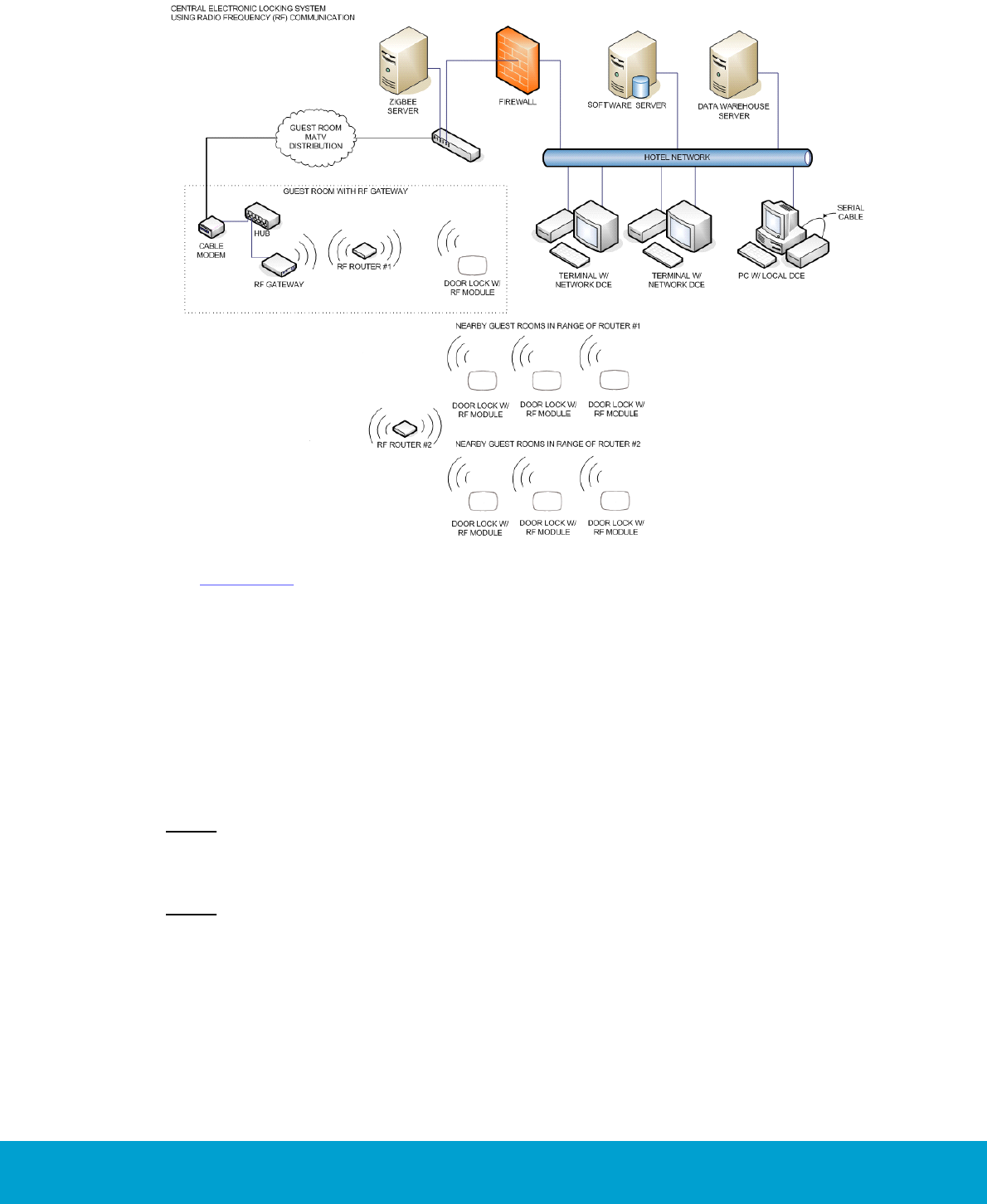
9
ASSA ABLOY Hospitality 66 3081 004-22
1. Introduction
Figure 1: Example of online configuration. Several other configurations are possible;
see Appendix C for some examples.
With the online option, the locks can both send and retrieve information. Commands
can be sent from the front desk (hotel systems)/company reception (access control
systems) to the lock. e.g., in hotel systems a guest can change rooms without
needing to go to the reception. Events are directly sent to the application server.
This chapter describes the online network topology all the way from the server to
the lock. Commands sent from the server to a lock will pass through the items in the
order they are mentioned. Answers will pass through the same items but in the
opposite direction.
Note: The most information in this manual is common for hotel systems and access
control systems. In some cases there are however specific sections, which is clearly
stated in the heading.
Note: Some online functions require the Online advanced option; see the section
about options in the client user manual for details.
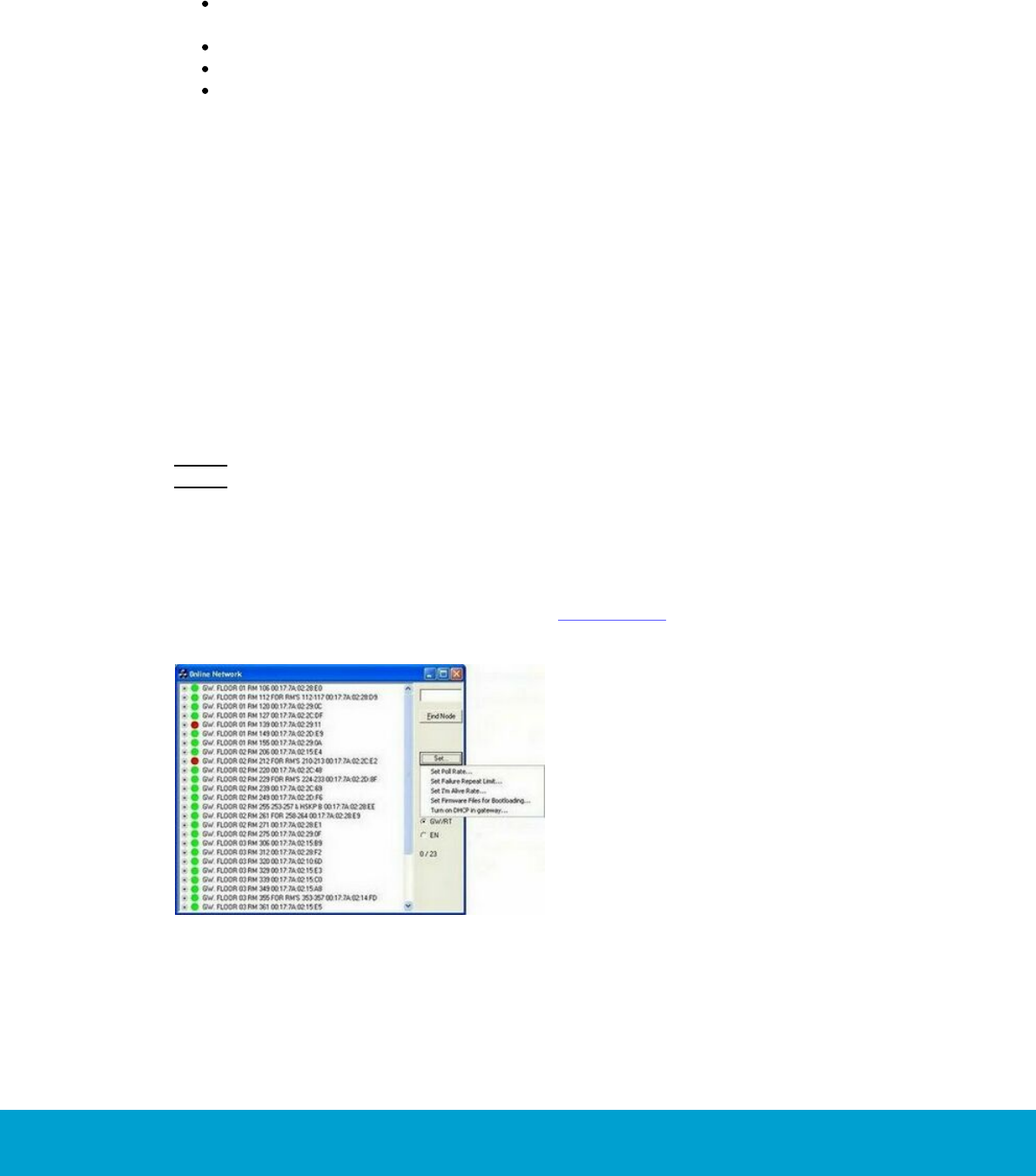
10
ASSA ABLOY Hospitality 66 3081 004-22
1.1 ZigBee standard
The online option is based on the ZigBee standard, a standard for transmission of
data via radio. The ZigBee devices have low power consumption and the standard is
aimed at control applications with relatively low data rate. Below are some basic facts
for the standard:
based on IEEE 802.15.4 (Open ISM 2.4GHz band; ISM = industrial, scientific
and medical)
16 channels spread spectrum (DSSS, Direct Sequence Spread Spectrum)
250kbit/s (~2kbit/s @ 1% duty-cycle)
consists of a virtually unlimited number of small networks (PANs, personal area
networks)
1.2 Server
The server is the manager of the whole network for a property. It can manage a
virtually unlimited number of gateways. All commands sent from the server are
encrypted.
1.3 Gateway
The gateways connect to the server via TCP/IP and automatically adjusts to
10 or 100 Mbit/s networks. The gateway starts by retrieving an IP address via
DHCP (Dynamic Host Configuration Protocol) and then automatically finds the server.
Note: The DHCP protocol is specified according to the standard RFC 2131.
Note: A ping is sent to each gateway once an hour. The statistics is evaluated once
a day. An alarm is triggered if more than one per cent of the pings fail. The statistics
is shown in the System Settings report in the client.
If DHCP has previously been turned off manually, it can be enabled again by clicking
the Set button in the Online Network dialog of SysMon (System Monitor) and
choosing Turn on DHCP in gateway. See section 1.10 for more information
about SysMon.
Figure 2

11
ASSA ABLOY Hospitality 66 3081 004-22
The dialog Enter MAC address will be shown; fill it in and click OK.
Figure 3
The gateway contains functionality for coordination of a PAN (Personal Area
Network). The PAN is a wireless network that communicates on the 2.4GHz band.
The gateway allows routers (see section 1.4) and endnodes (see section 1.5) to join
the PAN and assigns network addresses. Each ZigBee node has a unique 64-bit IEEE
address similar to Mac addresses used in TCP/IP.
The gateway chooses which of the 16 channels in the 2.4GHz band the nodes in
the PAN should use.
The gateway is powered either over Ethernet or by a power adapter.
The total number of gateways is virtually unlimited.
The maximum theoretical limit of endnodes per PAN is high, but a practical limit
is some hundred. In most cases, only some ten to 20 endnodes will be
connected to each gateway. However, this can change due to the building
construction, materialwise etc.
The gateway can have either five routers or 15 endnodes connected as direct
descendants.
See Appendix A for more information about the gateway, including a
detailed picture.
See Appendix B for preferred way of mounting the gateway.
See Appendix C for configuration examples.
1.3.1 Without DHCP server
1. The IP address on the gateway will change to an IP address in the range
169.254.1.0 – 169.254.254.255; this IP address range is based on the
zero config standard.
2. Have a web browser available, to reach a web interface where the gateway
parameters can be changed. Follow the steps below:
- Press the F button on the gateway for a short while (see in Appendix A where
the button is located). The status LED on top of the gateway will blink yellow.
- Use Wireshark to find out the zero config IP address of the gateway.
- Enter the zero config IP address in the web browser (http://ipaddress) to reach
the web interface (ZigBee Gateway Setup page) where the desired changes can
be made. Note: See Appendix D e.g. screenshot and more details about the web
interface. Note: For a reset to factory default values, press and hold the F button
while powering up the gateway.

12
ASSA ABLOY Hospitality 66 3081 004-22
1.4 Router
A router acts either as a repeater for range extension, or as a parent for endnodes.
It will also act as a buffer for messages sent to endnodes connected to the router.
Routers are externally powered.
The router can have either five routers or 15 endnodes connected as direct
descendants.
There can be a maximum of five hops down the gateway; i.e. gateway – router
– router – router – router – endnode. This limits the physical coverage of a
PAN. Important: Even though it is possible to have five hops, it is
recommended to have maximum three hops, i.e. gateway - router -
router - endnode. The link quality index (LQI) should be at least 30%.
See section 1.11 for more information about the LQI.
See Appendix A for more information about the router, including a detailed picture.
See Appendix B for preferred way of mounting the router.
See Appendix C for configuration examples.
1.5 Endnode
An endnode is built into each lock. It is optimized for low power consumption.
The parent router will act as a buffer for commands from the server. A command
sent from the server to a lock will be sent from the gateway to the lock’s parent
router. The command will be sent through the routers that may be located between
the gateway and the lock’s parent router. Any message sent from the lock will be
passed on to the server through the parent router, any intermediate routers and the
gateway. Messages from the lock are sent instantly. The total number of endnodes is
virtually unlimited.
1.6 Lock
The locks are the destination for commands and the source of events.
1.7 Permit joining/Forbid joining
In order to prevent nodes from joining randomly, 'permit joining' can for each PAN
only be made at one router or its 'parent gateway' at a time. When a node is to be
joined to the PAN, 'permit joining' must be made at the router or gateway that shall
be its parent. When the node has joined, 'forbid joining' should be made at the
parent. 'Forbid joining' will automatically be made on the parent after 15 minutes
in case it is forgotten. Note: It is only possible to make 'permit joining' at one RT
per PAN at a time. If you make 'permit joining' at one RT and then at another RT
in the same PAN, the first RT will automatically make 'forbid joining'.

13
ASSA ABLOY Hospitality 66 3081 004-22
The commands for 'permit joining' and 'forbid joining' are sent from SysMon.
The 'permit joining'/'forbid joining' states of routers can also be toggled by pressing
the F1 button. The LED on the router indicates 'permit joining' by fast blinking;
short blink every 0.5 seconds. 'Forbid joining' is indicated by slow blinking; short
blink every two seconds. See Appendix A for a router picture with buttons, LED etc.
1.8 Discovery
Discovery is the process when a node shall join a PAN. It starts by the node
broadcasting a discovery message. Any plausible parent will answer and the
node will join the one on which “permit joining” has been made, provided that
it is within range.
Routers make discovery when given a reset while the F1 button is being pressed;
see Appendix A for a router picture with buttons.
An endnode makes discovery when a Discovery card is presented at the lock; see
chapter 5 Issuing a ZigBee configuration card. When the card is presented, the lock
will chirp once and/or a show a green LED signal (depending on lock model). If the
endnode in the lock is busy at the moment, there will instead be a tick sound and/or
a very short green LED signal. In this case, make a new try by presenting the
Discovery card at the lock again.
1.9 Orphan join
As it can take up to three hours for the endnodes to get online after recovery from
a power cut, there is an Orphan Join card that will initiate an orphan join when
presented at a lock; see chapter 5 Issuing a ZigBee configuration card. When the
card is presented at the lock, the lock will chirp once and/or a show a green LED
signal (depending on lock model). If the endnode in the lock is busy at the moment,
there will instead be a tick sound and/or a very short green LED signal. In this case,
make a new try by presenting the Orphan Join card at the lock again.
1.10 SysMon and the client
The System Monitor (SysMon; found in the folder where the server software has
been installed) is used for managing the online network. In SysMon all connected
gateways, routers, endnodes etc are shown. Depending on what operator template
that the logged on operator belongs to, the operator is authorized to perform
different operations in SysMon.
Note: If the distributor is going to log on to SysMon, system manager must be logged
on first.
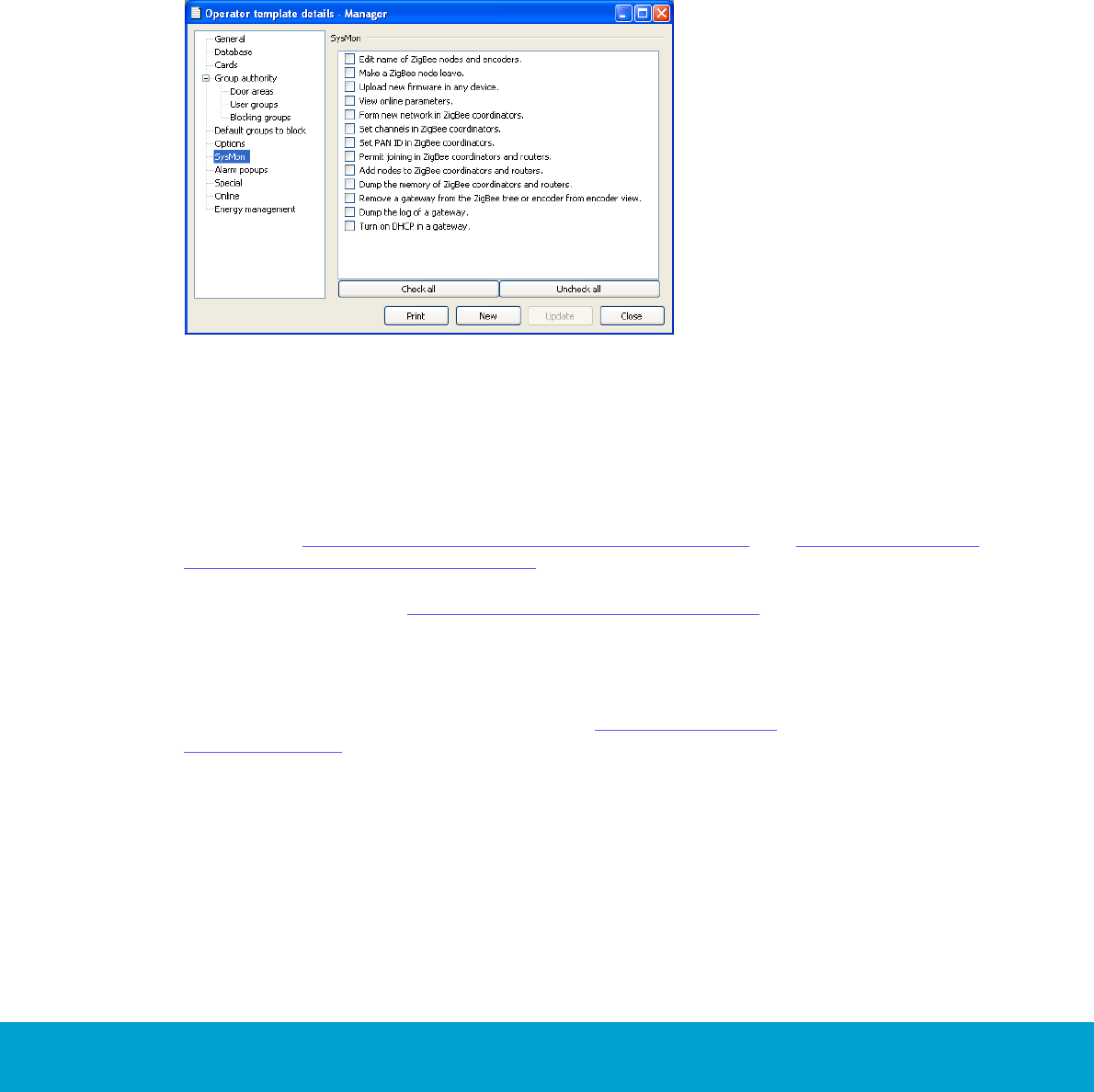
14
ASSA ABLOY Hospitality 66 3081 004-22
To set up SysMon authorities:
1. Double click on Operator templates under the Lists tab in the navigation window
of the client.
2. Mark an existing operator template and click Properties, or click Add to create
a new operator template.
3. In the Operator Template Details dialog, click SysMon in the left pane.
4. Mark the applicable checkboxes for operations that operators belonging to the
template should be allowed to perform in SysMon.
5. If an existing operator template was updated with SysMon information, click
Update and Close. If a new operator template was created, enter applicable
information for the operator template under the other panes General, Database
etc and then click Save and Close.
Figure 4
Online settings and commands are made in the client.
If a dialog in the client should be refreshed due to online changes, this is shown with
a * in the dialog caption. Click the Refresh button in the dialog.
Different operator templates can be given different authorities for online commands;
see sections 4.3 Set up operator templates in a hotel system and 4.4 Set up operator
templates in an access control system respectively.
For online settings, see chapter 4 Online settings in the client.
For online commands, see the user manual for the client (the sections about
online commands for a door and about commands under the Online tab).
For supervision of the system, see chapters 6 System operation and
7 Commissioning.
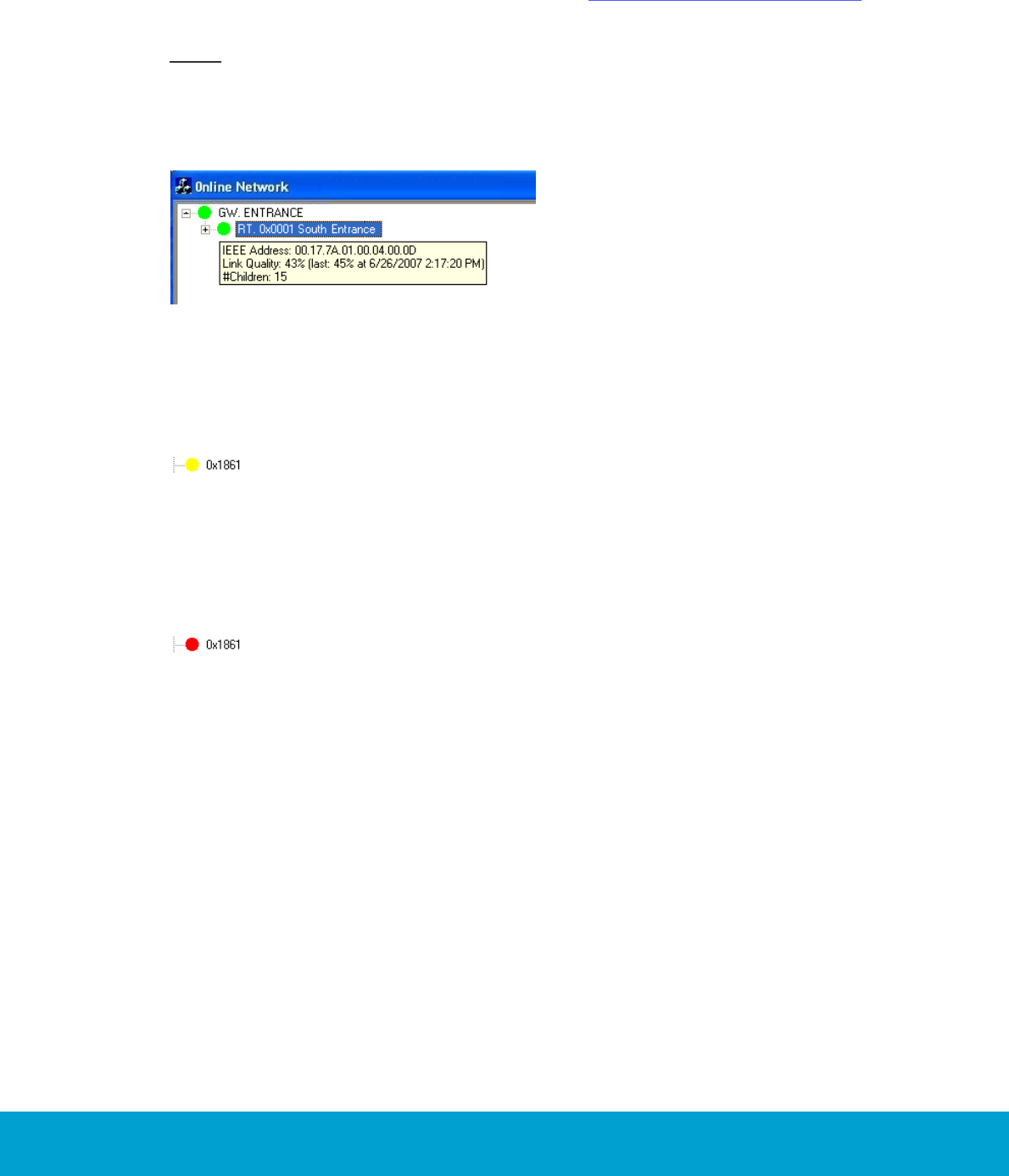
15
ASSA ABLOY Hospitality 66 3081 004-22
1.11 Link quality
The Link Quality Index (LQI) is an average percentage that should not be below 30%.
It is displayed when the mouse hovers over a node in the SysMon Online Network
view; see example in the screenshot below. See section 3.2 Installing a gateway for
information about how to log on to SysMon and find the Online Network view.
Note: The LQI value which is shown when the mouse hovers over a node is not an
instantaneous value but an average; the last instantaneous value, with timestamp,
is however shown within parantheses after the average. To get an instantaneous
value of the LQI, right click on a router or endnode in the SysMon Online Network
view and choose Get User Description.
Figure 5
The LQI is valid for the link between the node and its parent.
If the LQI is below 30%, the dot in front of the node in SysMon is yellow; see
example in Figure 6.
Figure 6
If the LQI is below 15%, the dot in front of the node is SysMon is red; see example
in Figure 7.
Figure 7
1.12 Abbreviations
In the rest of this user manual, the following abbreviations are used:
GW = gateway
RT = router
EN = endnode
PAN = personal area network
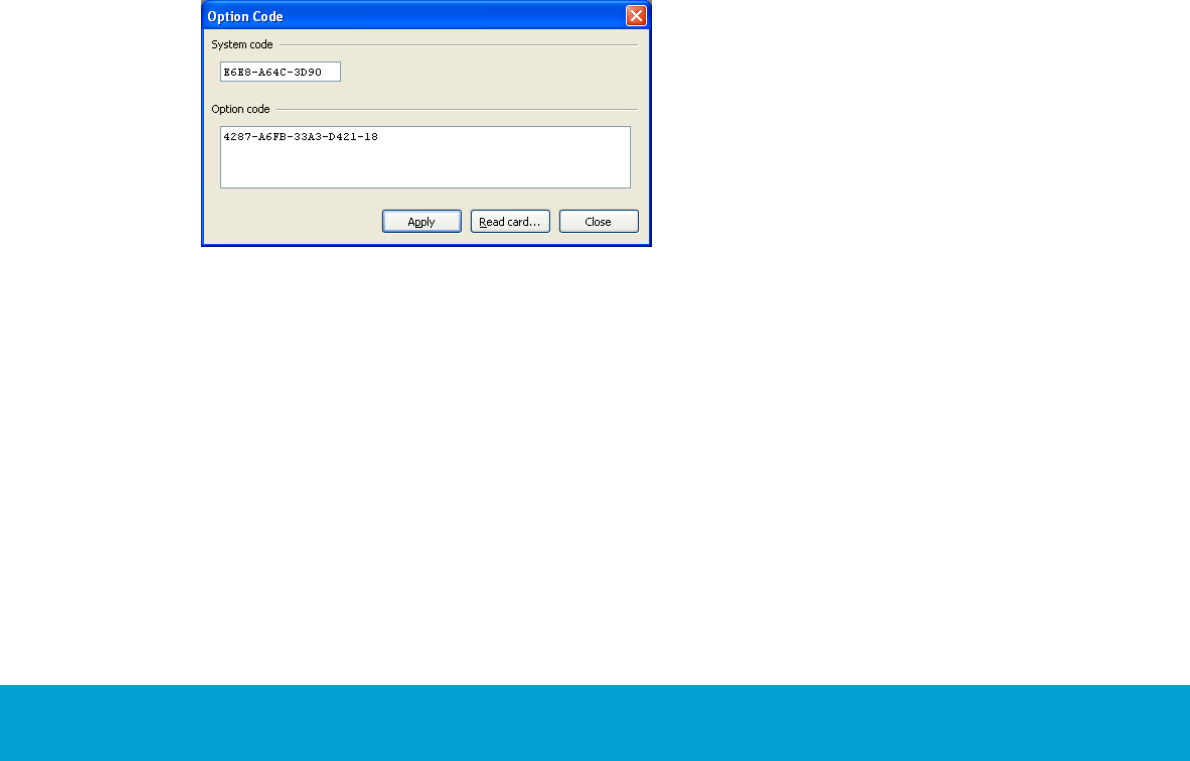
16
ASSA ABLOY Hospitality 66 3081 004-22
2. Installing the option
If the option has been ordered together with the software, it is included in the license
code and will be set in the software when the license code is entered.
If the option should be added to the system at a later occasion, when the license code
has already been entered and system ID is therefore set, an option code is used instead.
Several software options can be included in one option code. An operator with the
authority to handle option codes must be logged on. Normally, options are set by the
system manager or the distributor.
When ordering the option, the system code must be communicated to the
ordering department:
1. Double click on System settings under the Reports tab in the navigation
window to find the system code. System settings is available even if you are not
logged on.
2. Communicate your system code to the order department; see order
acknowledgement for phone number and e-mail address. The system code can also
be entered in the Ordering web page when making the order.
To install the option:
1. When you have got your option code, go to Tools/Option code.
2. Enter the option code and click Apply.
Figure 8

17
ASSA ABLOY Hospitality 66 3081 004-22
3. Installing online devices
The online devices were designed to allow for maximum flexibility during installation.
There are no particular location specifications as long as the devices are within
reasonable range of each other and good radio communication can be attained.
Generally, the range is however around 20 metres or through a wall. The range
of the devices depends to large extent on the building material(s) in the
surroundings. As much effort as possible should be made to securely install each
device in a location where it will be dry, cool, and undisturbed, yet still maintain
good radio contact with its parent or children.
Important: The ZigBee communication can be disturbed by e.g. Wi-Fi networks;
always make sure to have as long distances as is physically possible between ZigBee
devices and other radio equipment. If this still causes problems at a site, automatic
channel change can be enabled. See more information about automatic channel
change in section 9.1.1.
This section will discuss the installation methods for each device in the system as
well as options for forcing devices to connect to specific parent devices.
Software requirement:
Hotel system: version 1.9.0 or later
Access control system: version 1.6.0 or later
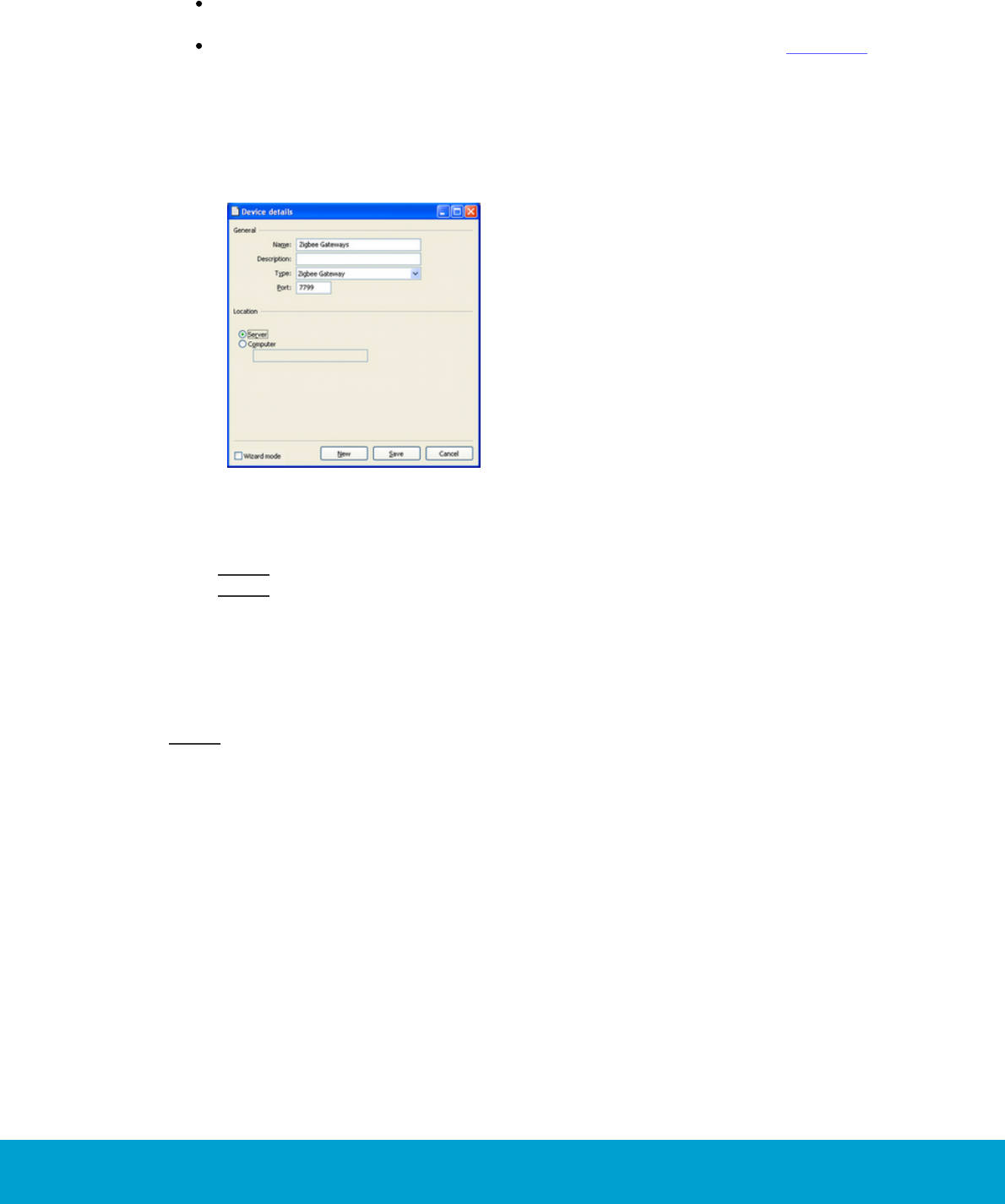
18
ASSA ABLOY Hospitality 66 3081 004-22
3.1 Installing a server
The application server must be connected to the same network that the
GW devices will be connected to.
The application server must have the online option installed; see chapter 2
for details.
1. Before you install the first GW device, you must add a ZigBee gateway to the
device list in the software (double click on Devices under the Lists tab in the
navigation window and click Add to add a new device) using the following
parameters:
Figure 9
2. When the fields have been filled in according to Figure 9 (port 7799 is pre-filled
as default when choosing 'ZigBee gateway' at Type), click Save and Close.
Note: If desired, mark the checkbox 'Wizard mode' to get more detailed help.
Note: The same device is used for all GWs.
For testing and commissioning purposes it is a good idea to have either a laptop with
the server software installed which you can use to directly connect to gateways as
they are installed, or a laptop with a connection to the live application server. This
will allow you to test radio signal strength as you are installing the devices on each
floor so issues can be addressed immediately.
Note: The network information is stored in the GWs and not in the laptop.
3.1.1 TL Concentrator
TL Concentrator is a utility for simplifying the setup of a firewall when the GWs are
located on a different network. TLConcentrator runs on the ZigBee server and listens
for GWs on one port and forwards all traffic to the application server on another port.
All traffic from the application server is sent to the correct GW. In this way, the
firewall will only have to be set up to allow sockets from the ZigBee server.
The alternative would be to set up the firewall to allow sockets for every GW.
This would add implications, especially when adding or exchanging GWs.
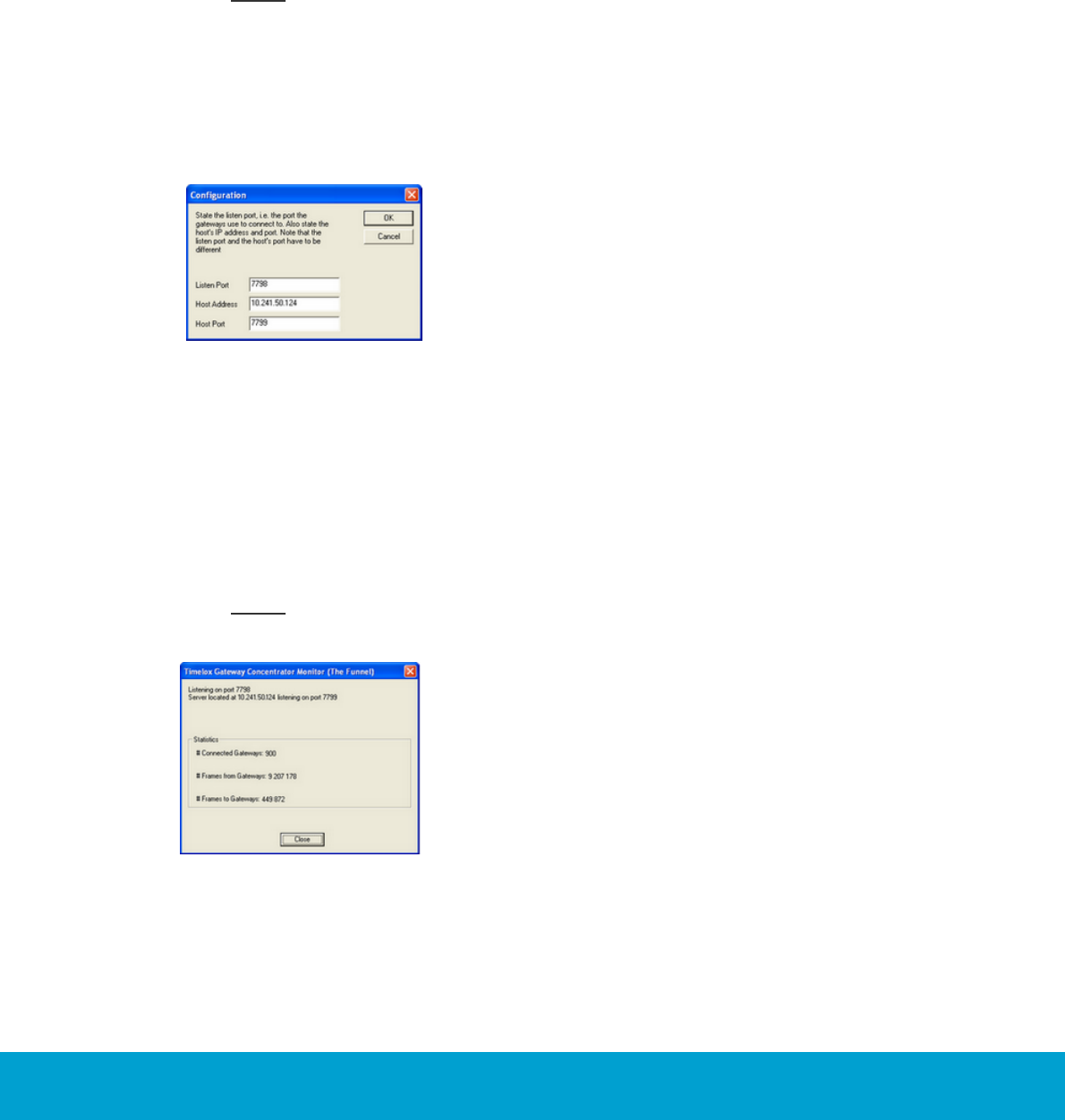
19
ASSA ABLOY Hospitality 66 3081 004-22
3.1.1.1 TL Concentrator setup
The application server is set up to listen for GWs on port 7799. This is where
TLConcentrator will connect. TLConcentrator is set up to listen for GWs on port 7798
and to open sockets on the application server using port 7799.
To set up these parameters:
1. Go to Start/Run.
2. Browse to the installation folder, mark TLConcentrator.exe and click Open.
3. Add /config
Note: There should be a space before /
4. Click OK.
A Configuration dialog will be shown.
1. Let the default 7798 be at Listen Port.
2. State the host’s IP address at Host Address.
3. Let the default 7799 be at Host Port.
Figure 10
3.1.1.2 TL Concentrator monitor
It is possible to monitor the traffic through TLConcentrator using
TLConcentrator.exe /monitor.
1. Go to Start/Run.
2. Browse to the installation folder, mark TLConcentrator.exe and click Open.
3. Add /monitor
Note: There should be a space before /
4. Click OK. The following dialog (with example statistics) is shown.
Figure 11
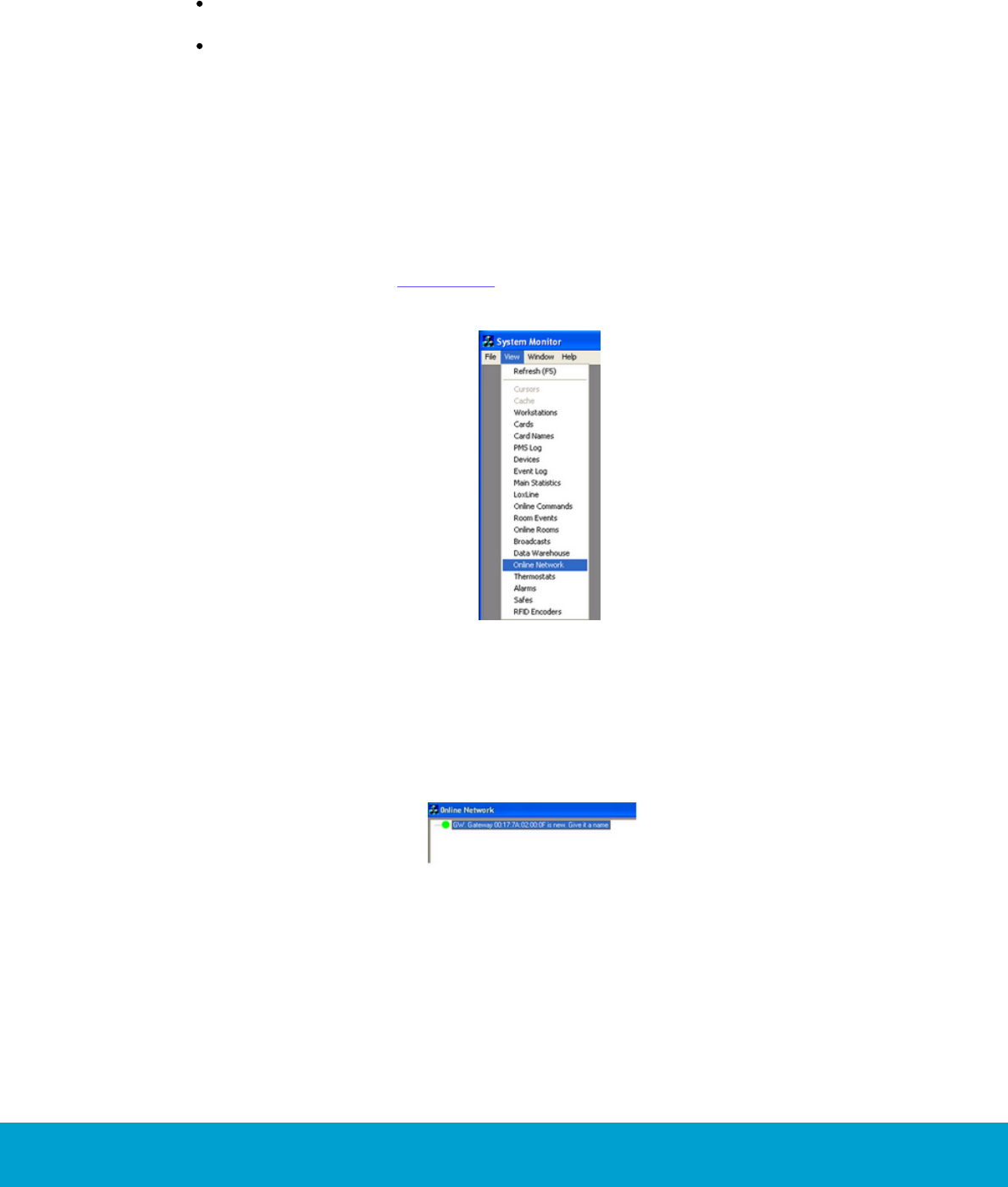
20
ASSA ABLOY Hospitality 66 3081 004-22
3.2 Installing a gateway
Power and network connections should be made in a manner that will reduce the
chances of the device being unplugged.
The GW is powered by 5VDC using a plug in wall power adapter, or via power
over Ethernet.
For network connectivity, the GW requires an available Ethernet port and a
patch cord.
1. Open the System Monitor (SysMon), which is used for managing the online
network. To open SysMon, double click on SysMon.exe in the installation
folder.
2. Log on to SysMon: go to File/Log on and enter user ID and password.
At 'Operator card', choose the applicable card encoder. Click Enter.
3. If it is not open already, open SysMon's Online Network view at View/
Online Network. The Online Network view of SysMon shows all connected
GWs, RTs and ENs. Several useful commands are available by right clicking on
nodes; see sections 3.8.1-3.8.3 for more information about the different
commands.
Figure 12
4. Mount the GW in a convenient, out of the way location using the
VELCRO® strip.
5. Connect the network cable and power cable to the GW.
6. After approximately 30 seconds the GW will announce itself to the
server and appear as a new GW in the Online Network tree in SysMon.
Figure 13
7. Right click on the new GW to bring up the device option menu and choose
Edit Name.
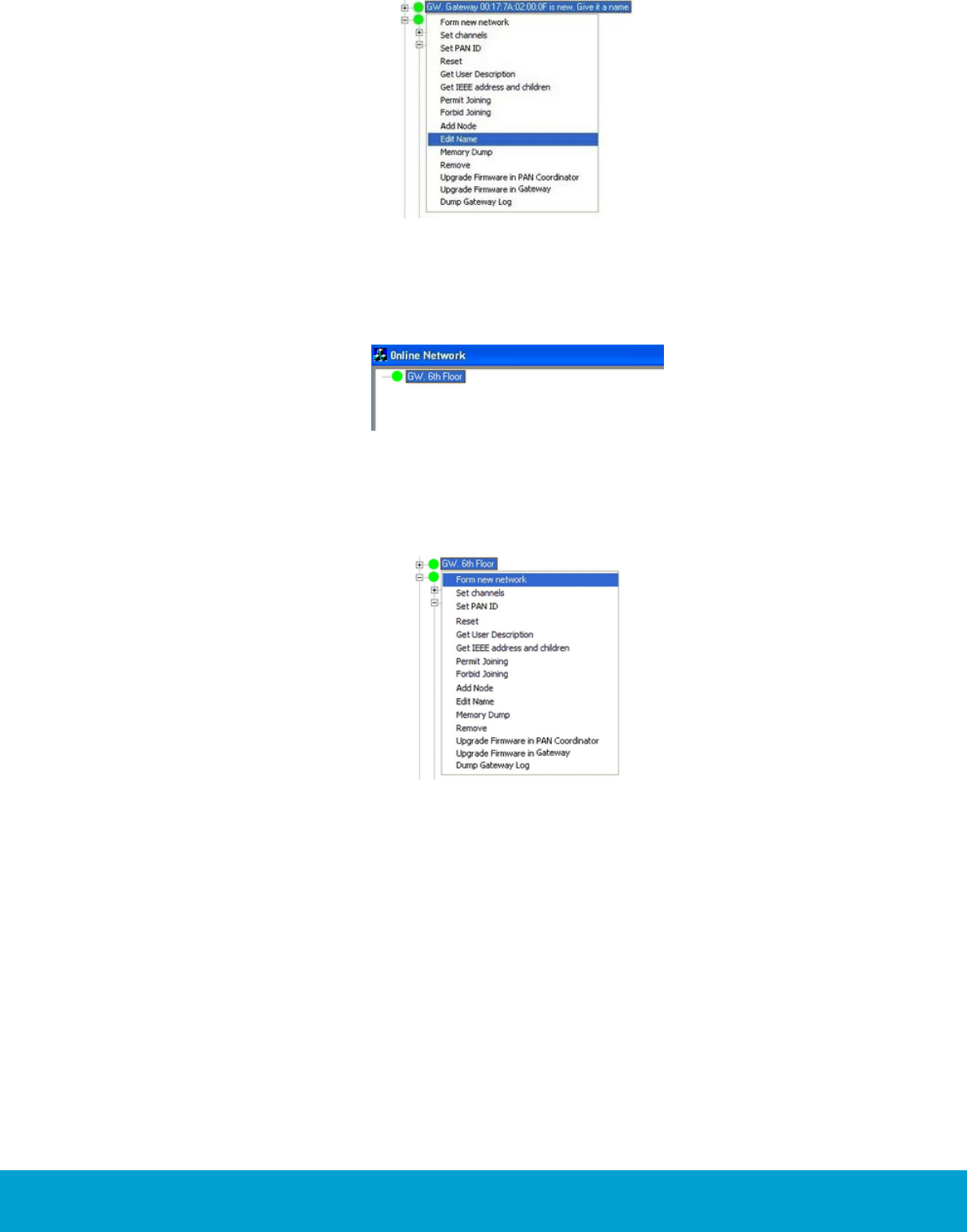
21
ASSA ABLOY Hospitality 66 3081 004-22
Figure 14
8. Name the GW something meaningful – it should generally indicate the GW's
location or coverage area.
Figure 15
9. Right click on the GW and select Form new network to make sure that the GW is
reset and gets a PAN ID.
Figure 16
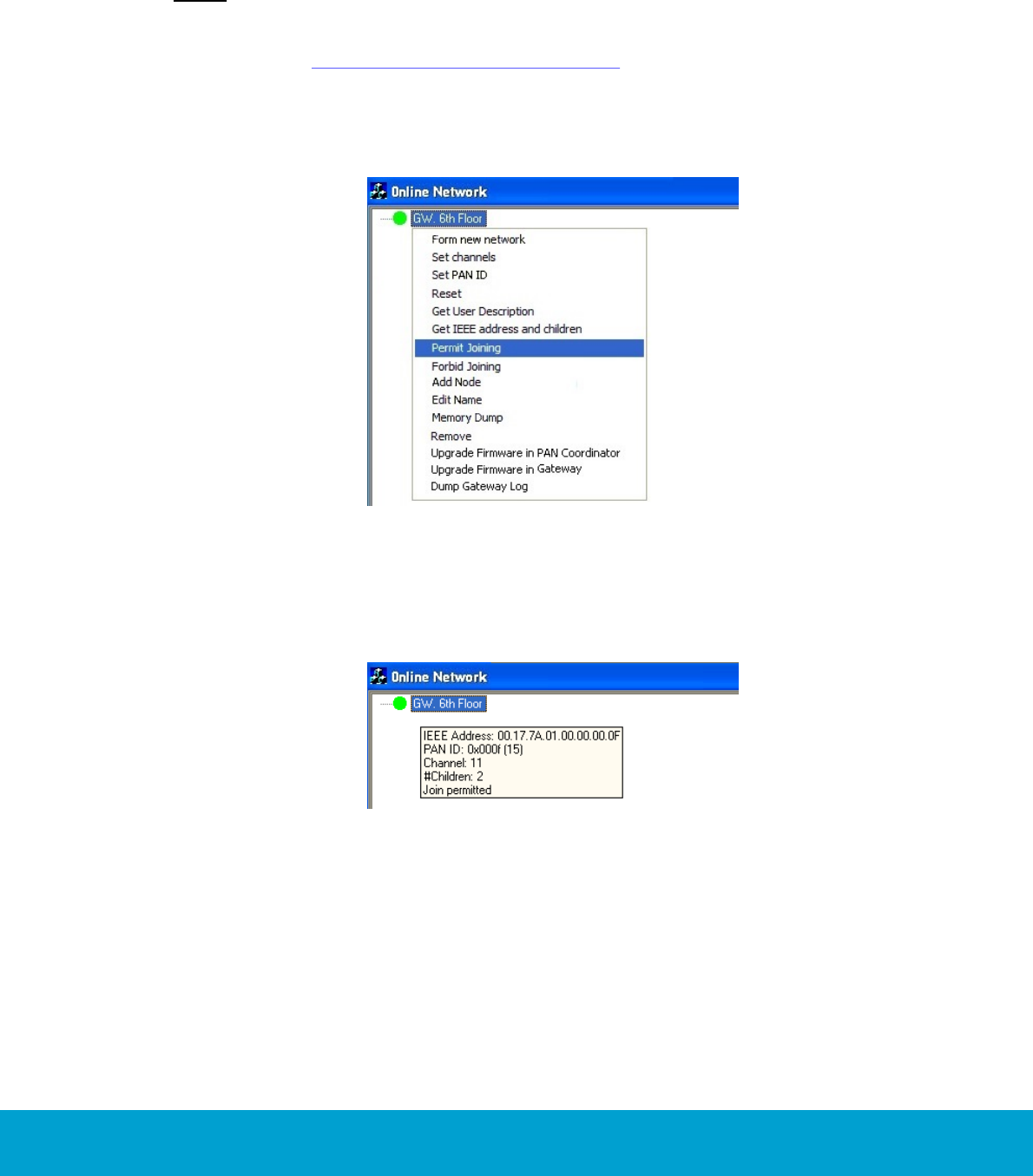
22
ASSA ABLOY Hospitality 66 3081 004-22
3.3 Adding routers to a gateway
The RT is powered by 5VDC using a plug in wall power adapter or a wired
transformer. No wired Ethernet network connection is required as it communicates
with the GW via radio.
Note: The recommended installation method is to use the enclosed VELCRO® strip to
attach the RT to a wall or some other convenient location.
As described in section 1.10 SysMon and the client, it is set up in the operator
template what operations a certain operator can perform in SysMon.
1. To add an RT to the online network, right click on the GW the RT should join and
choose Permit Joining.
Figure 17
2. Hold your mouse over the GW name and a box will pop up containing some
information about that device. At the bottom of that box you will see it says
Join permitted, indicating that the GW now allows new connections.
Figure 18
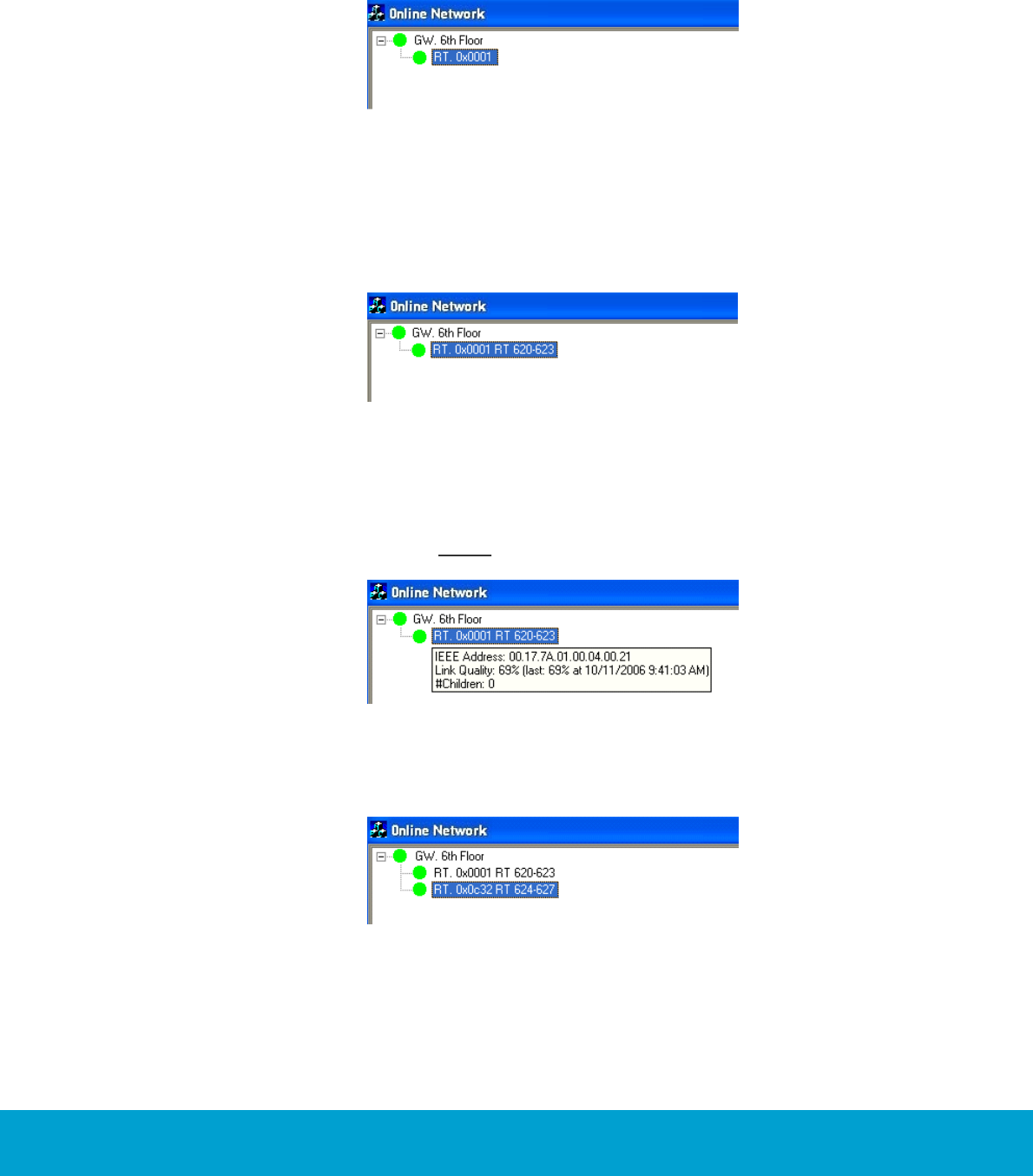
23
ASSA ABLOY Hospitality 66 3081 004-22
3. When the RT has been mounted with the VELCRO® strip, press the F1 button on
the RT while connecting power to the RT. The RT will power up and automatically
begin looking for a parent device to associate with. It will discover the GW on
which Permit Joining has been made, announce itself, and appear in the Online
Network tree in SysMon.
Figure 19
4. Right click on the RT and choose Edit Name to name the RT something
meaningful. In our example we have named it 'RT 620-623' to indicate the group
of rooms that will be attached to that RT.
Figure 20
5. Hold your mouse over the device to view the RF link quality (LQI) between the RT
and the GW. It shows the average LQI followed by the last measurement with
timestamp in parentheses. Note: The LQI should not be below 30%.
Figure 21
6. While the GW still says Join permitted when holding the mouse over the GW,
plug in any additional RTs as needed (up to five per GW) and name them.
Figure 22
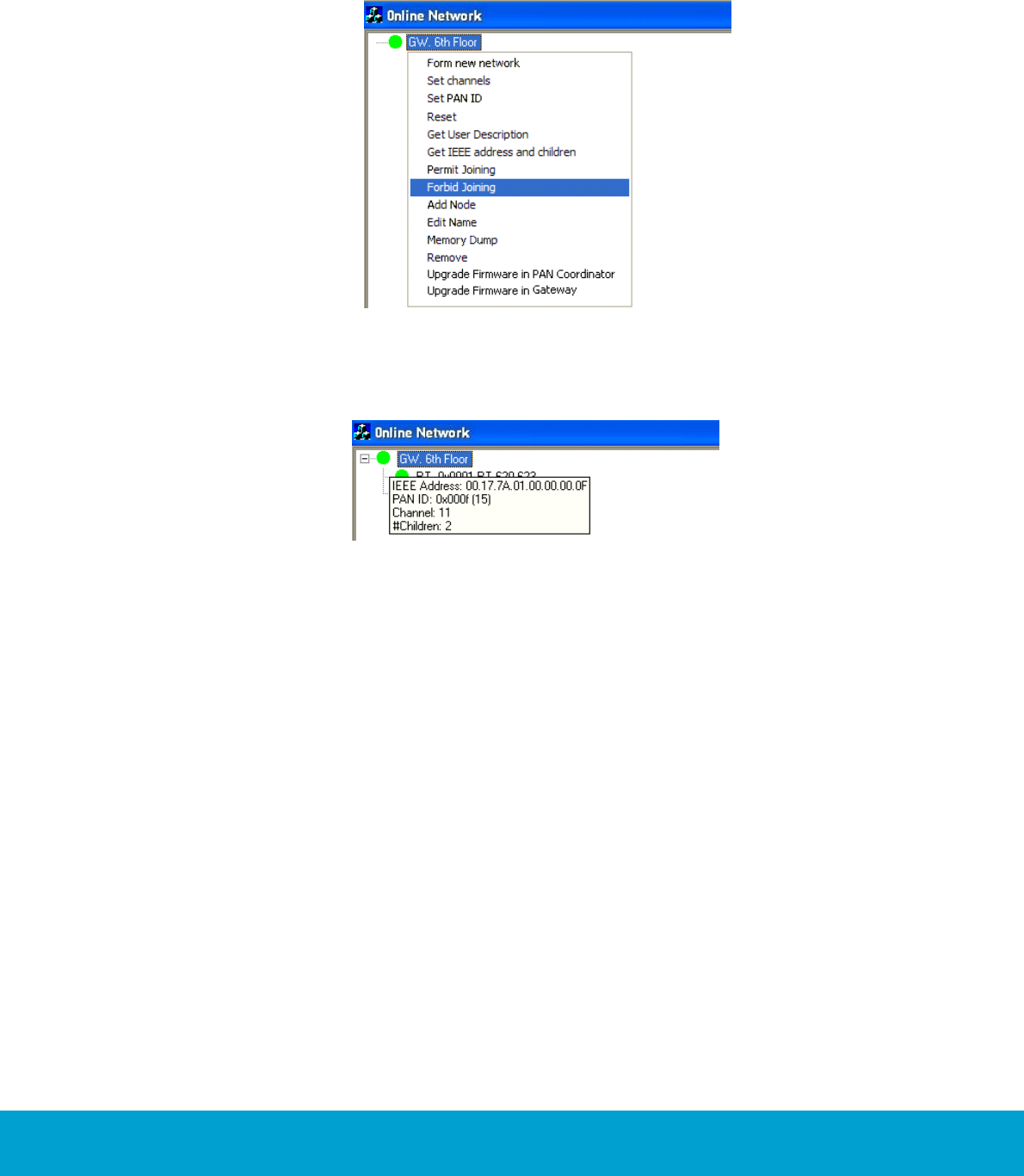
24
ASSA ABLOY Hospitality 66 3081 004-22
7. Hold your mouse over each RT to check the LQI making sure it is within
acceptable limits.
8. When all desired RTs have been added to the GW, right click on the GW
and choose Forbid Joining.
Figure 23
9. Hold your mouse over the GW to confirm it no longer says Join permitted.
Figure 24
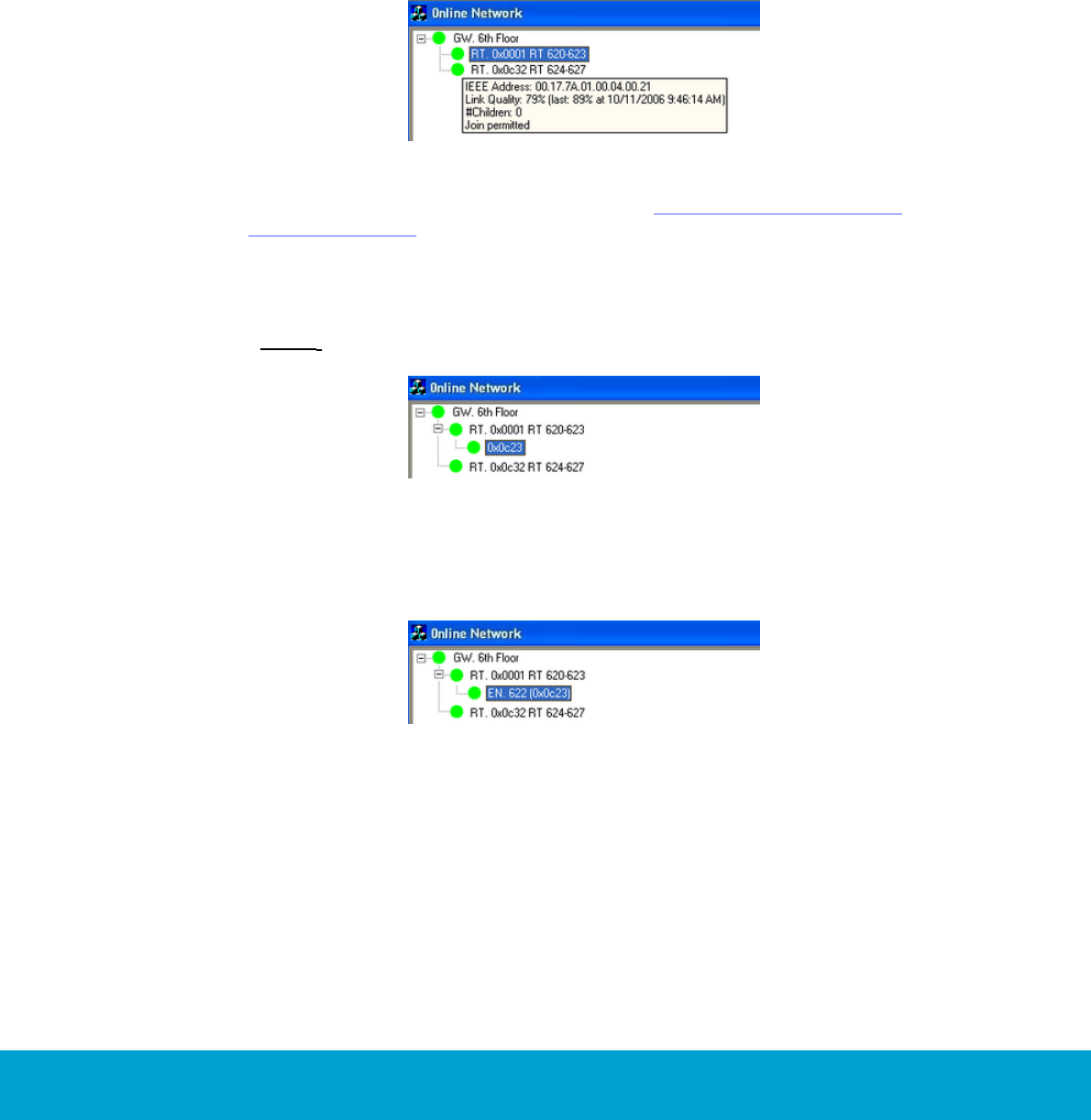
25
ASSA ABLOY Hospitality 66 3081 004-22
3.4 Adding endnodes to a router
The EN is the radio board inside the door lock unit. This device should not
be confused with the lock electronics themselves, and when troubleshooting
communication or lock issues care should be taken to diagnose the correct piece
of hardware.
1. To add an EN to an RT, right click on the RT the EN should join and choose
Permit Joining (or press the F1 button on the RT). Hold your mouse over
the RT to verify that joining is permitted.
Figure 25
2. Present the Discovery card at the lock; see chapter 5 Issuing a ZigBee
configuration card. The lock will chirp once and/or show a green LED signal
(depending on lock model) to indicate it has read the card, and will start
searching for the RT on which Permit Joining has been made to join.
When it finds the RT it will announce itself to the server and appear in
the Online Network tree.
Note: The Discovery card also sets sub product ZigBee in the lock.
Figure 26
After the lock sends its first event, the room number that is programmed in the lock
will automatically fill in. This can be forced by presenting a working key in the lock.
Figure 27
3. Hold your mouse over the lock to verify the LQI is within acceptable limits.
Continue adding additional locks to the RT as needed. When finished, right
click on the RT and choose Forbid Joining.
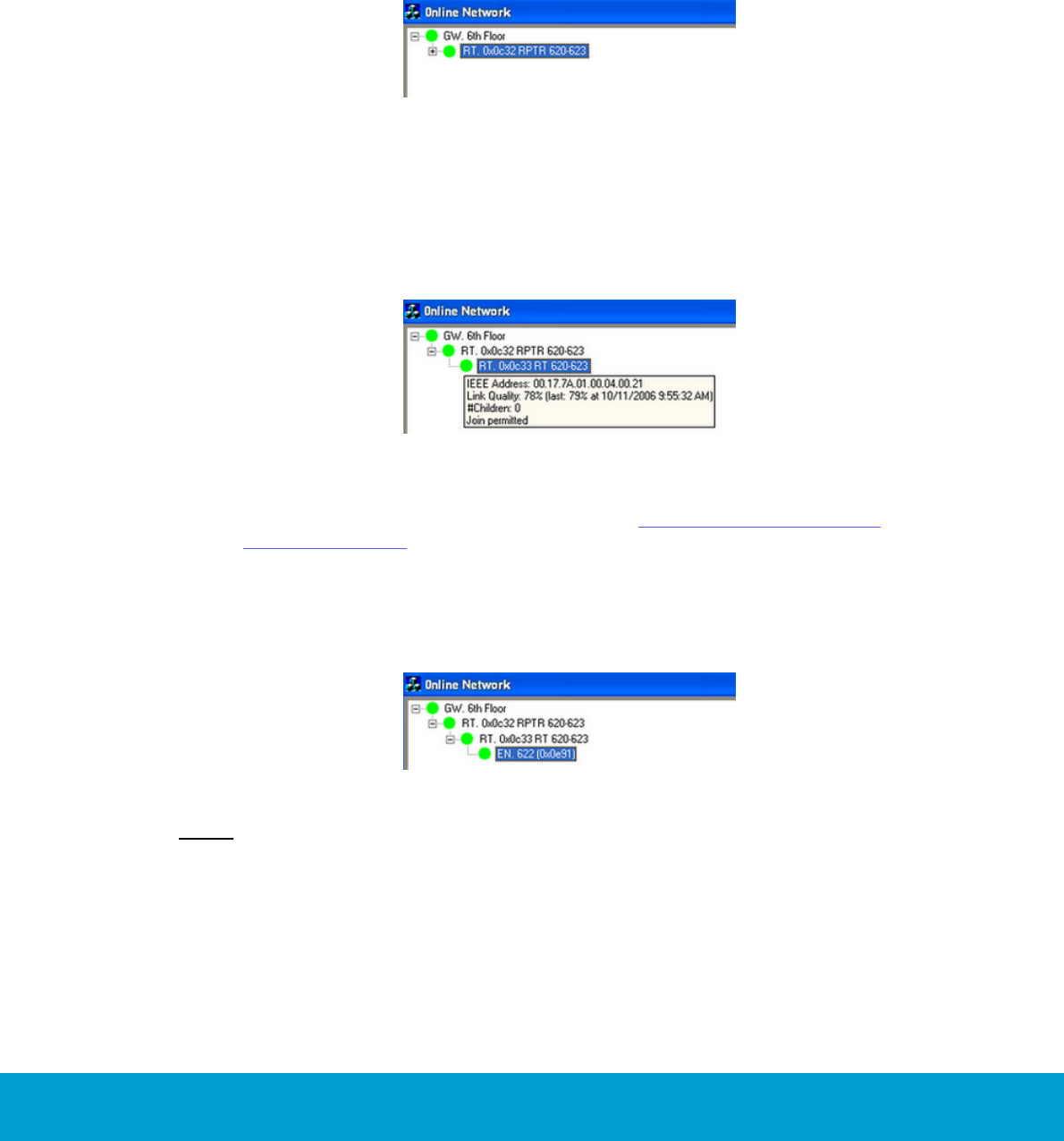
26
ASSA ABLOY Hospitality 66 3081 004-22
3.5 Using routers as repeaters
In the event there are locks that are not in range of a GW and RT combination,
an additional RT can be added for extended range.
1. Add the GW and first RT as normal. This first RT will act as a repeater between
the GW and the 2nd RT which will be communicating with the locks. In our
example we named the first RT 'RPTR 620-623' to indicate that it will act as
a repeater for the RT serving 620-623.
Figure 28
2. Choose Forbid Joining on the GW and Permit Joining on the 1st RT.
3. Plug in the 2nd RT. The 2nd RT will find and attach itself to the 1st RT.
4. Choose Forbid Joining on the 1st RT. Name the 2nd RT and choose Permit
Joining on it.
Figure 29
5. Present the Discovery card at the lock (see chapter 5 Issuing a ZigBee
configuration card); the lock will chirp once and/or show a green LED signal,
depending on lock model. The lock will find and attach itself to the RT on
which Permit Joining has been made, and when the first event is received
from the lock the room number will fill in.
6. Add all the necessary locks and choose Forbid Joining on the 2nd RT.
Figure 30
Note: For Z-Stack (ZigBee 2004), the RT acting as a repeater is only capable of
communicating to the GW and the 2nd RT; it is in this case not possible at this time
to repeat signals to a 2nd RT and communicate directly with locks at the same time.
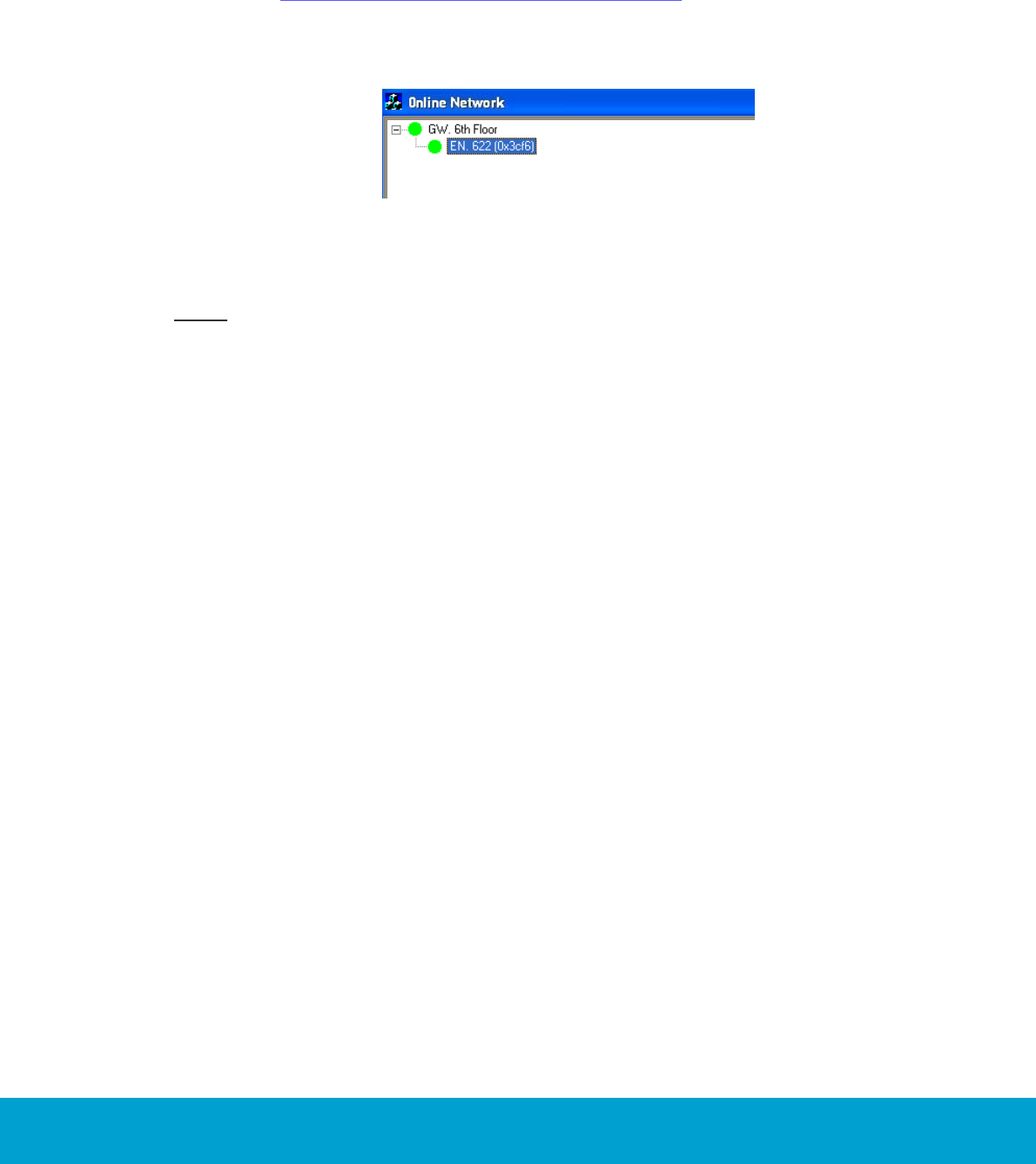
27
ASSA ABLOY Hospitality 66 3081 004-22
3.6 Adding locks to gateways
There may be cases where the locks will communicate directly with the GW.
To do this:
1. Choose Permit Joining on the GW and present the Discovery card at the lock
(see chapter 5 Issuing a ZigBee configuration card); the lock will chirp once
and/or show a green LED signal, depending on lock model. The lock will attach
itself to the GW on which Permit Joining has been made, and when the first
event is received the room number will automatically fill in.
Figure 31
2. Add the necessary locks and then choose Forbid Joining on the GW.
Note: RTs should not be connected to a GW which has got ENs connected to it.
3.7 Forcing parents
If a device such as an EN sees two RTs when it is in discovery mode (i.e. if 'permit
joining' has by mistake been made on two RTs belonging to different PANs at the
same time), it is possible that the EN will not join the desired RT – i.e. the RT with
which it has the strongest RF link. For this reason it is recommended that GWs, RTs
and ENs be installed in a systematic way to ensure all devices are connected to the
parent that makes the most sense.
If a situation arises in which a device is connected to the wrong parent, it is easy
enough to force the child device to leave the network and rejoin properly. If a right
click is made on the child device in SysMon, and the Leave network command is
chosen, the child device will deregister from the parent so another node can join.
The rejoining to a new parent is performed with the Permit Joining command.
An example when a child device is connected to the wrong parent would be that an
EN is within range of both RT-A and RT-B. Signal strength between the EN and RT-A
is 32%, while signal strength between the EN and RT-B is 75%. In this case it is a
good idea to force the EN to connect to RT-B.
To force the EN by using the Permit Joining command:
1. Right click on the EN and choose Leave Network. The EN will deregister
from RT-A.

28
ASSA ABLOY Hospitality 66 3081 004-22
Note: Due to a bug in BeeStack radio nodes of versions before 1.0.49, do not
use the Leave Network command for these older versions.
2. Important: Wait for 40 seconds to avoid confusing RT-A from which the EN has
deregistered.
3. Make sure that Forbid Joining has been chosen for RT-A and that Permit
Joining has been chosen for RT-B.
4. Present a Discovery card at the EN door lock (see chapter 5 Issuing a ZigBee
configuration card); the lock will chirp once and/or show a green LED signal,
depending on lock model. The EN will immediately begin to look for an available
parent, and since RT-A is in 'forbid joining' mode, RT-B will be its only option.
5. Once the EN has joined the correct RT, choose Forbid Joining on RT-B.
Note: The method above with Permit Joining can also be applied to RTs joining RTs,
RTs joining GWs, and ENs joining GWs.
3.8 Right-click menus in SysMon
When right clicking on GWs, RTs and ENs in SysMon, different choices appear
depending on what item you right click on. The different choices are described in
the following sections.
Note: Depending on what operator template that the logged on operator belongs to,
different operations in the right-click menus are greyed or not. The operations that a
certain operator template should be allowed to perform are set up in the client under
the SysMon alternative in the Operator Template Details dialog; see the client
setup manual for details.
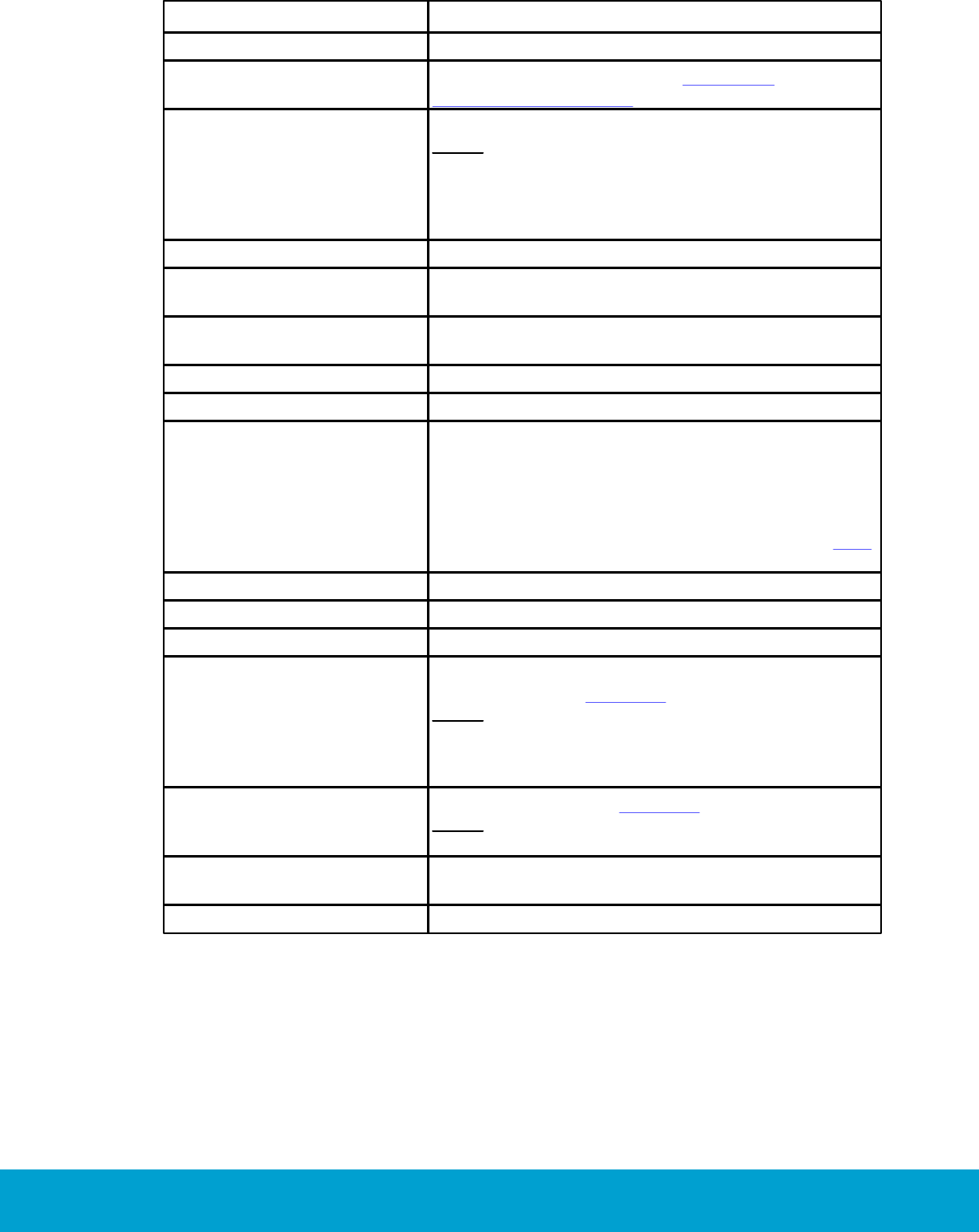
30
ASSA ABLOY Hospitality 66 3081 004-22
Menu choice
Description
Form new network
makes a total reset of the GW
Set channels
selects allowed channels; see section 9.1
Communication channel for further information
Set PAN ID
sets another identity
Note: The Set PAN ID choice is normally not used,
since the PAN ID is given automatically by the
network. If the PAN ID is 0x000, choose Form
new network in the right-click menu for the GW;
see above.
Reset
makes a reset; all data is retained
Get
User Description
gets parameters (e.g. version) for the node
Get IEEE address
and children
gets the IEEE address as well as all children stored
in the association list
Permit Joining
makes it possible for children to join
Forbid Joining
forbids children to join
Add Node
This menu choice can be used e.g. if a gateway in
a corridor is broken and needs to be replaced. The
children under the gateway must then be set up as
new nodes in the association table, and instead of
needing to go into the guest rooms to fix this it can
be done from the Add Node dialog; see details here.
Edit Name
edits the node's name in the database
Memory Dump
reads the memory; only used by Technical support
Remove
removes the GW from the database
Upgrade Firmware in
PAN Coordinator
loads a new firmware into the PAN coordinator; see
bootload dialog in Figure 33
Note: The firmware shown is the one that has been
loaded into the application server database at
Tools/Module firmware; see the client setup
manual for details.
Upgrade Firmware in
Gateway
see bootload dialog in Figure 33
Note: This menu alternative is not applicable for
the older type of gateway (9VDC).
Dump Gateway Log
creates an xls file with internal gateway events for
troubleshooting purposes
Table 1
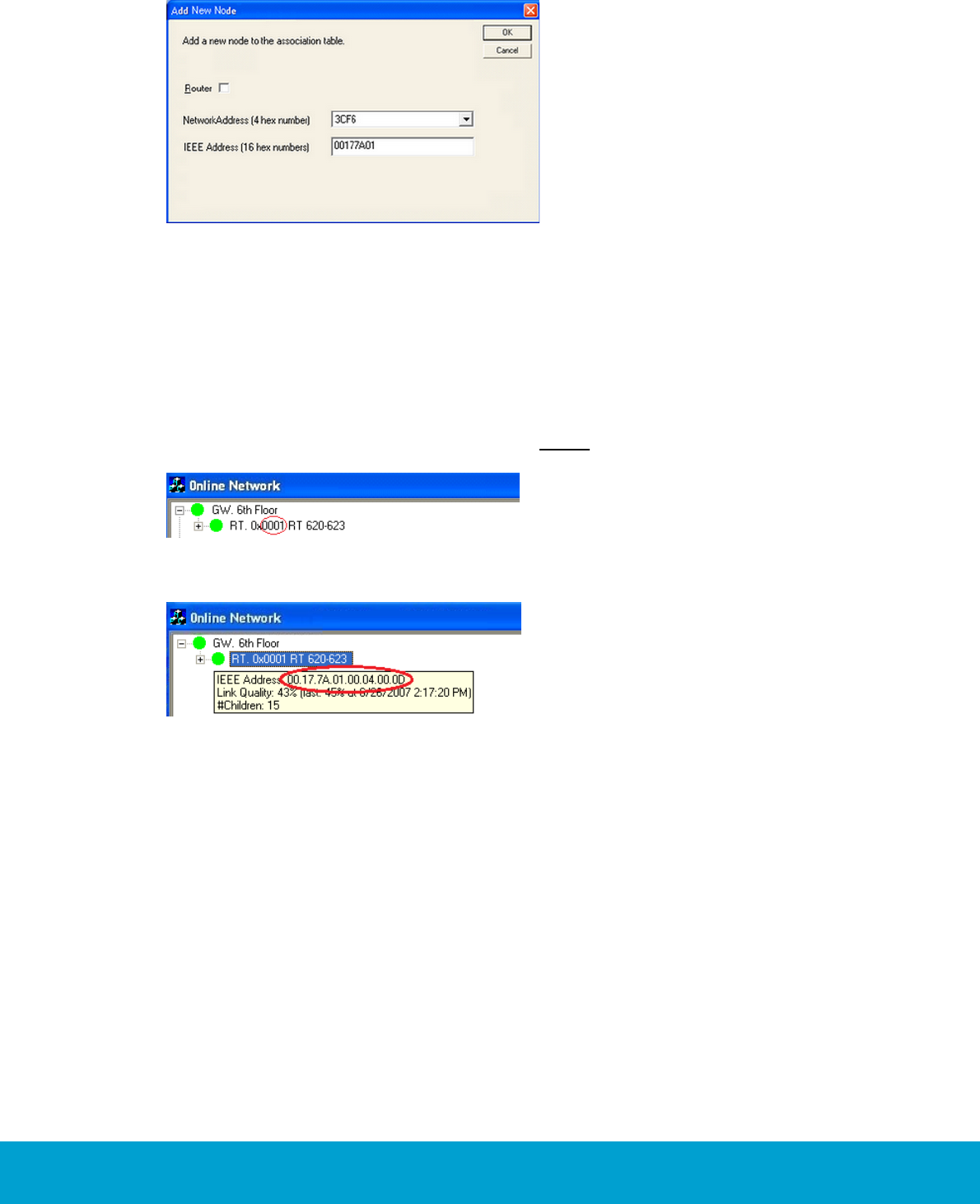
31
ASSA ABLOY Hospitality 66 3081 004-22
Details about 'Add Node':
Figure 34
1. When Add Node is chosen in the
right-click menu of a gateway or
router, a dialog as in Figure 34 is
shown.
2. If the node that should be added
is a router, mark the checkbox
Router.
3. Choose the applicable Network
Address in the drop-down-menu;
the network addresses are shown
in the Online Network tree of
SysMon, see example in Figure
35.
4. Complete the IEEE Address,
which is also found in the Online
Network tree of SysMon; see
example in Figure 36 (hover with
the cursor over the concerned node
to show information about IEEE
address etc).
Note: The Add Node function requires
BeeStack version x.0.53 or later.
Figure 35
Figure 36
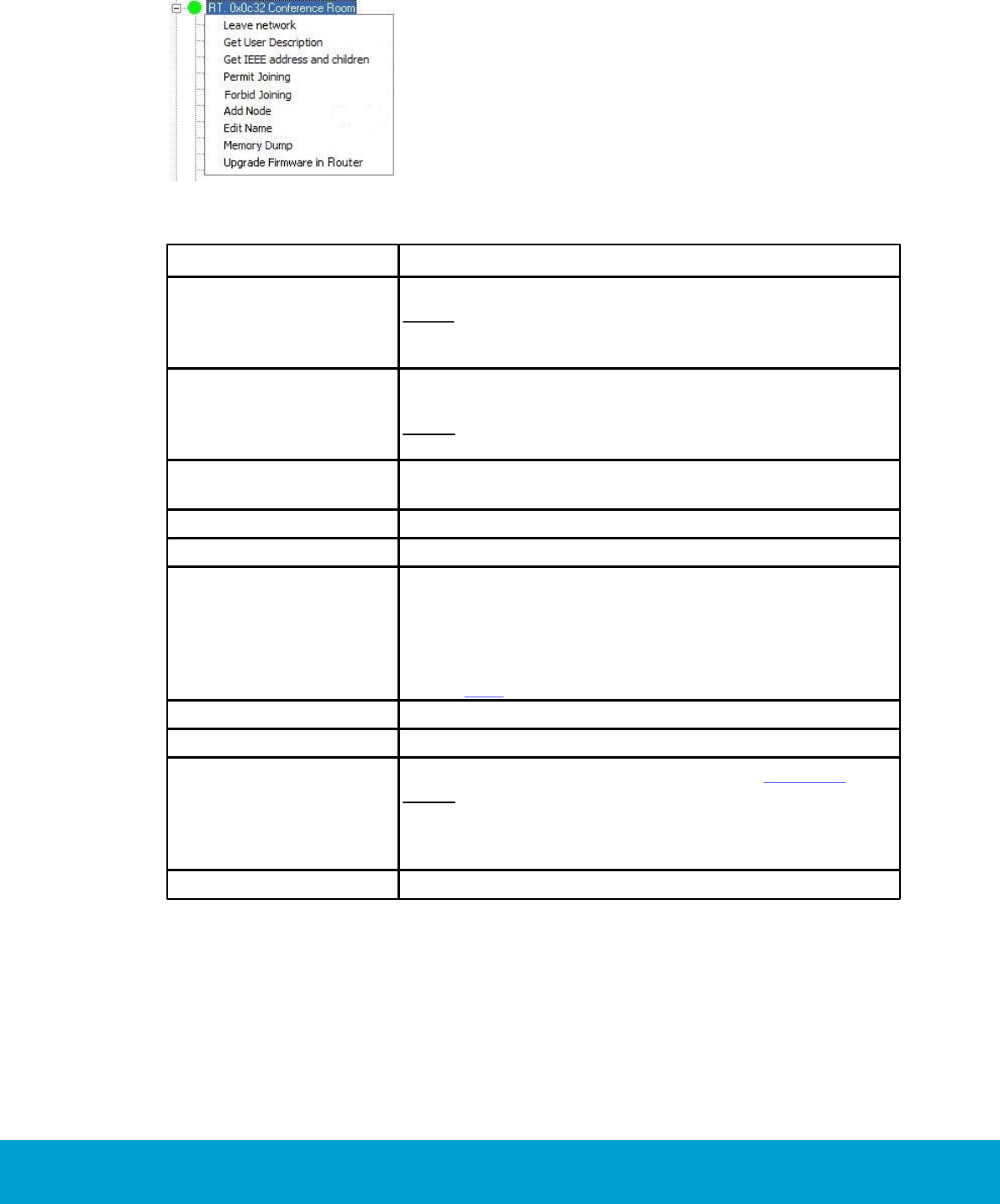
32
ASSA ABLOY Hospitality 66 3081 004-22
3.8.2 Right-click menu choices for RTs
Figure 37
Menu choice
Description
Leave network
deregisters from the parent so another node can join
Note: Due to a bug in BeeStack radio nodes of versions
before 1.0.49, do not use the Leave Network command
for these older versions.
Get User Description
gets parameters (e.g. link quality index, LQI) for
the node
Note: The LQI which is shown with Get User
Description is an instantaneous value.
Get IEEE address
and children
gets the IEEE address as well as all children stored in
the association list
Permit Joining
makes it possible for children to join
Forbid Joining
forbids children to join
Add Node
This menu choice can be used e.g. if a router is broken
and needs to be replaced. The children under the router
must then be set up as new nodes in the association
table, and instead of needing to go into the guest rooms
to fix this it can be done from the Add Node dialog; see
details here.
Edit Name
edits the node's name in the database
Memory Dump
reads the memory; only used by Technical support
Upgrade Firmware
in Router
loads a new firmware into the router; see Figure 33
Note: The firmware shown is the one that has been
loaded into the application server database at Tools/
Module firmware; see the client setup manual
for details.
Table 2
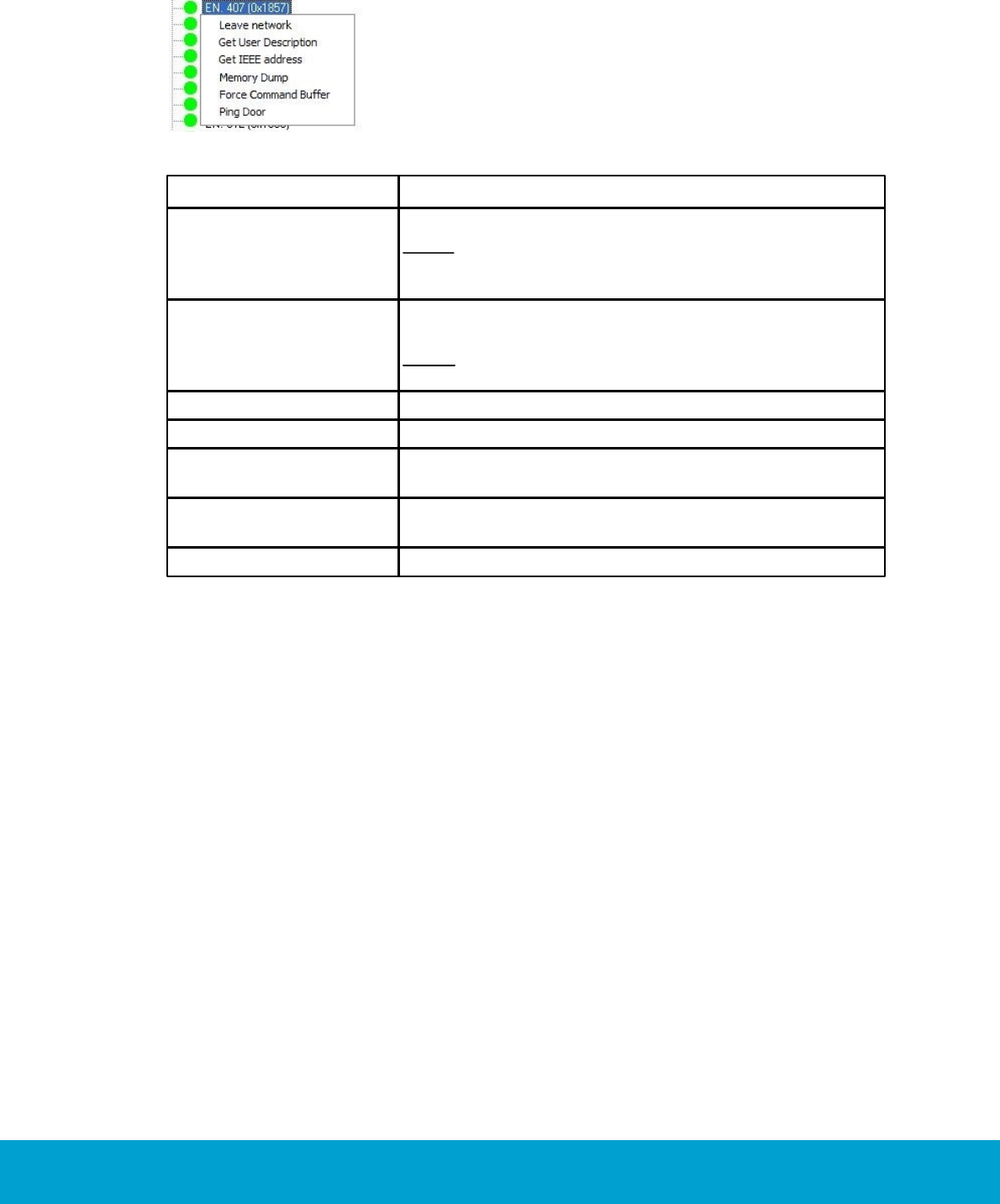
33
ASSA ABLOY Hospitality 66 3081 004-22
3.8.3 Right-click menu choices for ENs
Figure 38
Menu choice
Description
Leave network
deregisters from the parent so another node can join
Note: Due to a bug in BeeStack radio nodes of
versions before 1.0.49, do not use the Leave Network
command for these older versions.
Get
User Description
gets parameters (e.g. link quality index, LQI) for
the node
Note: The LQI which is shown with Get User
Description is an instantaneous value.
Get IEEE address
gets the IEEE address for the EN
Memory Dump
reads the memory; only used by Technical support
Force Command Buffer
forces the first buffered command for the lock to be
sent immediately
Ping Door
sends a command to the door to check whether it is
online or not
Table 3
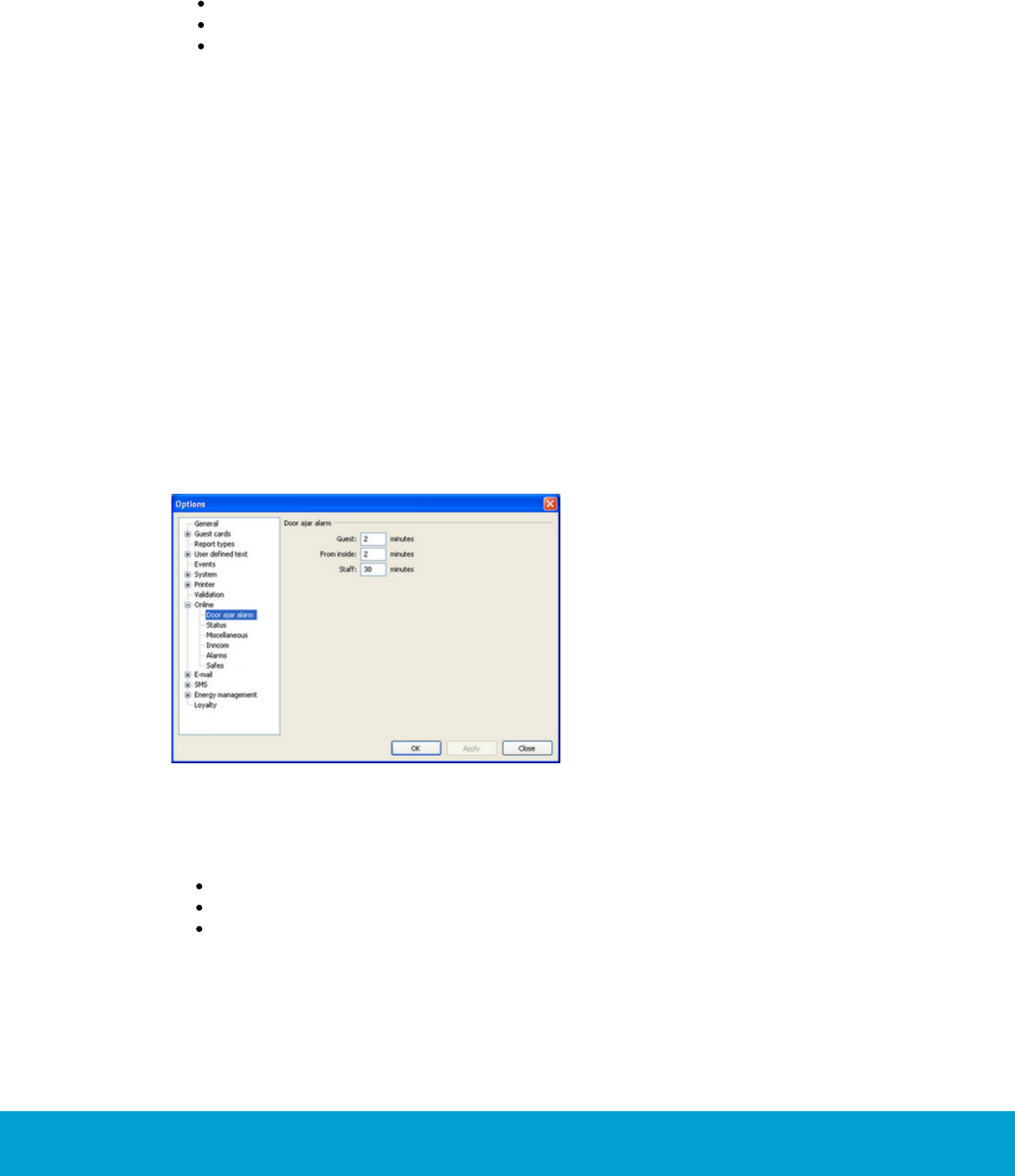
34
ASSA ABLOY Hospitality 66 3081 004-22
4. Online settings in the client
This section describes
door parameters for online doors
online authorities for operator templates
the function prevent invalid staff card usage; this function is only applicable for
hotel systems
For setup of doors (online as well as non-online doors), see the section about doors in
the setup manual for the client.
4.1 Setting up door parameters in a hotel system
Go to Tools/Options in the client and click Online in the left column; you can make
settings regarding
1. Door ajar alarm
2. Status - intruder and offline status
3. Miscellaneous
4. Alarms
5. Safes
4.1.1 Door ajar alarm
Figure 39
You can modify the time for when there will be a door ajar alarm. The door ajar
alarm can be 1-60 minutes; 0 means that the alarm is not used. The default
values are:
2 minutes when a guest card type has opened the door
2 minutes when a door has been opened from the inside
30 minutes when a staff card type has opened the door
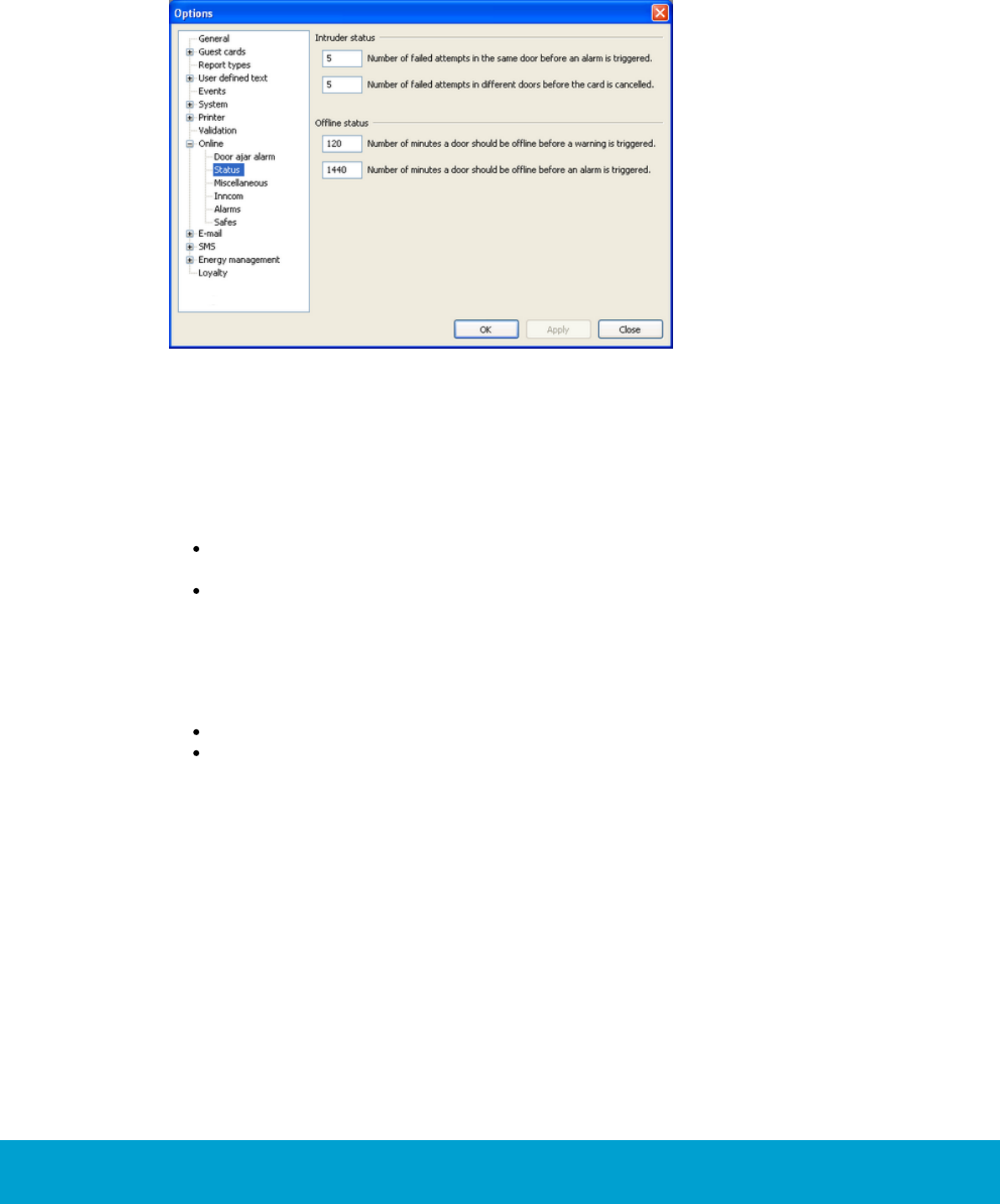
35
ASSA ABLOY Hospitality 66 3081 004-22
4.1.2 Status
Figure 40
The values for intruder status and offline status can be modified. See the screenshot
above and the sections below for default values.
4.1.2.1 Intruder status
After five failed attempts in the same online door, an alarm is triggered. This is
referred to as sequential intruder.
After five failed attempts in different online doors, the card is cancelled and an
alarm is triggered. This is referred to as wandering intruder.
4.1.2.2 Offline status
After 120 minutes of offline status in an online door, a warning is triggered.
After 1440 minutes of offline status in an online door, an alarm is triggered.
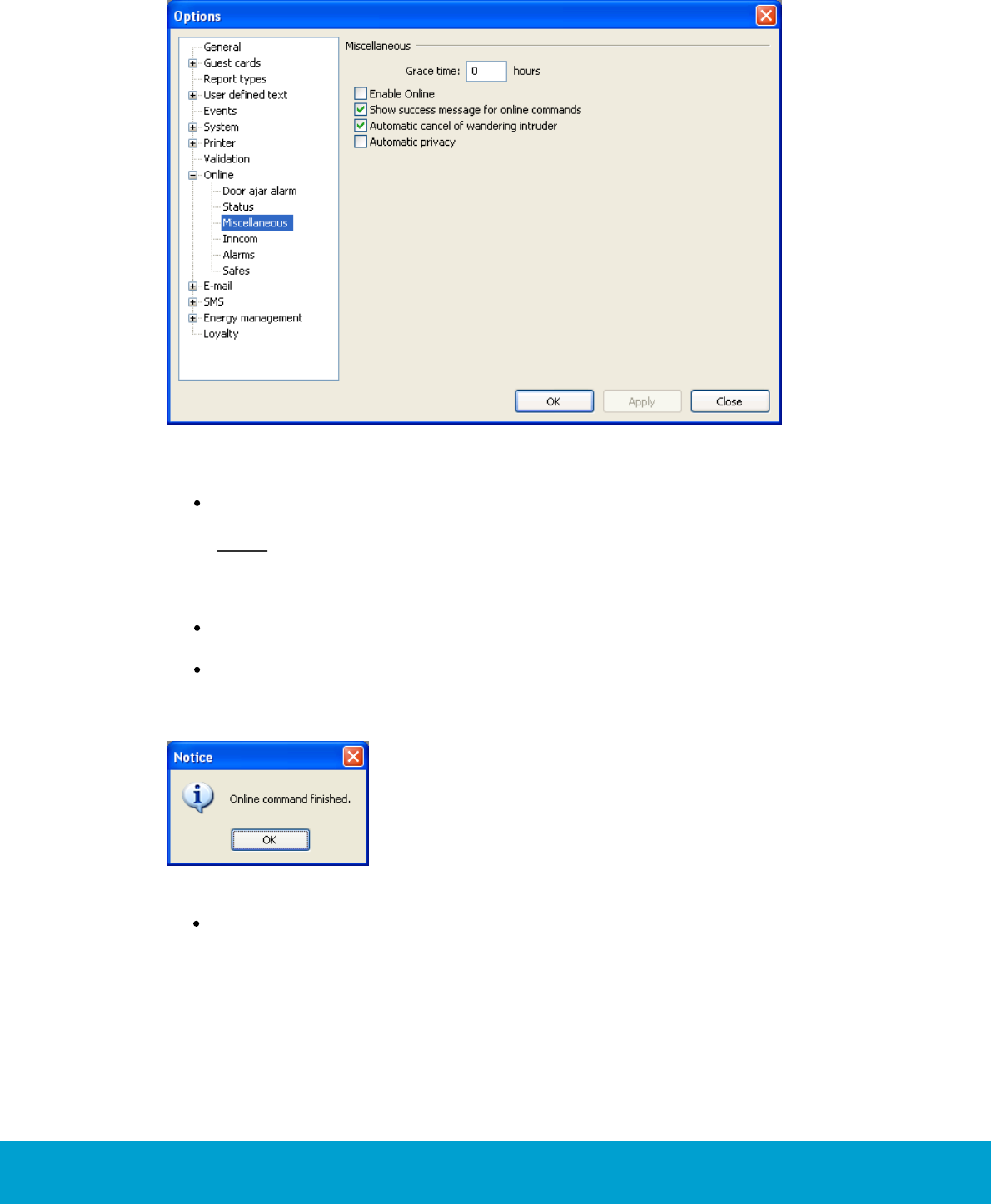
36
ASSA ABLOY Hospitality 66 3081 004-22
4.1.3 Miscellaneous
Figure 41
Under the Miscellaneous choice, you can
set the grace time, i.e. for how long the guest(s) can enter a room after a
check-out. The grace time can be 0-24 hours, default is 0.
Note: The default grace time which is set up at Tools/Options/Online/
Miscellaneous applies unless a specific grace time is specified when the guest
is checked out using the PMS interface. It also applies if the check-out is sent
from the client.
if for some reason desired, turn off the online functionality in the software by
unmarking the checkbox 'Enable Online'.
choose whether success messages should be shown or not when online
commands have been successfully performed; default is that they are shown.
See message below:
Figure 42
choose whether automatic cancel of wandering intruder should be used or not.
If a card is used five consecutive times in different online doors where it does
not have access, the alarm 'wandering intruder' is triggered and the card is
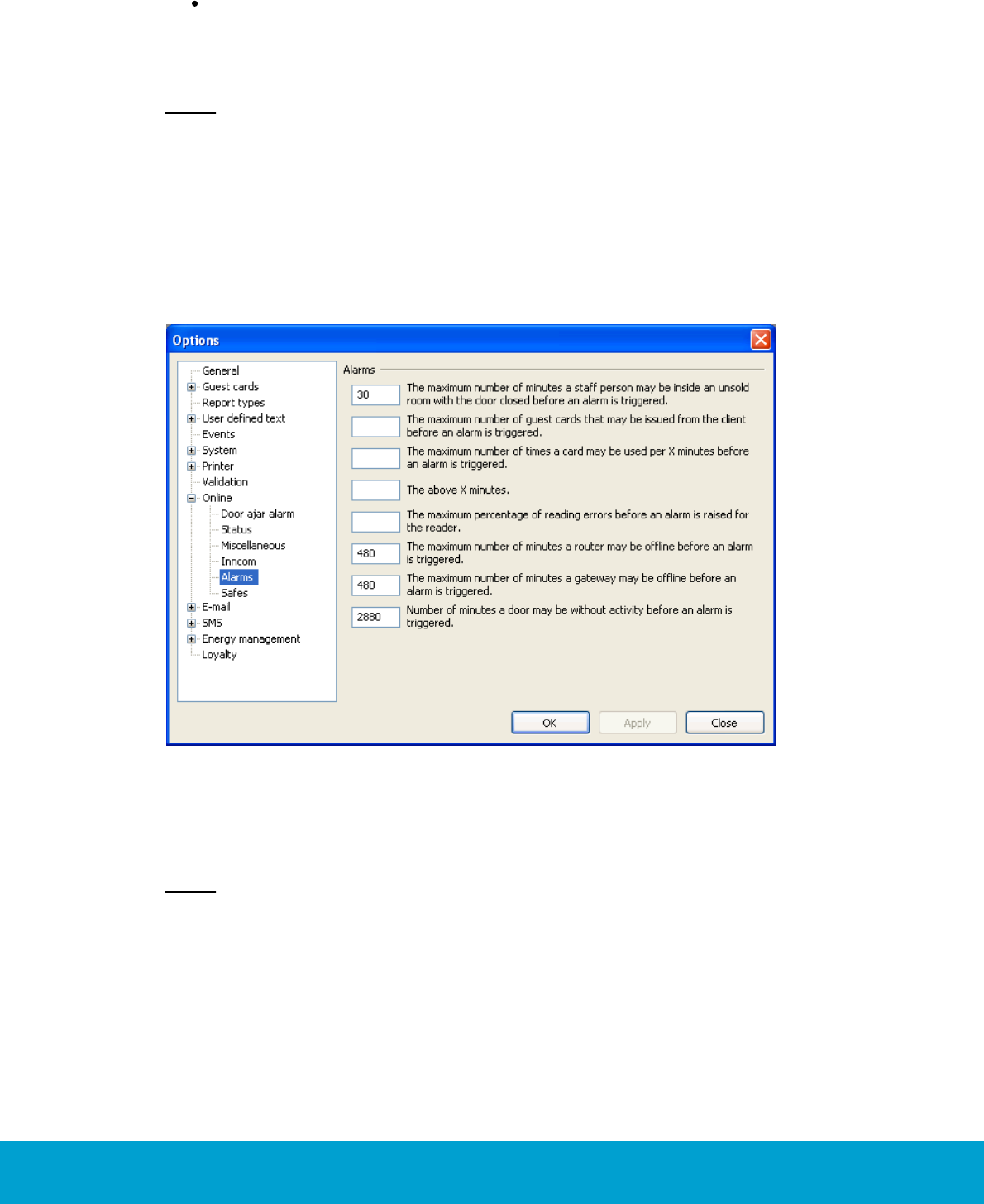
37
ASSA ABLOY Hospitality 66 3081 004-22
cancelled. If the checkbox 'Automatic cancel of wandering intruder' is
unmarked, the card will not be cancelled when the alarm is triggered.
choose whether automatic privacy should be used or not; only applicable if
the Orion EMS option is used. If 'Automatic privacy' is marked, the room will
automatically be set in privacy as long as it is rented and there is a detection
that someone is in the room.
Note: Automatic privacy is not a standard function; make sure to fully understand
the function before enabling it.
Only the emergency card and – if applicable – cards belonging to user groups for
which ‘Ignore privacy’ has been chosen in the User group details dialog will be able
to enter when automatic privacy is set.
4.1.4 Alarms
Figure 43
Under the Alarms choice, it is possible to set up different parameters related to
the alarm list; see the user manual for the client for more information about the list.
Note: Offline alarms have a default holdback time of 24 hours, i.e. they are not
shown as alarms in the client until 24 hours after they were triggered. An offline
alarm is described with the name of the gateway or router that caused the alarm
for any of its children.

38
ASSA ABLOY Hospitality 66 3081 004-22
'The maximum number of minutes a staff person may be inside an unsold room
with the door closed before an alarm is triggered'; default is 30 minutes. This
parameter is related to the alarm Invalid staff-card usage; see the user manual
for the client for more information.
'The maximum number of guest cards that may be issued from the client before
an alarm is triggered.' This parameter is related to the alarm Too many guest
cards issued in the client; see 'To limit the guest card issuing' in the setup
manual for the client for more information.
'The maximum number of times a card may be used per X minutes before an
alarm is triggered.' This parameter is related to the alarm Excessive card usage.
'The above X minutes'. This parameter is related to the alarm Excessive card
usage.
'The maximum percentage of reading errors before an alarm is raised for the
reader.' This parameter is related to the alarm Bad card reader.
Note: The alarm Bad card reader is triggered if the percentage of reading
failures exceeds the percentage that is entered in this field. The alarm must be
completed manually. The percentage is calculated continuously and there is no
lower limit for the number of reads needed for the calculation.
The maximum number of minutes a router may be offline before an alarm is
triggered. This parameter is related to the alarm ZigBee Router Offline.
The maximum number of minutes a gateway may be offline before an alarm is
triggered. This parameter is related to the alarm ZigBee Gateway Offline.
The maximum number of minutes a door may be without activity before an
alarm is triggered. This parameter is related to the alarm No door activity.
4.1.5 Safes
Safes can be set up at Tools/Options/Online/Safes and also require the In-room
safes option; see Installation instruction In-room safes option for details.
4.2 Setting up door parameters in an access control system
Go to Tools/Options in the client and click Online in the left column; you can make
settings regarding
1. Status - intruder and offline status; see section 4.1.2 for details
2. Miscellaneous; see section 4.1.3 for details
3. Alarms; see section 4.1.4 for details
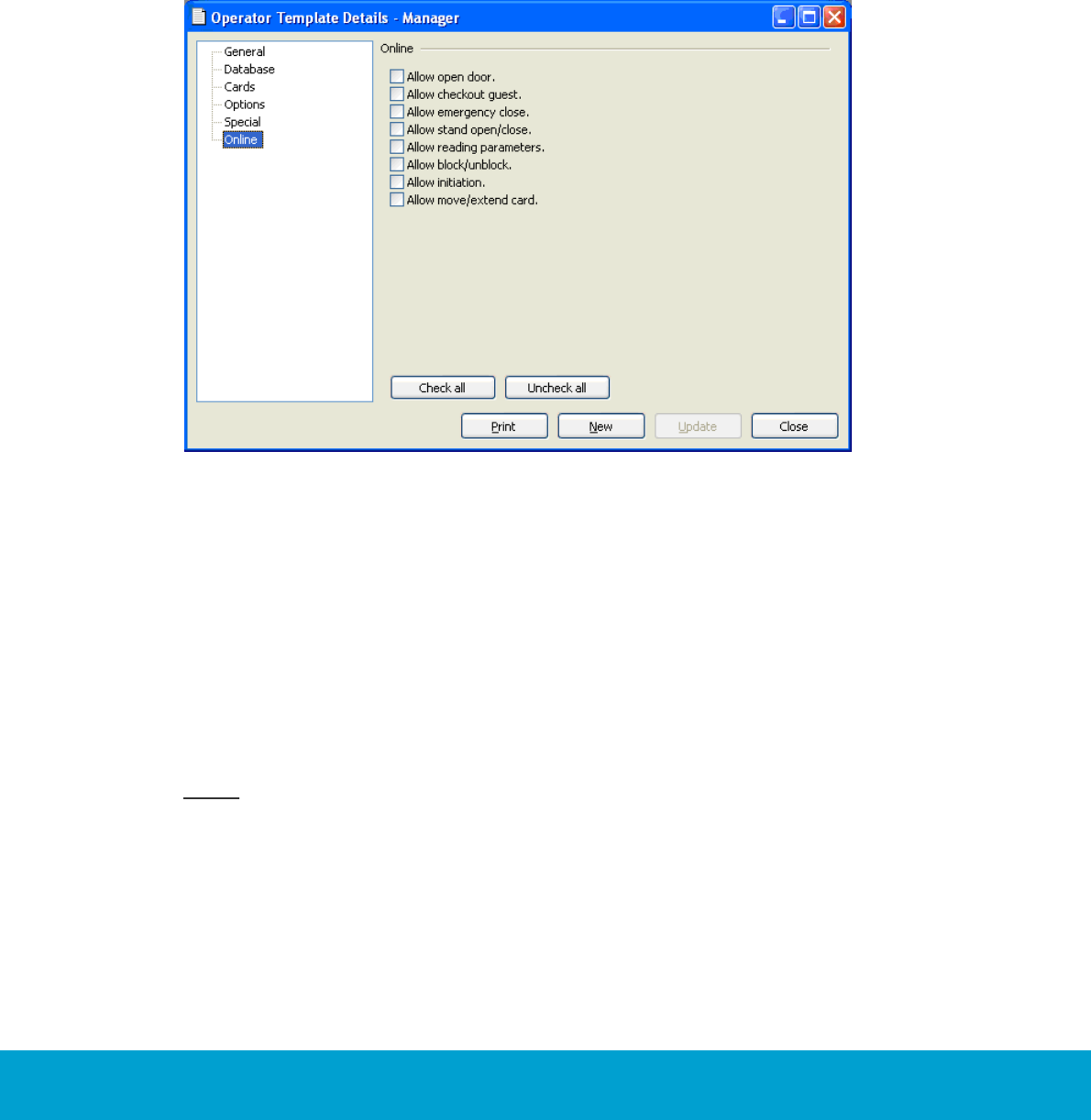
39
ASSA ABLOY Hospitality 66 3081 004-22
4.3 Setting up operator templates in a hotel system
In the Operator Template Details dialog, it is possible to set up what online
commands a certain operator template should be allowed to perform. See the section
about the Online tab in User manual Visionline for further information about the
different online commands.
To set up/modify an operator template:
Figure 44
1. Double click on Operator templates under the Lists tab in the
navigation window.
2. Mark the desired operator template and click Properties to open the
Operator Template Details dialog (or click Add to add a new operator
template; in that case, also make the appropriate choices under the other
alternatives in the left part of the Operator Template Details dialog).
3. Mark Online in the left column.
4. Check the applicable online operation(s) to the right.
5. Click Update, if an existing operator template was updated; click New or
Save if a new operator template was created.
Note: 'Allow emergency open' is by default only available for the distributor.
Discuss with your distributor if this choice should be available for any other operator.
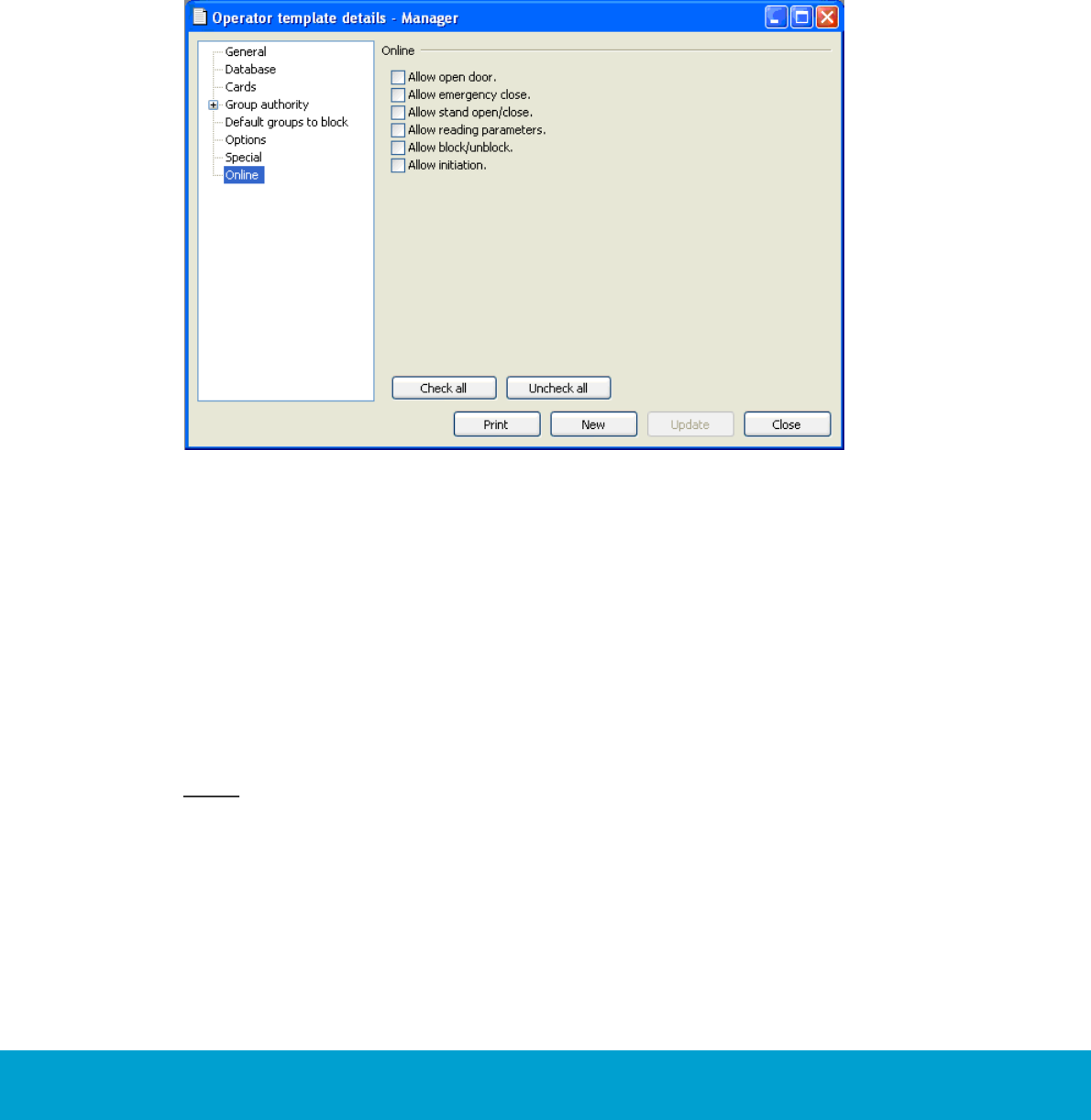
40
ASSA ABLOY Hospitality 66 3081 004-22
4.4 Setting up operator templates in an access control system
In the Operator Template Details dialog, it is possible to set up what online
commands a certain operator template should be allowed to perform. See the section
about the Online tab in the client user manual for further information about the
different online commands.
To set up/modify an operator template:
Figure 45
1. Double click on Operator templates under the Lists tab in the
navigation window.
2. Mark the desired operator template and click Properties to open the
Operator Template Details dialog (or click Add to add a new operator
template; in that case, also make the appropriate choices under the other
alternatives in the left part of the Operator Template Details dialog).
3. Mark Online in the left column.
4. Check the applicable online operation(s) to the right.
5. Click Update, if an existing operator template was updated; click New or
Save if a new operator template was created.
Note: 'Allow emergency open' is by default only available for the distributor.
Discuss with your distributor if this choice should be available for any other operator.

41
ASSA ABLOY Hospitality 66 3081 004-22
4.5 Preventing invalid staff card usage (only applicable for
hotel systems)
To avoid unsuitable use of other cards than different types of guest cards in guest
rooms, it is possible to set up that an alarm should be triggered if a person with a
non-guest card dead-bolts a guest room from the inside, or stays too long inside the
guest room. The function requires that the online option has been set. The invalid
staff card usage function covers all card types except for cards of type guest, joiner,
guest, joiner, suite, joiner suite, guest advanced, future arrival, one time and
meeting room.
At Tools/Options/Online/Alarms, the choice 'The maximum number of minutes
a staff person may be inside an unsold room with the door closed before an alarm is
triggered' is available; default is 30 minutes. If the number of minutes should be
changed, enter the applicable number and click OK; see Figure 43.
To enable the alarm:
1. Go to Tools/Enable/disable alarms.
2. Mark 'Invalid staff-card usage'.
3. Click Update and Close.
The alarms will appear in the alarm list; see the user manual for the client for more
information about the list.
See Installation instruction Communication option for information about
how to set up receivers of alarm e-mails/SMSes
how to set up e-mail receivers of reports
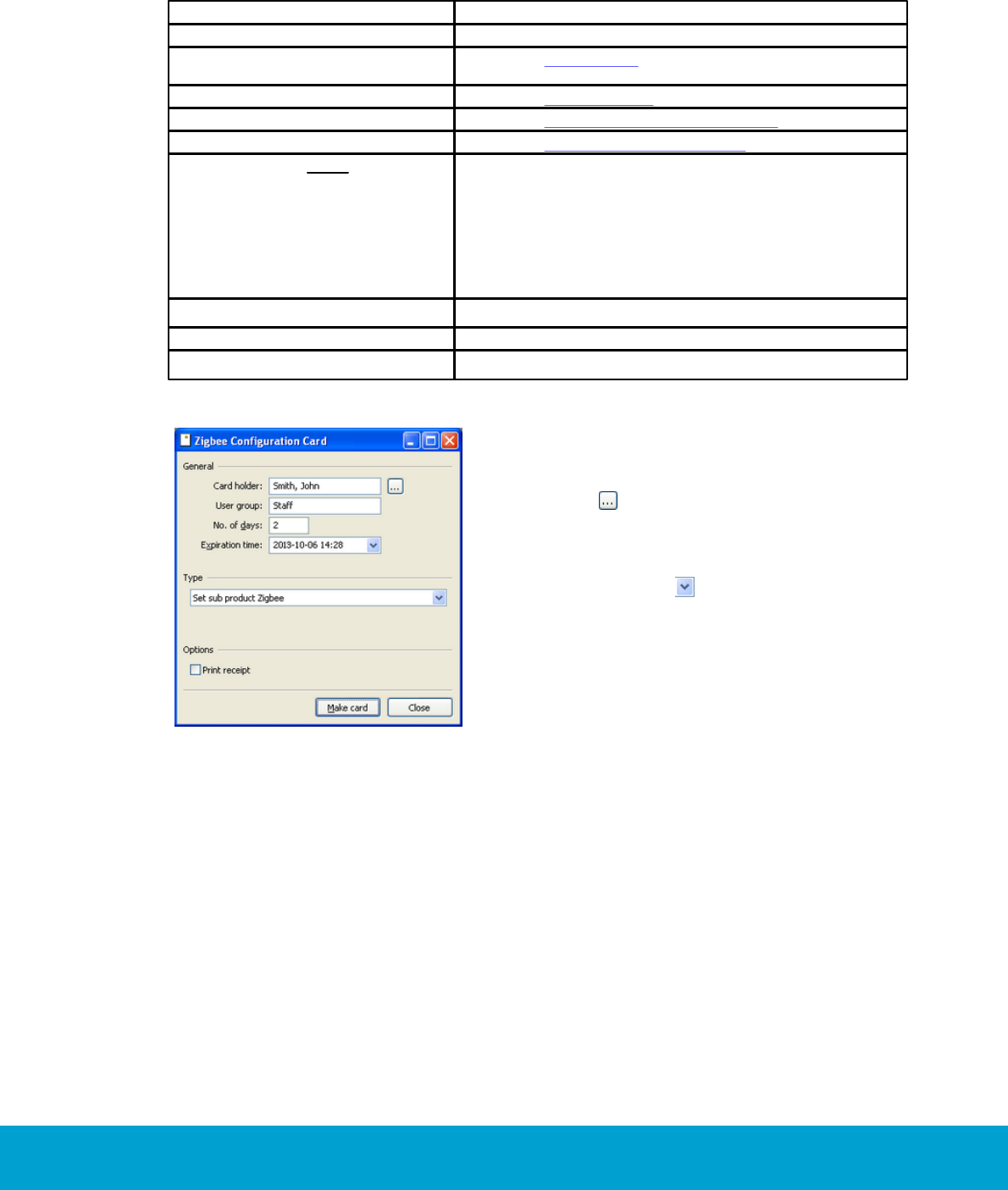
42
ASSA ABLOY Hospitality 66 3081 004-22
5. Issuing a ZigBee configuration card
The ZigBee configuration cards are smart/4k cards that are used for setting up online
locks of ZigBee type. The following cards are available:
Type
Description
Set subproduct ZigBee
Sets the lock in ZigBee mode
Start discovery in ZigBee
See section 1.8 Discovery. This card also sets the lock in
ZigBee mode.
Start orphan join in ZigBee
See section 1.9 Orphan join.
Check ZigBee status
See section 7.3 Check online status with card
Construction mode
See section 6.3 Set in construction mode
Enable EMI events Note: This also
requires the enable EMI events option.
See below the EMI events that are sent to the thermostat from
the lock:
- 0. Guest entrance
- 1. Staff entrance
- 2. Inside open
- 3. Dead-bolt thrown
- 4. Dead-bolt released
- 5. Door closed
- 6. Battery status
Disable EMI events
Remove all sub products
Removes all sub products from the lock
Table 4
Figure 46
1. Double click on ZigBee configuration in the
navigation window.
2. Select a cardholder from the operator list by
clicking the button; double click on a name
or mark the name and click Select.
3. Choose the expiration time of the card: enter
the number of days for which the card shall
be valid, or click the button next to the
Expiration time field and mark a date in
the calendar (or enter a date manually).
The chosen date will appear at Expiration
time; the number of days will change
accordingly.
4. At Type, choose the applicable card type;
see the list of available cards above for
more information.
5. If you want a receipt for the cardholder to sign,
check Print receipt. If you want an additional
text of your own choice, you can add this
under Tools/Options/Printer/Receipt,
'Note on receipt'; maximum 765 characters.
This text will be added to all staff/operator
receipts until it is changed or deleted.
6. Click Make card; present a card at
the encoder.

43
ASSA ABLOY Hospitality 66 3081 004-22
6. System operation
There is a two-way communication with the locks – online commands are sent to the
locks, and the locks send events.
6.1 Events
This section describes the transmission of events from the locks. Events are sent from
the lock as they occur. Should there be any events in the queue, the first queued
event is sent instead.
6.1.1 Acknowledge
If there are any queued events, the lock will send the next event when the EN sends
an acknowledgement to the lock. The acknowledgement will be delayed by the EN for
approximately one minute in order not to flood the network.
6.1.2 Retransmission
If there has been no acknowledgement for two minutes, the lock will retransmit the
first event in the queue.
6.1.3 Fallback
The time between retransmissions will be doubled until it reaches three hours.
As soon as an acknowledgement is received, the retransmission time is reset to two
minutes. If an acknowledgement has not been received after three hours, the last
event from the lock will be retransmitted.
6.2 Online functionality
In the software, several online commands are available. See the section 6.2.1 and
also see the user manual for the client for more detailed information (section about
online commands for a door and section about the Online tab; for cancellation of
card, section about card list). Certain situations give an alarm; see section 6.2.2 for
more information.

44
ASSA ABLOY Hospitality 66 3081 004-22
6.2.1 Commands
The commands that are sent online to the locks include:
Room move (only applicable for hotel systems; add a card to the new room
and cancel it from the old room, and/or change the card expiration time)
Check-out of guest; only applicable for hotel systems
Cancellation of card
Sending of parameters; time, calendar etc
Remote open/stand open/emergency open and
clear stand open/emergency close
Blocking and unblocking of user groups
Read-out of missing events
6.2.1.1 Buffered commands
Some commands (but not interactive commands) can be buffered. Regardless of in
what order the commands have been buffered, they will be sent according to the
following priority:
1. Define local card (elevator, entrance)
2. Emergency open and close
3. Cancel
4. Anti-passback block and unblock
5. Checkout
6. Auto unblock
7. Auto block
8. Other buffered commands
6.2.2 Alarm list
Alarms are situations that require immediate action, e.g. offline lock.
Alarms are shown in the alarm list of the server software, and also in the Alarms
view of SysMon. These alarm lists show all types of alarms, online related as non-
online related; e.g. housekeeping failed.
The alarms can be used as a work order system. From the alarm list it is possible
to assign an alarm to a user. If the Communication option is used, the assigned
user can get an e-mail and/or SMS when the alarm is triggered. The user can
then acknowledge the alarm, i.e. confirm that he intends to take care of the matter.
When the matter has been taken care of, the alarm should be marked as completed
in the alarm list of the server software. Some alarms are however auto-completed,
e.g. when the system detects that they have been attended to they are automatically
marked as 'Auto-completed' in the alarm list. See the user manual for the client for
more information about the alarm list.
From the user notification list of the software it is possible to define which users that
should be notified by e-mail or SMS (requires the Communication option) when
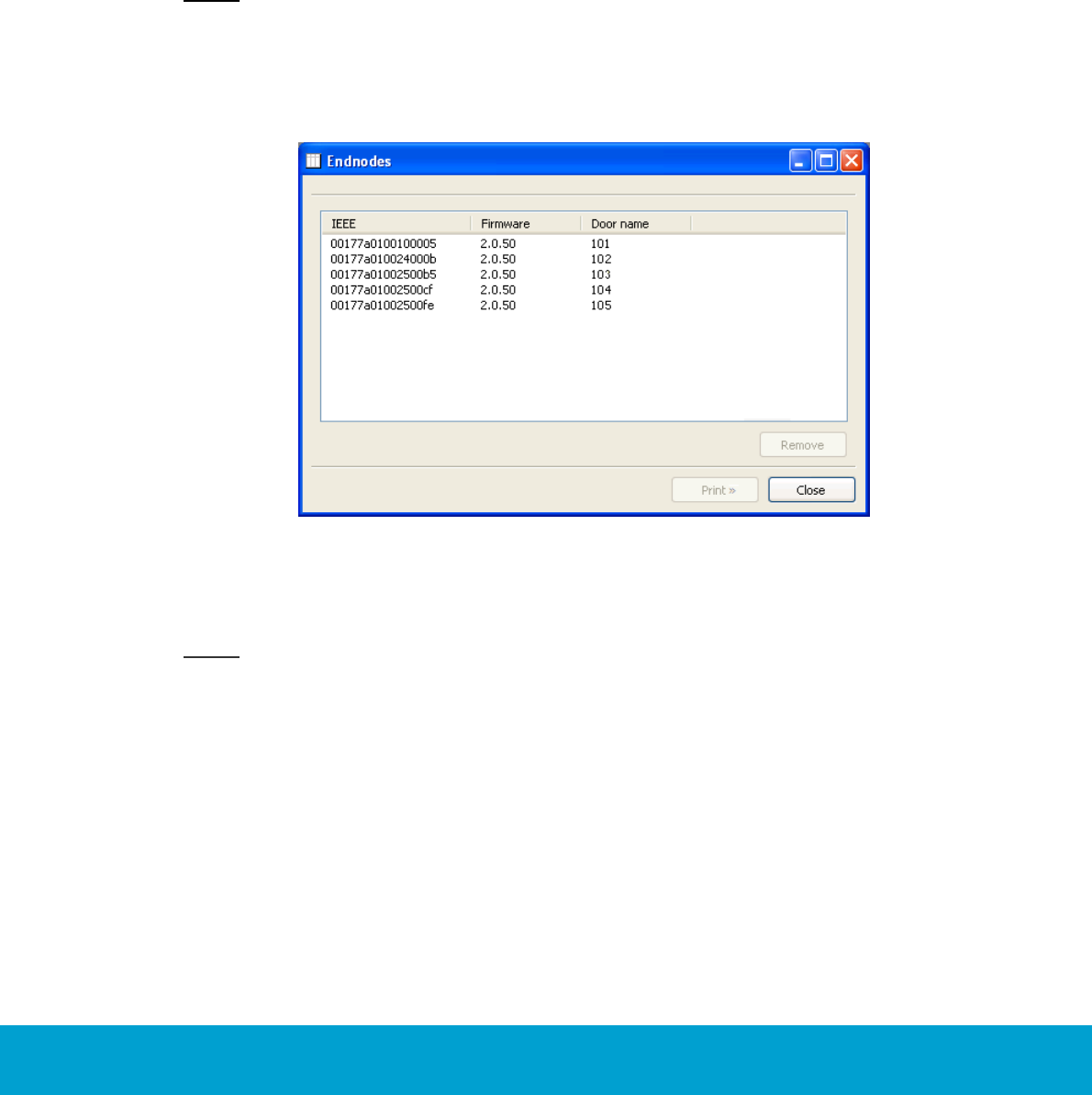
45
ASSA ABLOY Hospitality 66 3081 004-22
alarms occur. From the user notification list, it is also possible to set up that reports
should be sent via e-mail. The reports can either be alarm reports, or reports about
items that do not trigger alarms; e.g. a summary of issued cards.
See Installation instruction Communication option for more information about the
user notification list and other features of the Communication option.
6.2.3 Endnode list
The endnode list in the software shows ZigBee endnodes in the system with IEEE
address, firmware version and door name.
Note: Endnodes in thermostats are not shown in the list.
To remove an endnode from the endnode list:
1. Double click on Endnodes under the Lists tab in the navigation window.
Figure 47
2. Mark the endnode in the list and click Remove. The endnode will
automatically also be removed from the treeview in SysMon.
Note: If a * is shown in the dialog caption, one or more endnodes have been added,
removed or renamed. In this case, press the Refresh button in the endnode list.
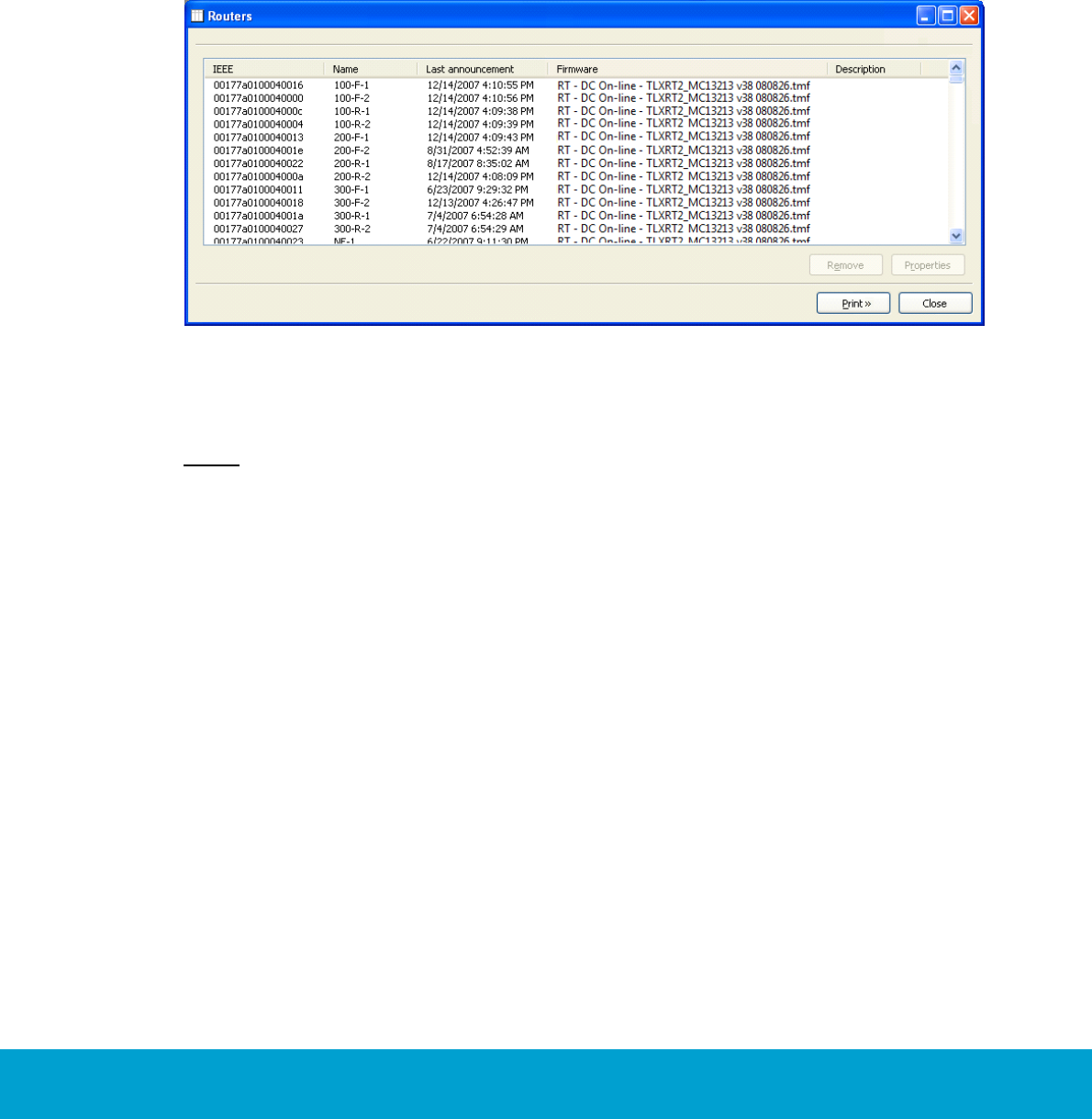
46
ASSA ABLOY Hospitality 66 3081 004-22
6.2.4 Router list
The router list in the software contains all ZigBee routers in the system. The date
column shows the last time the router announced itself. In case a router has been
physically replaced there will be duplicates in the router list, but the last
announcement time gives a hint of which router should be deleted.
To remove a router from the router list:
1. Double click on Routers under the Lists tab in the navigation window.
Figure 48
2. Mark the router in the list and click Remove. The router will automatically
also be removed from the treeview in SysMon.
Note: If a * is shown in the dialog caption, one or more routers have been added,
removed or renamed. In this case, press the Refresh button in the router list.
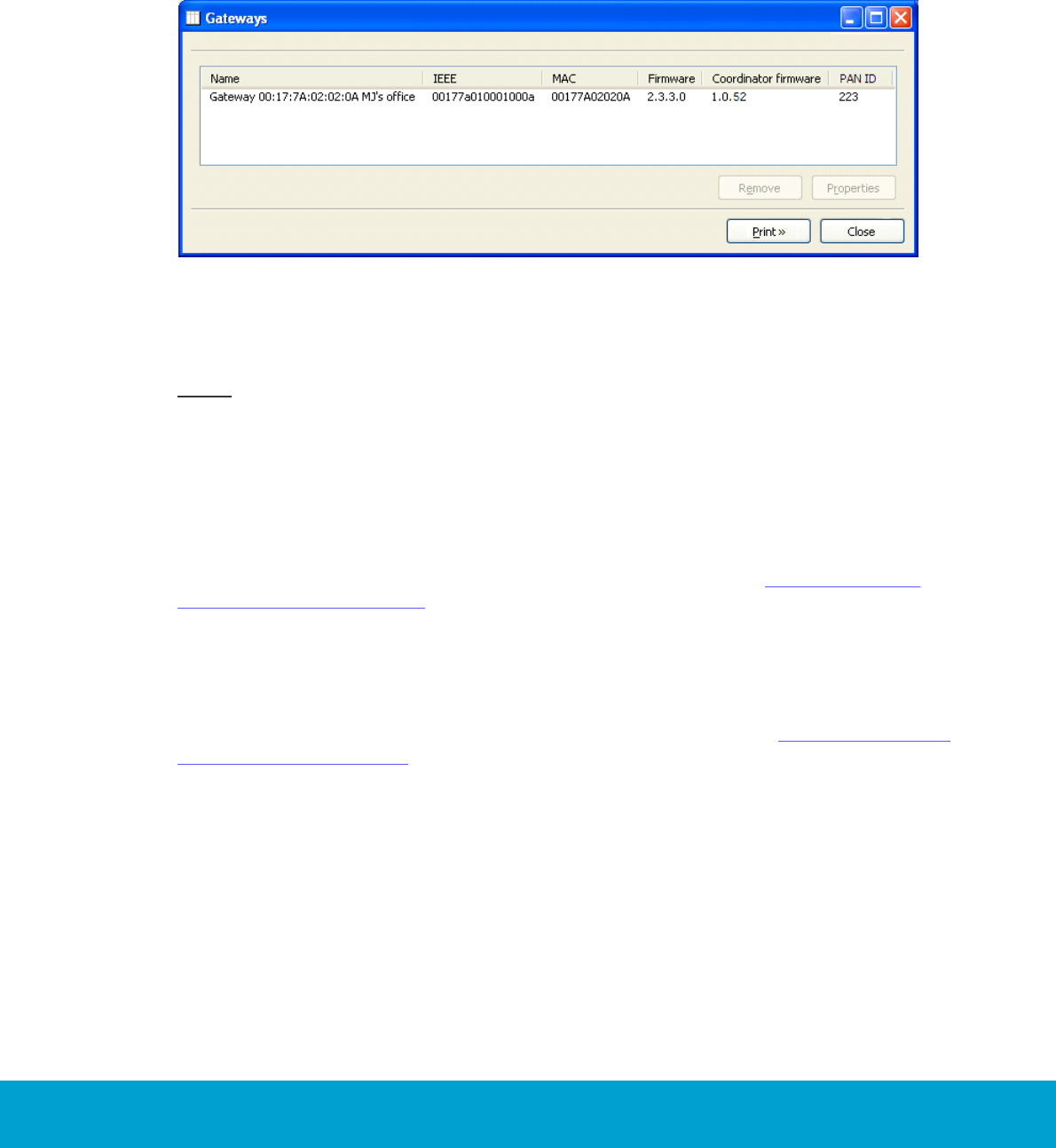
47
ASSA ABLOY Hospitality 66 3081 004-22
6.2.5 Gateway list
The gateway list in the software contains all ZigBee gateways in the system.
To remove a gateway from the gateway list:
1. Double click on Gateways under the Lists tab in the navigation window.
Figure 49
2. Mark the gateway in the list and click Remove. The gateway will
automatically also be removed from the treeview in SysMon.
Note: If a * is shown in the dialog caption, one or more gateways have been added,
removed or renamed. In this case, press the Refresh button in the gateway list.
6.3 Setting in construction mode
If the network should be down for a period, e.g. during construction or renovation
of the hotel, the locks should be set in construction mode to reduce battery
consumption. Present a Construction Mode card at the locks (see chapter 5 Issuing
a ZigBee configuration card); each lock will chirp and/or a show a green LED signal,
depending on lock model. When the card is presented, the EN will be turned off.
If the EN in the lock is busy when the card is presented, instead a tick is heard and/or
a very short green LED signal is shown. In this case, make a new try by presenting
the Construction Mode card at the lock again.
To turn the EN on again, present a Discovery card at the lock; see chapter 5 Issuing a
ZigBee configuration card.
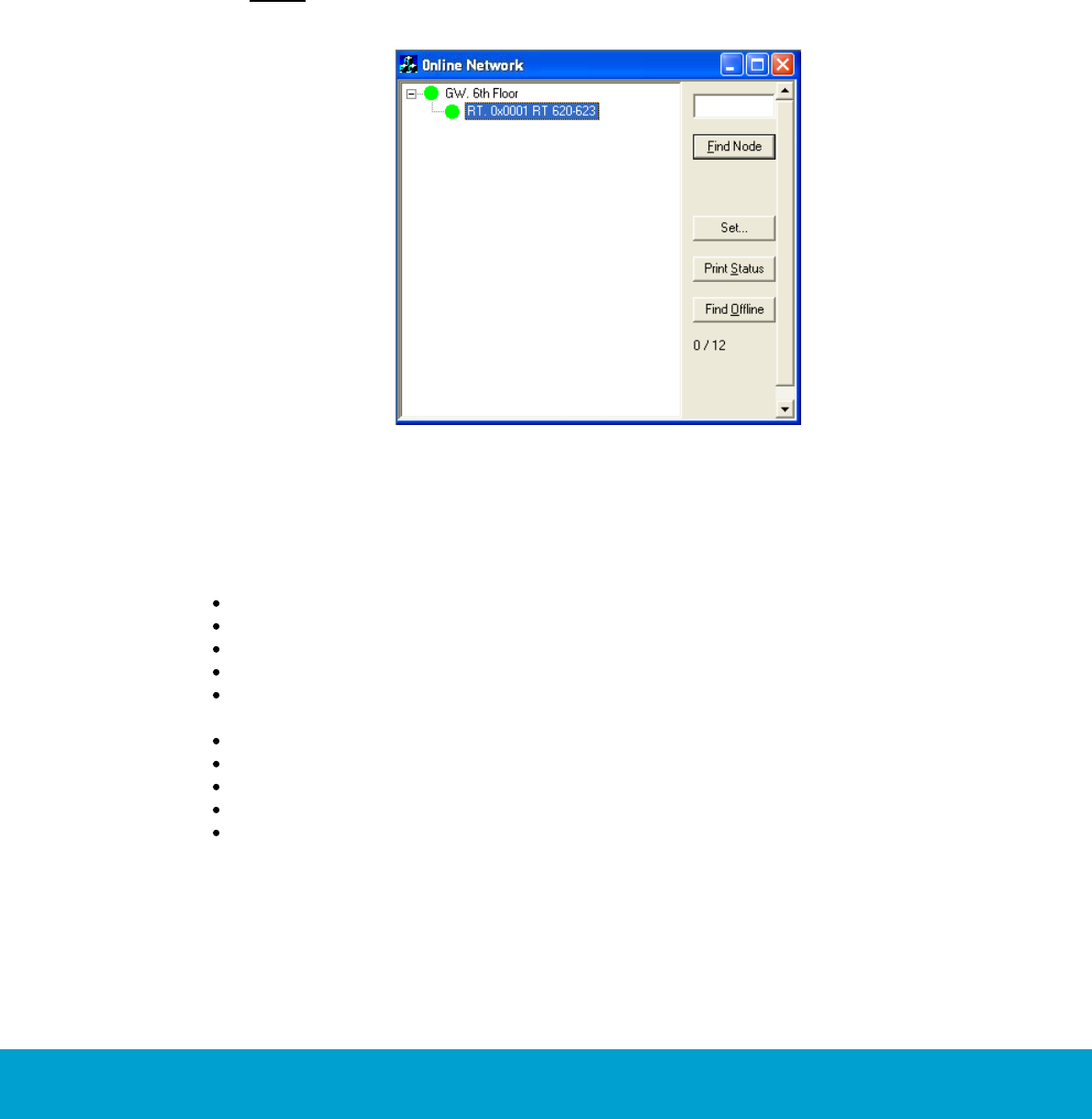
48
ASSA ABLOY Hospitality 66 3081 004-22
7. Commissioning
7.1 Printing a status report
SysMon provides a simple method for printing out the status of all the connected
devices in the online network.
1. In the Online Network view in SysMon, click the Print Status button.
Note: When clicking Print Status, it is possible to choose where to save
the status report.
Figure 50
2. A Microsoft Excel spreadsheet will be written to the TempData folder in your
installation folder.
The spreadsheet provides detailed information for each connected RT and EN; see
example screenshot on next page. The information written to the document includes:
name of the PAN (GW) the device is connected to
RT name
room; if it is an EN
IEEE address
version for RT, EN or GW; in the last case, GW firmware as well as version in
the PAN coordinator (PC) are stated
network address
average link quality between the device and its parent
time that last LQI measurement was taken
last link quality index (LQI) recorded
time for last successful command since the server was restarted; if this column
says 'n/a', there has not yet been any answer from the lock
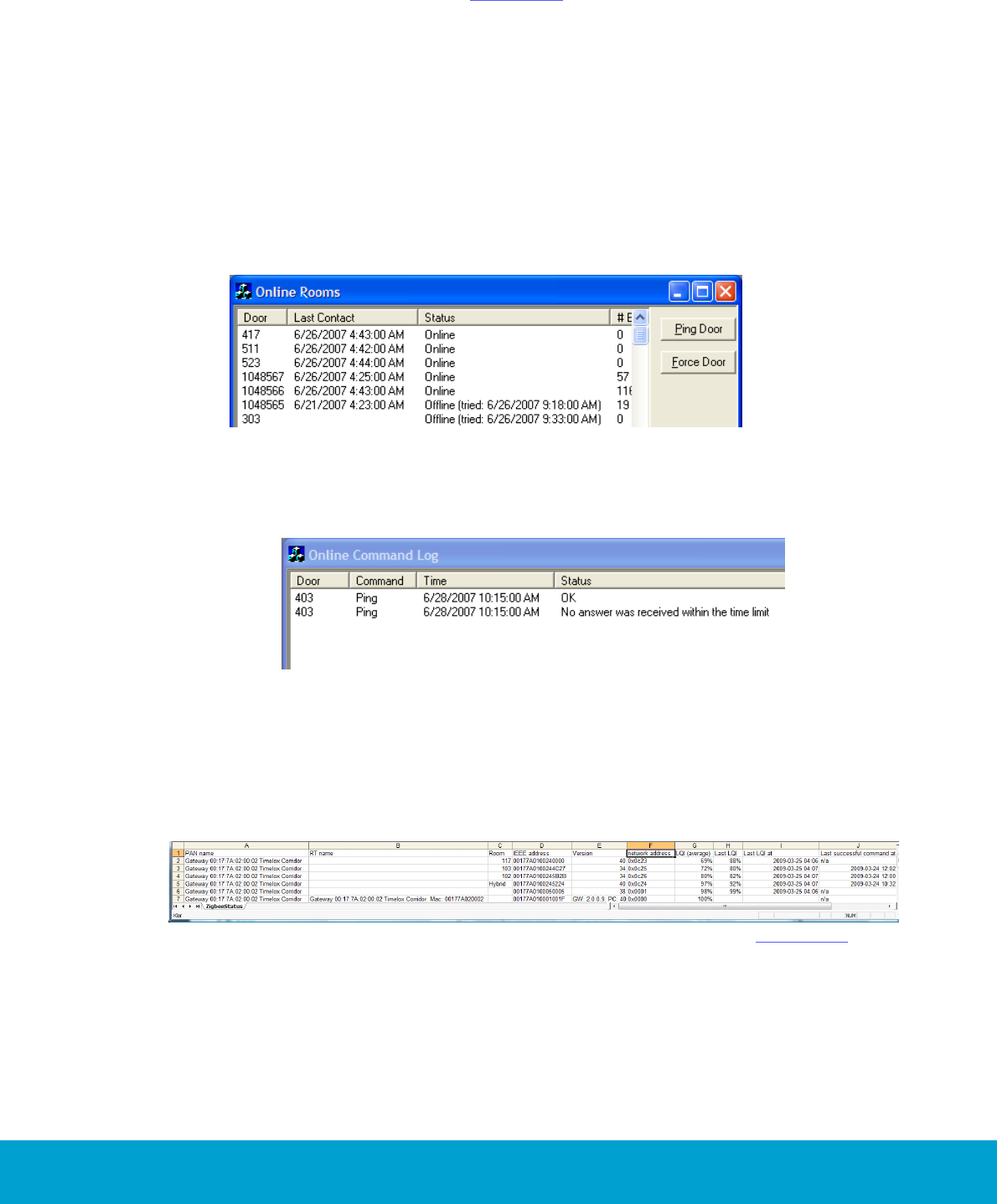
49
ASSA ABLOY Hospitality 66 3081 004-22
7.2 Pinging a door
While the spreadsheet described in section 7.1 is convenient in showing the
communication status of the online devices, it does not show that the locks
themselves are communicating with the server. To do that it is necessary to 'ping'
every online door from SysMon. A ping is a simple 'are you there' message sent from
the server to the lock and back. The ping shows that the lock, the server, and all the
devices in between are operating correctly.
To ping a door in SysMon:
1. Open the Online Rooms window at View/Online Rooms.
2. Mark the door you want to ping and click the Ping Door button on the right.
You will see the status for the door change to offline.
Figure 51
3. At the same time, you should watch the Online Command Log (found at
View/Online Commands) so you can see the Ping command go out.
Figure 52
The status in the Online Command Log will always say 'No answer was received
within the time limit' when the ping first goes out. If the ping is successful a response
of OK will be sent back. If the ping fails you will not receive any other notification.
You should allow up to 25 seconds for a ping to respond before labeling it a failure.
Figure 53: The screenshot shows an example of a status report; see section 7.1 for
more information.

50
ASSA ABLOY Hospitality 66 3081 004-22
As part of the commissioning process it is necessary to show that the server is able
to communicate to every lock. This is shown in the last column of the status report
in section 7.1. If the server has been restarted, the last column of the status report
will show 'n/a' for all locks – in this case the Broadcast Answers dialog can be used
to determine whether the locks have answered or not, for all broadcast commands
except for 'Ping'. See the user manual for the client for further information about
Broadcast Answers.
As each floor or wing is completed, sign off on the status report to indicate that all
of the online devices are communicating and the server is able to communicate with
the locks.
7.3 Checking online status with card
To check the online status directly at the lock, a Check ZigBee Status card can be
used; see chapter 5 ZigBee configuration card. When the card is presented at the
lock, a check is made whether the EN in the lock has still got contact with its parent
or not. If a chirp is heard when the card is presented at the lock, the lock is online;
if an error beep is heard and/or three red LED signals are shown (depending on lock
model) when the card is presented, the lock is offline. If the EN in the lock either is
busy at the moment or is connected to the LCA (lock case adapter; for lock types
where this is applicable), a tick is heard and/or a very short green LED signal is
shown instead. In this case, make a new try by presenting the Check ZigBee Status
card at the lock again.

51
ASSA ABLOY Hospitality 66 3081 004-22
8. Power loss and hardware failure
This section describes the mechanisms in place to recover from power loss as well as
instructions to replace devices in case of hardware failure.
8.1 Lock electronics
If the lock electronics (not the online EN radio) have gone bad, they can be replaced
with no interruption to the online network. Replace the lock electronics and put the
lock back together. If power was temporarily disconnected from the EN, it will rejoin
its parent on power up.
8.2 Endnode
If an EN loses power - typically due to a dead battery or battery replacement -
it will rejoin its parent on power up using an orphan join. The radio ID is already in
the appropriate RT and so it is allowed to join again without requiring a technician to
re-open the RT.
If an EN needs to be replaced:
1. Make a leave on the old EN: right click on the EN in SysMon's Online Network
view and choose Leave Network. In this way the old EN will deregister from
the parent.
Note: Due to a bug in BeeStack radio nodes of versions before 1.0.49, do not
use the Leave Network command for these older versions.
2. Important: Wait for 40 seconds to avoid confusing the parent from which the
EN has deregistered.
3. Make Permit Joining on the RT to which the EN should be connected. This can
be done either by right clicking on the RT in SysMon's Online Network view
and choosing Permit Joining, or by pressing the F1 button on the RT.
4. Once Permit Joining has been made on the RT, install the new EN device in
the lock. When it is powered up, present a Discovery card at the lock (see
chapter 5 Issuing a ZigBee configuration card); the lock will chirp once and/or
show a green LED signal, depending on lock model. The EN will announce itself
to the server.
5. After the EN has joined the network, make Forbid Joining on the RT by right
clicking on the RT in SysMon’s Online Network view, or by pressing the F1
button on the RT.

52
ASSA ABLOY Hospitality 66 3081 004-22
8.3 Router
If an RT loses power none of its children will be able to communicate to the server.
When an RT loses power it will send a special SOS message to the server at least
once to indicate that power may have been disconnected.
A power cut is illustrated with a red dot in front of the RT in SysMon:
Figure 54
It can take up to three hours for the ENs to get online after recovery from a power
cut. Upon power up the RT will perform an orphan join and will rejoin its parent GW
or RT. Any children (EN or RT) will rejoin the RT automatically by performing orphan
joins after they realize they have lost their parent.
To expedite this process in ENs:
1. Present an Orphan Join card at the door lock of each EN (see chapter 5
Issuing a ZigBee configuration card); each lock will chirp once and/or show a
green LED signal, depending on lock model.
This may be a necessary step if the RT has been without power for an extended
period of time as the ENs will only attempt an orphan join every so often (i.e. every
three hours) in an attempt to conserve power.
If an RT needs to be replaced, the 'Permit Joining' command is used:
1. Make a leave on the old RT: right click on the RT in SysMon’s Online
Network view and choose Leave Network.
In this way the old RT will deregister from the parent.
Note: Due to a bug in BeeStack radio nodes of versions before 1.0.49, do
not use the Leave Network command for these older versions.
2. Important: Wait for 40 seconds to avoid confusing the parent from which the
old RT has deregistered.
3. Choose Permit Joining on the GW that the new RT should associate itself
with.
4. Press the F1 button when powering up the new RT. The RT will make a
discovery, i.e. it will search for and join the GW on which Permit Joining has
been made. After this, choose Forbid Joining on the GW.
5. Make Permit Joining on the new RT. This can be done either by right
clicking on the new RT and choosing Permit Joining, or by pressing the F1
button on the new RT. Present a Discovery card at the door lock of each EN
that should associate with the new RT; each lock will chirp once and/or show
a green LED signal, depending on lock model. For more information about the
ZigBee configuration card, see chapter 5 Issuing a ZigBee configuration card.
6. Each EN will search for and join the new RT on which Permit Joining has
been chosen. After this, make Forbid Joining on the new RT. This is done
either by right clicking on the new RT and choosing Forbid Joining, or by
pressing the F1 button on the new RT.

53
ASSA ABLOY Hospitality 66 3081 004-22
8.4 Gateway
If a GW loses power, none of its children (RT or EN) will be able to communicate to
the server. A power cut is illustrated with a red dot in front of the GW in SysMon:
Figure 55
Note: If a GW is replaced, the entire commissioning process must be performed
again; see sections 3.2-3.7.
8.5 Server
If the server loses power, no commands can be sent to the locks. When the server is
recovered it will need to query the locks to retrieve any events it may have missed
while it was down.

54
ASSA ABLOY Hospitality 66 3081 004-22
9. Redundancy and recovery
9.1 Communication channel
The ZigBee communication protocol has the built in capability to communicate on any
one of 16 different channels (or frequencies). In the event that one or more channels
are blocked or do not allow for adequate signal strength and stability, other channels
may be used. Important: The ZigBee communication can be disturbed by e.g. Wi-Fi
networks; always make sure to have as long distances as is physically possible
between ZigBee devices and other radio equipment. It is also possible to use the Set
all coordinators checkbox in the Select channels dialog; see details below. If Wi-Fi
disturbance still causes problems at a site, automatic channel change can be enabled.
See more information about automatic channel change in section 9.1.1.
If there are circumstances that dictate the devices should communicate on a specific
channel (i.e. if there are other online devices or known interference on other
channels), it is possible to force the devices to stay on a specific channel.
1. Right click on the concerned GW in SysMon's Online Network view and
choose Set channels; a dialog as in Figure 56 will be shown.
Figure 56
2. By default, all 16 channels are checked since the GW will normally choose
which of the 16 channels in the 2.4GHz band the nodes in the PAN should
use. If a specific channel should be used, click Clear to uncheck all channels.
3. Check the desired channel(s); if more than one channel is checked, the best
one will be chosen.
4. If the chosen channel(s) should be used for all GWs in the system, mark the
checkbox Set all coordinators.
5. Click OK.

55
ASSA ABLOY Hospitality 66 3081 004-22
9.1.1 Automatic channel change
Note: Automatic channel change requires Visionline 1.12.2 or higher.
Note: Contact Technical support for details about how to enable automatic
channel change.
The channel is automatically changed if:
more than 25% of the end nodes are offline or have an LQI less than 30%
(requires the Orion EMS option) more than five offline alarms have been
received from the same thermostat during the last 24 hours; these alarms
are triggered when the thermostat detects that a motion detector, lock or
door switch is offline
The new channel is accepted if all routers report back within 15 minutes. If not,
a new channel is selected. When the new channel has been accepted it will be
retained during at least 24 hours even if the conditions above are met. At automatic
channel change, all 16 channels are used regardless of the channels selected by
the user.
9.2 Recovery
9.2.1 Polling
In order to preserve the battery, the ENs use a scheme called polling. Each EN wakes
up periodically to check (poll) its parent for messages. Any message for the node is
sent as an answer to the poll. The polling is the reason of variable answering times.
9.2.2 Fallback
If the poll does not give any answer five successive times, the EN has a fallback
procedure. The missing answer can have two causes:
the parent is offline due to a power cut
the channel is jammed
In the latter case, follow steps 1-3 in section Communication channel to choose
another channel. The EN will start orphan joining as a fallback, but continue to
send polls even after this. This will find the parent in case there has been a
channel switch. It will also find the parent in case there has been a power cut
and the power returns. Due to the high power consumption of orphan joining,
it will be performed at very long intervals:
Initially, the interval will be one minute.
For every time the orphan join fails, the interval is doubled until it reaches
three hours.
Note: RTs have the same functionality, but as they are powered externally they
will make an orphan join every 30 seconds.
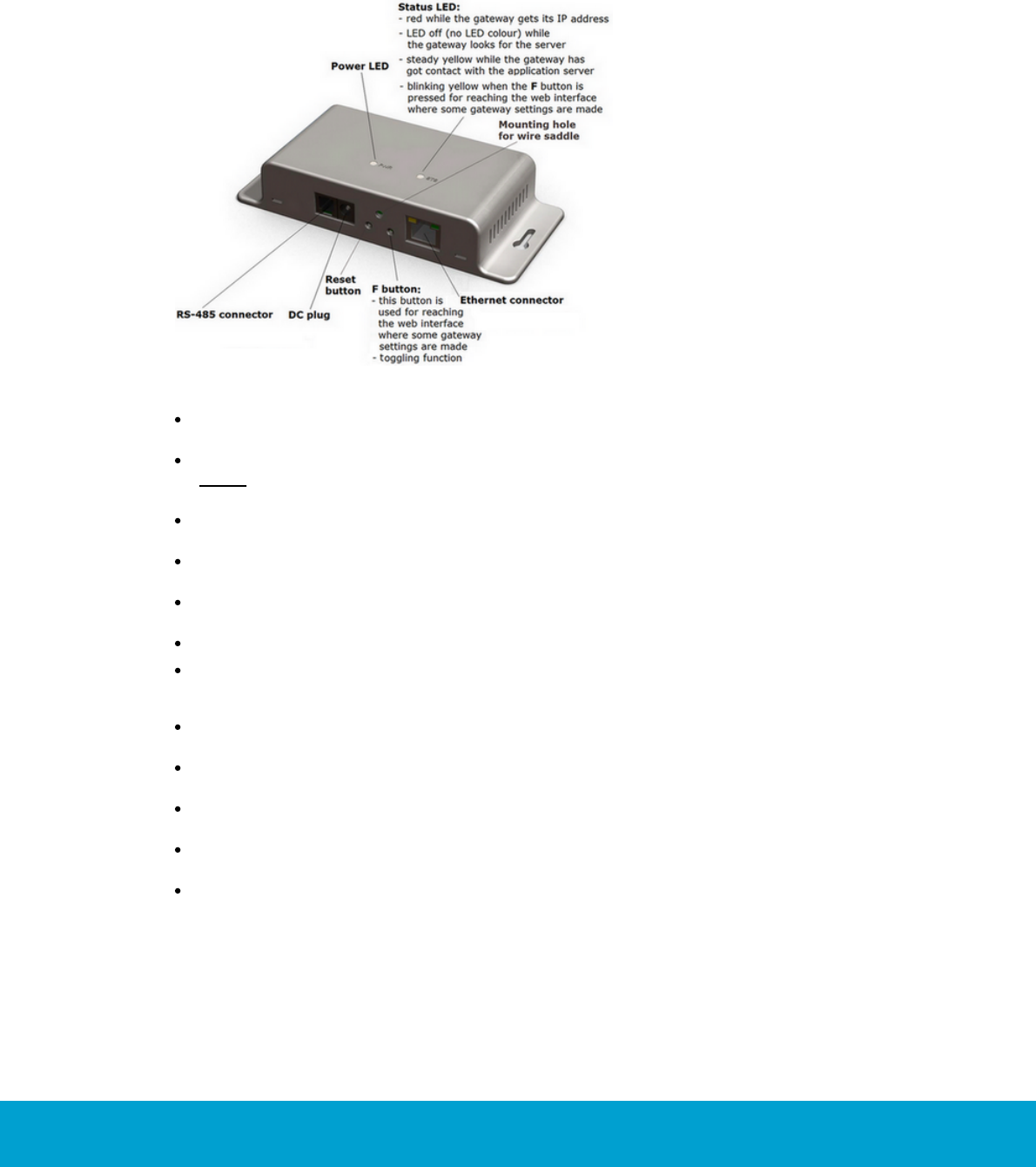
56
ASSA ABLOY Hospitality 66 3081 004-22
Appendix A: Online devices
Gateway
Figure A1
Automatic adjustment to 10 or 100 Mbit/s networks
Powered via Ethernet or by a power adapter (5VDC)
Note: The gateway is of PoE class 1; power range 0.44-3.84W.
Low power consumption
The total number of gateways is virtually unlimited
Can have either five routers or 15 endnodes connected as direct descendants
Case with the dimensions 63 mm x 144 mm x 27,5 mm (2,48" x 5,67" x 1,08")
Easy mounting (can be mounted either with adhesive VELCRO® strips or fastening screws;
a package with two VELCRO® strips and two fastenings screws are enclosed)
Weight: 116 g
Flame retardant ABS
UL94 V-0 approved
Colour: RAL 7047
Suitable for operation in the range 5-50º C and
10-90% non-condensed relative humidity
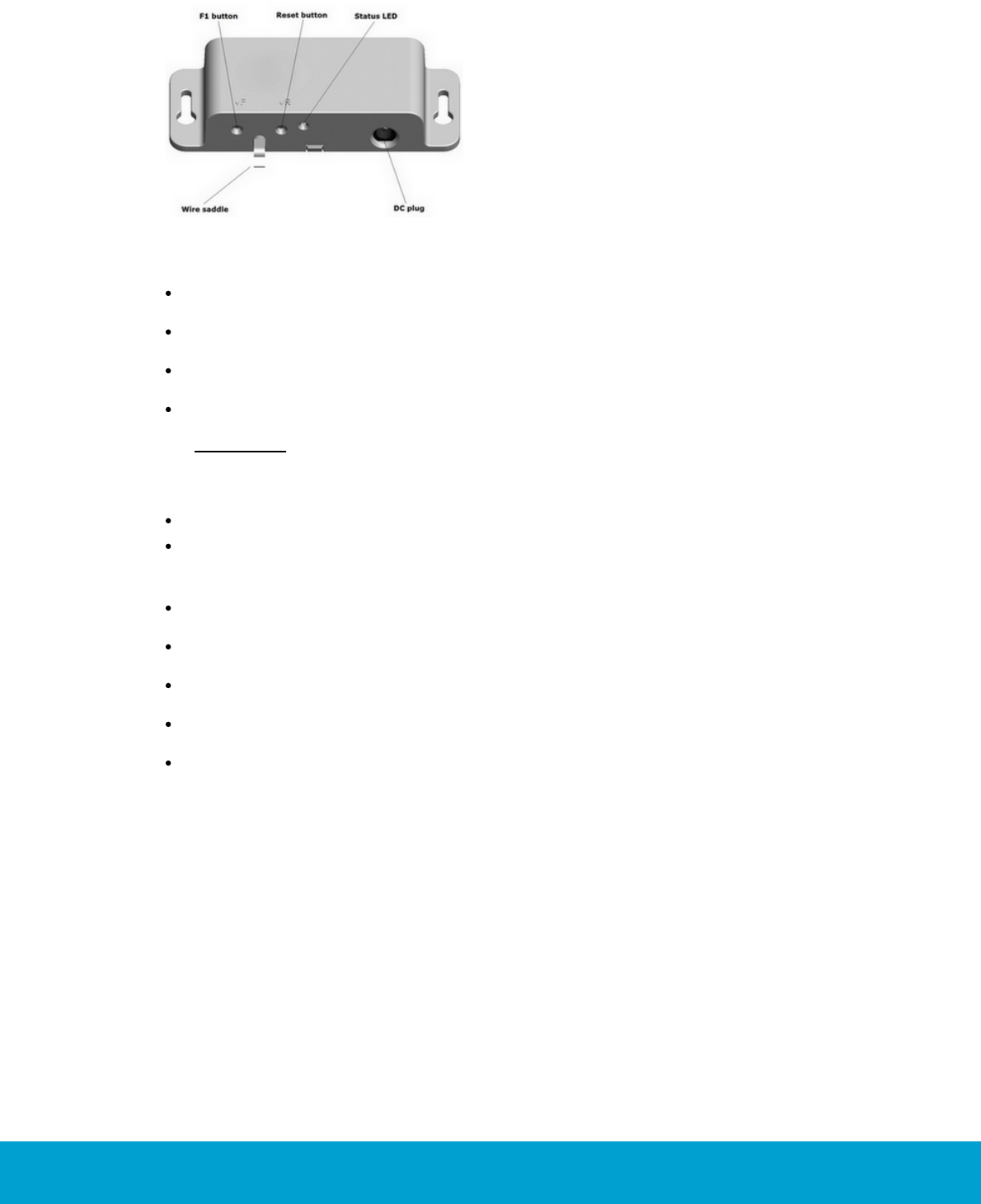
57
ASSA ABLOY Hospitality 66 3081 004-22
Router
Figure A2
Powered by a power adapter (5VDC)
Low power consumption
Can have either five routers or 15 endnodes connected as direct descendants
There can be a maximum of five hops down the gateway (i.e. gateway - router - router -
router - router - endnode). This limits the physical coverage of a PAN.
Important: Even though it is possible to have five hops, it is recommended to
have maximum three hops, i.e. gateway - router - router - endnode. The link
quality index (LQI) should be at least 30%.
Case with the dimensions 40 mm x 105 mm x 19,5 mm (1,57" x 4,13" x 0,77")
Easy mounting (can be mounted either with adhesive VELCRO® strips or fastening screws;
a package with two VELCRO® strips and two fastenings screws are enclosed)
Weight: 36 g
Flame retardant ABS
UL94 V-0 approved
Colour: RAL 7047
Suitable for operation in the range 5-50º C and
10-90% non-condensed relative humidity
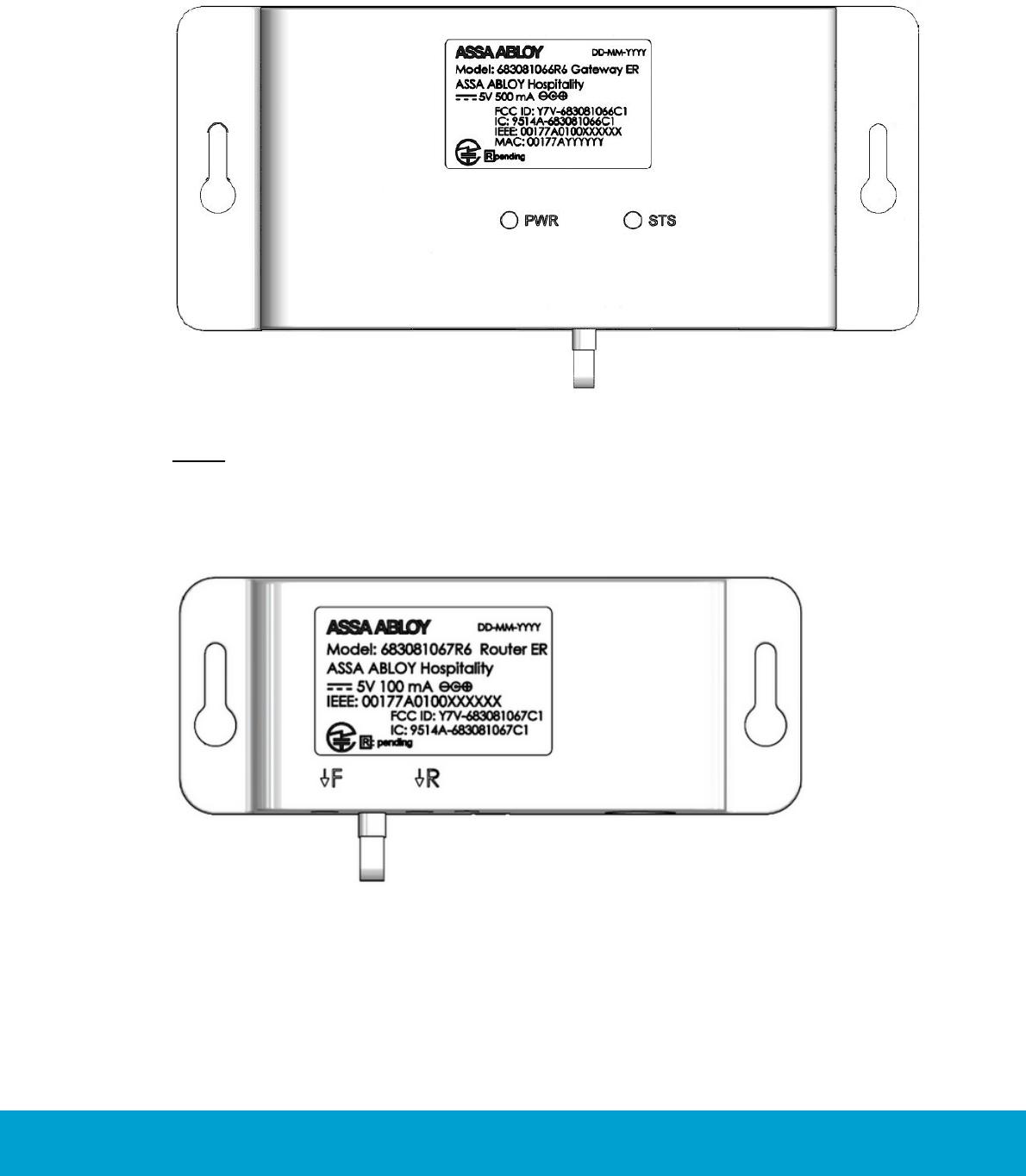
58
ASSA ABLOY Hospitality 66 3081 004-22
Appendix B: Mounting of gateway and router
Preferred way of mounting the gateway is horizontally on the wall:
Figure B1
Note: The older type of gateway (9VDC) should be mounted vertically.
Preferred way of mounting the router is horizontally:
Figure B2
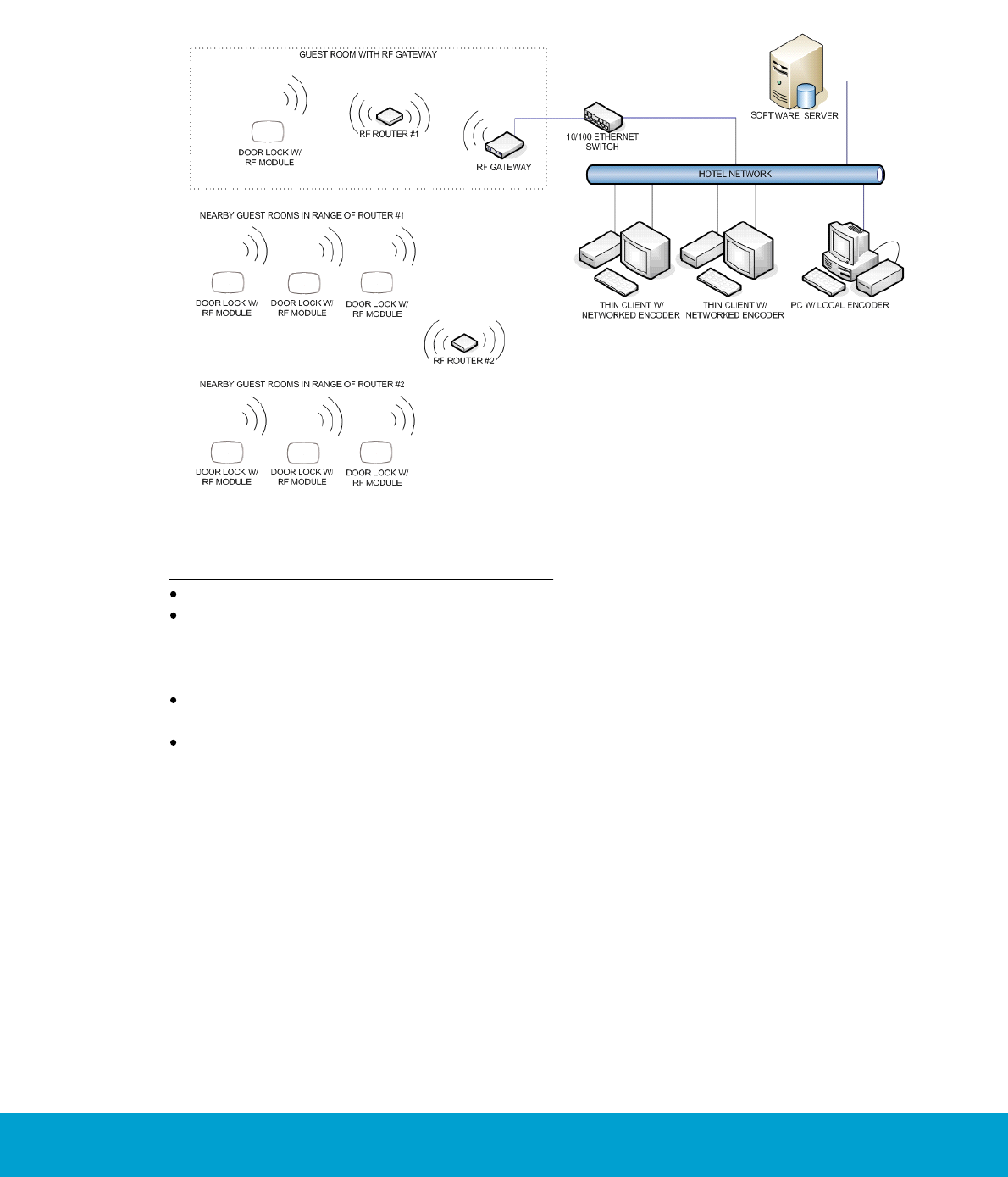
59
ASSA ABLOY Hospitality 66 3081 004-22
Appendix C: Example configurations
Several online configurations are possible. Here are some examples:
Figure C1: Basic setup with GWs, RTs and no firewall
Notes for the configuration in Figure C1:
RF door locks communicate with RF routers; maximum 15 locks per router.
RF routers 1 and 2 communicate with the Rf gateway (it is recommended to have
maximum three hops down the gateway, i.e. gateway - router - router - door lock,
and an LQI, link quality index, of at least 30%). Routers are powered by a 5VDC
plug-in transformer.
RF gateways communicate with the application server over the Ethernet network
of the property. Gateways are powered by a 5VDC plug-in transformer.
The application server communicates to client stations and networked
card encoders via the network of the property.
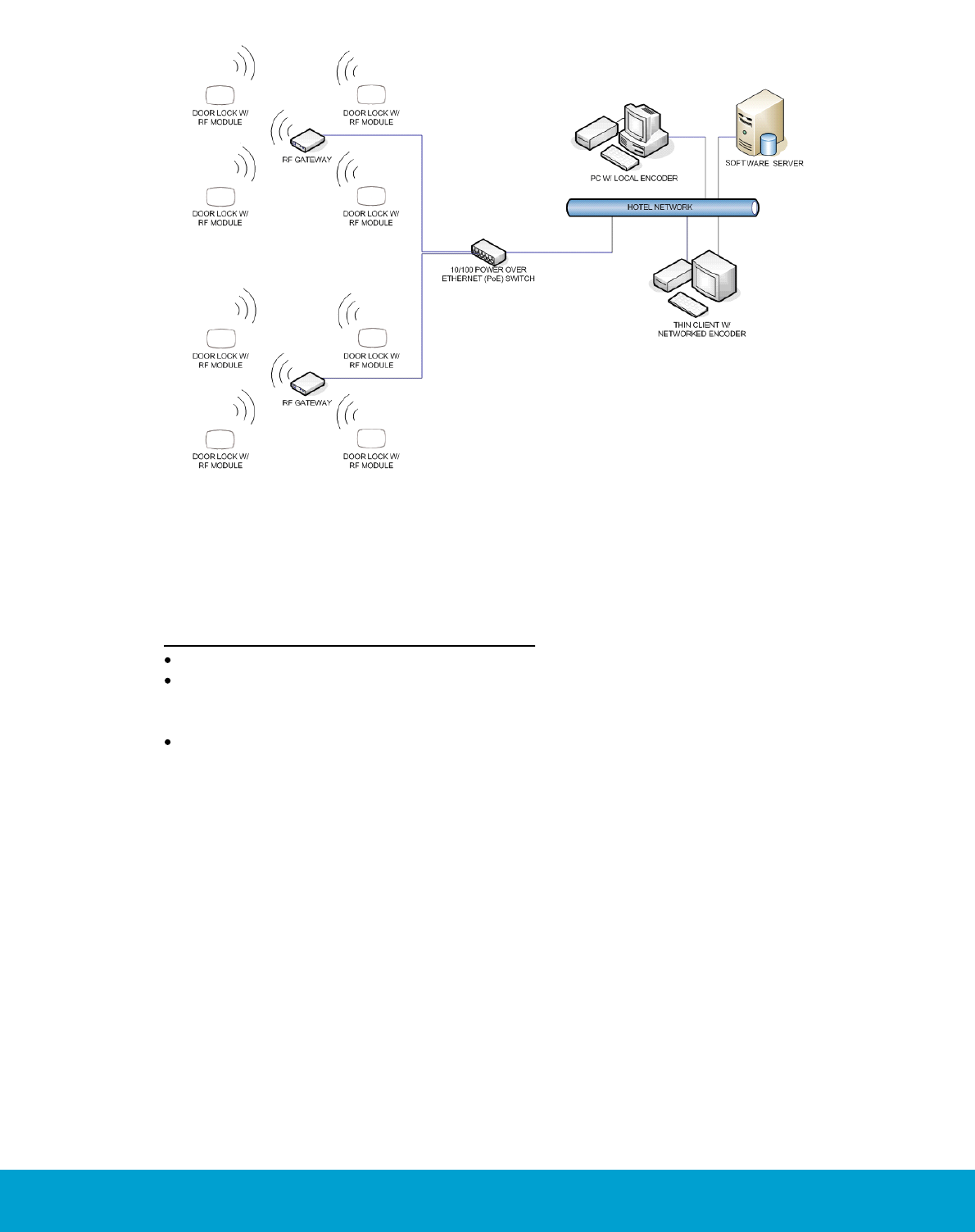
60
ASSA ABLOY Hospitality 66 3081 004-22
Appendix C: Example configurations
Figure C2: GWs using Power over Ethernet (PoE) communicating directly with doors.
Notes for the configuration in Figure C2:
RF door locks communicate with RF gateways; maximum 15 locks per gateway.
RF gateways communicate with the application server over the Ethernet network
of the property. Gateways are powered centrally by a PoE (Power over Ethernet)
network switch.
The application server communicates to client stations and networked card
encoders via the network of the property.
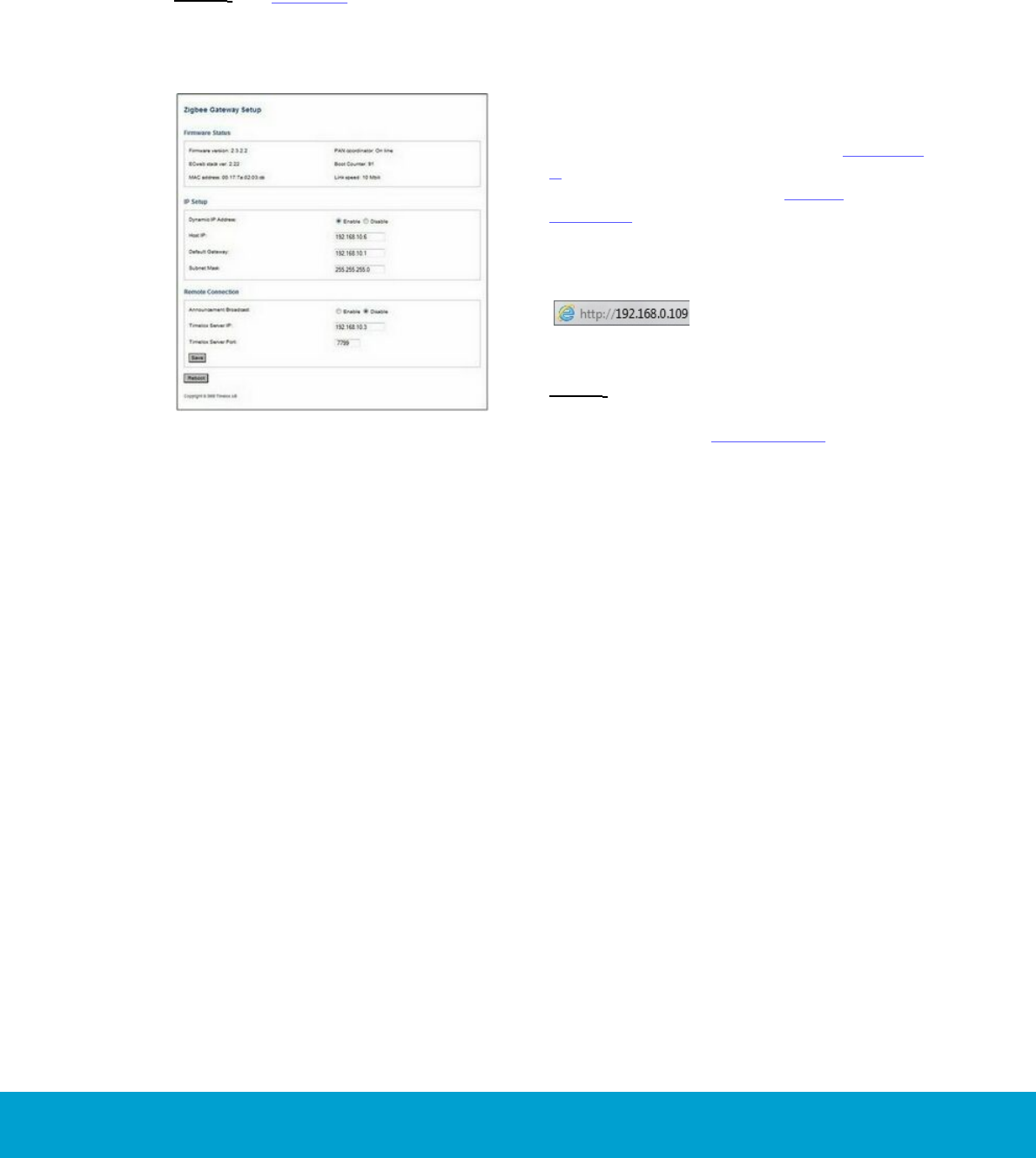
61
ASSA ABLOY Hospitality 66 3081 004-22
Appendix D: Web interface for gateway
The gateway parameters can be modified to suit the network where the gateway is
located. This is done via the web interface as described below.
Note: See Table E1 in Appendix E for a description of the gateway parameters.
To modify the gateway parameters:
Figure D1
1. Press the F button on the gateway for a
short while; the status LED on top of the
gateway will blink yellow. See in Appendix
A where the F button is located.
2. In the web browser, enter http://
ipaddress; the IP address to enter is shown
when hovering over the gateway in
SysMon. See example below for IP address
entered in the web browser:
Figure D2
Note: If no DHCP server is available, use
the zero config IP address which is shown
in Wireshark; see section 1.3.1 for more
information about zero config.
3. Make the desired changes in the ZigBee
Gateway Setup page; see example in
Figure D1.
4. If the server IP should be changed and
there is no DNS (Domain Name System):
- Enter the applicable Server IP
OR
- Mark the radio button 'Enable' for
Announcement Broadcast; this makes
the gateway find the server.
5. When all desired changes have been done
in the ZigBee Gateway Setup page:
- Click Save.
- Click Reboot.
- Press the F button on the
gateway again.

62
ASSA ABLOY Hospitality 66 3081 004-22
Appendix E: Reset of gateway
If the gateway parameters need to be reset to default values, e.g. if a gateway should
be used at a demo installation, press and hold the F button while powering up the
gateway.
Parameter
Default value
Dynamic IP address (DHCP; Dynamic Host Configuration
Protocol)
Enabled
Host IP address
192.168.0.100
Default gateway
192.168.0.1
Subnet mask
255.255.255.0
Announcement broadcast
Enabled
Server port
7799
Table E1: Default values and descriptions of gateway parameters

63
ASSA ABLOY Hospitality 66 3081 004-22
Appendix F: Gateway boot-up
1. When a ZigBee gateway comes out of reset, it reads its IP configuration
from a non-volatile memory.
2. If 'Dynamic IP Address' is set to Disable (see Appendix D): the gateway
sets its IP address to the address stored in the config memory. Continue at
step 13 below.
3. If 'Dynamic IP Address' is set to Enable (see Appendix D): the gateway
sends a DHCP Request packet with IP destination address 255.255.255.255,
i.e. IP broadcast, requesting its most recently used IP address.
4. If the network/subnet configuration has not changed, the DHCP server will
most likely send a DHCP ACK packet, allowing the gateway to continue to
use the same IP. The DHCP server may use either IP broadcast or unicast for
this packet; broadcast is however most commonly used. Continue at step 10
below.
5. If the DHCP server is unwilling to let the gateway use the same address as
before, or if the requested IP is out of scope, it sends a DHCP NAK.
6. Then the gateway resets its IP address to 0.0.0.0 and sends a DHCP Discover
packet with IP destination address 255.255.255.255; IP broadcast.
7. If a DHCP server is available, it sends a DHCP Offer packet. Since the gateway
has no valid IP address, the DHCP server must send to IP destination
255.255.255.255; IP broadcast.
8. The gateway receives the offer and sends a DHCP Request packet, as in step 3
above, but this time requests the IP address offered by the DHCP server.
9. The DHCP server sends a DHCP ACK packet, confirming that the gateway may
start using the new IP address. Unlike the ACK in step 4 above, this ACK
packet must be sent to IP destination address 255.255.255.255 (IP broadcast),
since the gateway has not got any confirmed IP address yet.
10.The gateway performs gratuitous ARP (Address Resolution Protocol) to ensure
that no other host has got the same IP.
11.If IP collision is detected, the gateway sends a DHCP Decline packet which
refuses the assigned IP address and restarts the gateway’s IP acquirement
procedure.
12. New functionality, Zigbee gateway version 2.3.0 and later: If there is no DHCP
server available on the subnet, the gateway self-assigns an IP address from the
IPv4 Local Link address space (169.254.0.0/16), and sends gratuitous ARP to
ensure that no other host has got the same IP.
13. The gateway reads the most recently used Visionline server IP address and
tries to open a TCP connection to the server.
14. If the TCP connection attempt fails, the gateway will continue to try
connections to the same IP over and over again – unless it detects that the
network/subnet setup has changed, e.g. the gateway may have been moved to
a new location. Then it will send an application specific service discovery
request (announcement broadcast) with IP destination address
255.255.255.255; IP broadcast.
14 b. New functionality, Zigbee gateway version 2.3.0 and later: Even if the
network/subnet setup is unchanged, but long time (one hour) has elapsed
without any successful TCP connection with the Visionline server, the gateway
will start sending service discovery requests.

64
ASSA ABLOY Hospitality 66 3081 004-22
Appendix F: Gateway boot-up
15. If a Visionline server is on the same subnet, or if another gateway with a valid
TCP connection to the server is on the subnet, they will send a reply
to the querying unit, letting it know the IP address and TCP port of the
Visionline server. The gateway then tries TCP connection to that IP.
15 b. New functionality, Zigbee gateway version 2.3.0 and later: From the payload
supplied in the reply (the reply is sent with IP destination address
255.255.255.255, IP broadcast), the querying unit can determine if its own IP
address properties are correct with respect to network class, default gateway IP
and subnet mask. If required, it will self-assign a new IP-address within the
subnet specified in the reply, and then send gratuitous ARP to ensure that no
other host has got the same IP. Then it goes on and tries TCP connection to the
received server IP address.
16. New functionality, Zigbee gateway version 2.3.0 and later: Prior to sending the
service discovery request, the gateway tries to contact a DNS server (Domain
Name System), with a request for resolving the most recently used Server
Host Name. If that name is unknown to the DNS, the gateway tries to resolve
the factory default Server Host Name. If any of the two names renders a
successful DNS reply, the gateway uses the IP address received from the DNS
server, and tries TCP connections to that address. If the factory default name is
unknown too, or if a DNS server is not available at all, the gateway sends a
service discovery request.
Note: 14, 14 b, (15/15b) and 16 will go on in a round robin way until the gateway
has reached the server.

65
ASSA ABLOY Hospitality 66 3081 004-22
Appendix G: More about how the gateway finds
the server
Introduction
This appendix describes the process of how the gateway finds the server. The solution is
based on DNS (domain name system) as well as on announcement broadcast, which is a
proprietary implementation of zero config.
Note: A general description of setup of DNS entries cannot be made in this document,
since this varies with the type of DNS server that is used.
There are three challenges when the gateway is connected to the network:
1. A new gateway must be able to find the server even if it is located on a
separate subnet.
2. The gateway must be able to locate a backup server in case the primary server
fails. The backup server is assumed to have the latest database from the
primary server.
3. The above must be fulfilled even if there are multiple Visionline servers on the
same network.
Commissioning of gateways:
Single server - commissioning of gateways with DNS
Multiple servers - commissioning of gateways with DNS
Commissioning of gateways without DNS
Switching to backup server:
Single server - switching to backup server with DNS
Multiple servers - switching to backup server with DNS
Switching to backup server without DNS
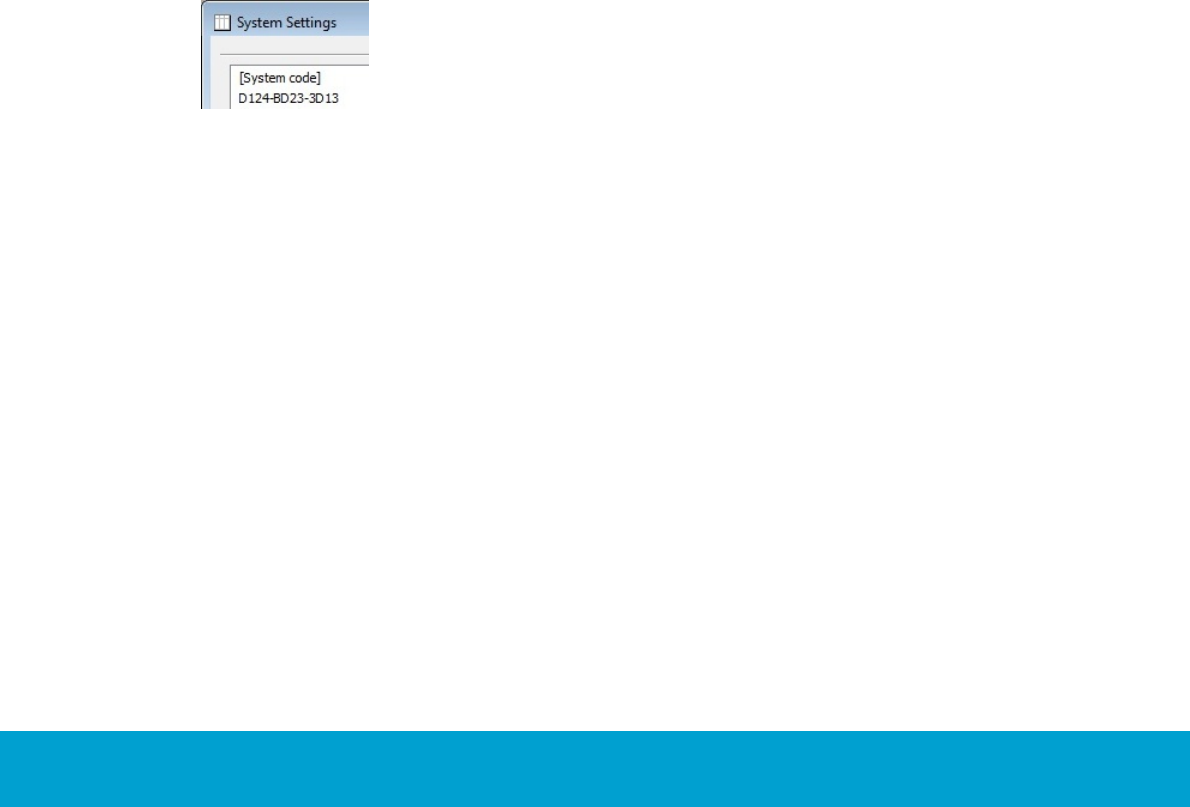
66
ASSA ABLOY Hospitality 66 3081 004-22
Appendix G: More about how the gateway finds
the server
Commissioning of gateways
If the gateway is located on the same subnet as the server, the gateway will locate
the server using announcement broadcast without any need for manual
configuration. However, the normal case is that the server and the gateway are
located on different subnets. The first gateway for each subnet requires help from
the DNS to locate the server.
Single server - commissioning of gateways with DNS
1. Add a DNS entry called timeloxserver and let its IP address be the address of
the application server to which the new gateway shall connect. The gateway
will then make a DNS query using the name timeloxserver and in this way get
the IP address of the server.
2. Connect the gateway to Ethernet and wait for it to appear in the SysMon
Online Network tree.
Multiple servers - commissioning of gateways with DNS
In the steps below, it is necessary to know the system code. To find it, double click
on System settings under Reports in the software navigation window.
Figure G1
1. For each application server, add a new DNS entry with the system name for
the concerned server. The system name is timelox_12-character system code
without dashes, e.g. timelox_D124BD233D13.
2. In order to find the correct server at first installation, the gateways must be
installed for one server at a time.
3. Let timeloxserver refer to the IP address of the first application server.
4. When all gateways have been installed for one server, the DNS entry for
timeloxserver must be changed to the IP address of the next server.
5. When all gateways for the last server have been installed, the timeloxserver
entry must be removed.

67
ASSA ABLOY Hospitality 66 3081 004-22
Commissioning of gateways without DNS
1. Connect one gateway to each subnet. Use the web interface for the gateway
to configure the IP address of the Visionline server. Note: This is only needed
for the first gateway for each subnet, since the other gateways on the same
subnet will retrieve the server IP address from the first one by announcement
broadcast.
2. Continue adding gateways. They will automatically obtain the IP address of
the application server from the gateways on the same subnet that are already
online with the server.
Switching to backup server
Single server - switching to backup server with DNS
1. Change the IP address of the timeloxserver entry in the DNS so it points to
the backup server. The gateways will then connect to the backup server if
the connection to the primary server is lost and cannot be re-established.
Multiple servers - switching to backup server with DNS
1. For the concerned application server, change the IP adress of the system
name entry in the DNS so it points to the backup server. The gateways will
then connect to the backup server if the connection to the primary server is
lost
and cannot be re-established.
Switching to backup server without DNS
1. Remove the primary server from the network.
2. Assign the IP address of the primary server to the backup server
OR
enter the IP address of the backup server in the web interface for
one gateway per subnet.
Note: It will take one hour after the primary server closes its sockets
until the rest of the gateways enable their announcement broadcast.
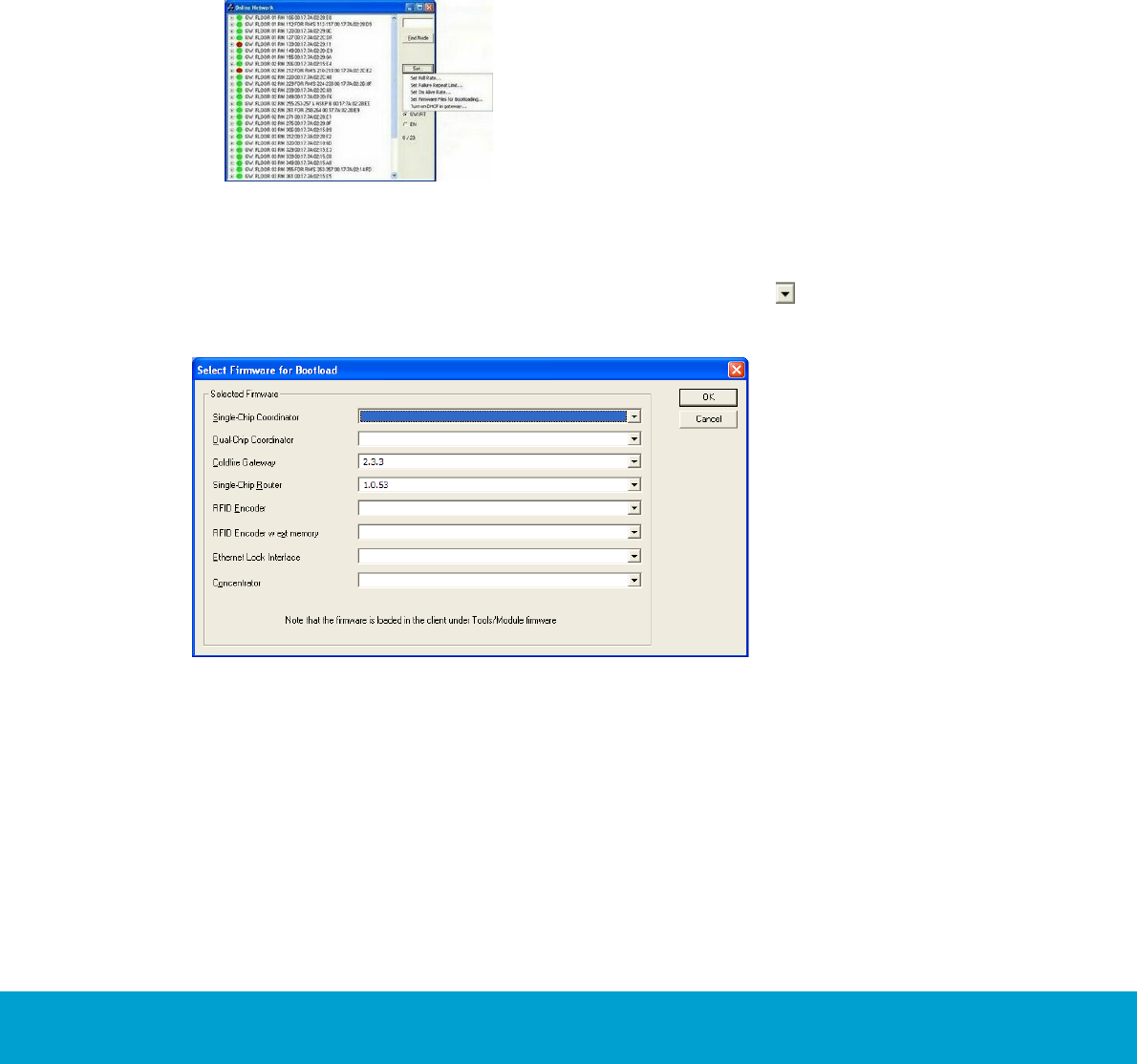
68
ASSA ABLOY Hospitality 66 3081 004-22
Appendix H: Firmware upgrade
If one or a few online devices should be upgraded, this is done from SysMon;
the applicable firmware must however first be saved to the database from
the Tools/Module firmware dialog in the client. For details about Tools/
Module firmware, see the appendix about firmware upgrade in the client
setup manual.
When the firmware that is applicable for an upgrade has been loaded into the
database, follow the steps below:
1. Click the Set button in the Online Network dialog and choose
Set Firmware Files for Bootloading.
Figure H1
2. The Select Firmware Files for Bootload will show the firmwares that
have been saved to the database. If several versions of the same firmware
have been saved to the database, click the applicable button if another
version should be chosen.
Figure H2

69
ASSA ABLOY Hospitality
E-mail: apac.hospitality@assaabloy.com
ASSA ABLOY Hospitality APAC
Phone: +65 6305 7670
ASSA ABLOY Hospitality EMEA
ASSA ABLOY Hospitality North America
Phone: +47 69 24 50 00
E-mail: emea.hospitality@assaabloy.com
E-mail: lam.hospitality@assaabloy.com
Phone: +1 972 907 2273
ASSA ABLOY Hospitality Latin America
E-mail: northam.hospitality@assaabloy.com
Phone: +52 55 36 40 12 00
www.assaabloyhospitality.com
